Root out friction in every digital experience, super-charge conversion rates, and optimize digital self-service
Uncover insights from any interaction, deliver AI-powered agent coaching, and reduce cost to serve
Increase revenue and loyalty with real-time insights and recommendations delivered to teams on the ground
Know how your people feel and empower managers to improve employee engagement, productivity, and retention
Take action in the moments that matter most along the employee journey and drive bottom line growth
Whatever they’re saying, wherever they’re saying it, know exactly what’s going on with your people
Get faster, richer insights with qual and quant tools that make powerful market research available to everyone
Run concept tests, pricing studies, prototyping + more with fast, powerful studies designed by UX research experts
Track your brand performance 24/7 and act quickly to respond to opportunities and challenges in your market
Explore the platform powering Experience Management
- Free Account
- Product Demos
- For Digital
- For Customer Care
- For Human Resources
- For Researchers
- Financial Services
- All Industries
Popular Use Cases
- Customer Experience
- Employee Experience
- Net Promoter Score
- Voice of Customer
- Customer Success Hub
- Product Documentation
- Training & Certification
- XM Institute
- Popular Resources
- Customer Stories
- Artificial Intelligence
- Market Research
- Partnerships
- Marketplace
The annual gathering of the experience leaders at the world’s iconic brands building breakthrough business results, live in Salt Lake City.
- English/AU & NZ
- Español/Europa
- Español/América Latina
- Português Brasileiro
- REQUEST DEMO
- Experience Management
- Market Research Surveys
- What is market research survey

Why use surveys?
Survey research methods.
- Conducting market research surveys
- Common mistakes with market research surveys?
The different types of survey methods
Survey tools for your survey method, what can businesses do with these types of surveys, how to write a research survey (free example templates), try qualtrics for free, types of market research surveys.
20 min read There are different types of survey research you can run, but the majority of research is conducted with just a handful of research survey methods. We explore what they are and how to use them.
What is a market research survey?
A market research survey is a way of getting feedback directly from the people who have the ultimate say in your organization’s success: your customers.
Unlike focus groups or interviews, market research surveys allow you to get detailed feedback at scale — from behaviors to overall experiences — and in a standardized format. Also, as the data is easy to process, you can quickly turn it into actionable insights .
Surveys are used to collect primary research, which means market research data that you collect yourself. The other type is secondary data, which is obtained from other sources, for example census data.
Surveys are among the most popular methods of primary market research, since they can be used to gather qualitative and quantitative research on market trends, and they can cover a huge range of respondents across your customer base. They’re also a format familiar to many people.
Get started with our free survey software
Surveys are ultimately about understanding your target audience, but they can go beyond your customer base. They can be taken by anyone — employees, potential future customers, and even those who don’t want to engage with your business (helping you to identify the ones that do).
However, a survey isn’t a stand-alone solution. It can work alongside other survey methods, such as focus groups, field studies, observation, and market analysis, to help you get a clear picture of your market and decide what direction to take.
But with all these different types of survey methods, and some being better than others in specific areas (e.g. data quality, collecting feedback), where should you start?
To get the best out of each survey research type, consider what you can invest in terms of:
- Time: How quickly do you need the survey research? Do you have time to conduct research?
- Money: Do you have the budget to invest in research overheads?
- Knowledge of analytics: Are you trained to interpret the collected data? If not, do you have a partner you can work with to get the insights you need?
- Research expertise: Do you have clearly defined problems or challenges that you want to explore or understand through surveys?
- Technology capability: Is your survey software up to the task of analyzing the data?
- Your audience’s response: Is it likely that your audience will respond? What survey types (online surveys, etc.) would they be most receptive to?
- Slow responses: Do you have a strategy in place to avoid low response rates?
Conducting market research surveys: best practices
Today’s market research industry is advancing rapidly, thanks in part to new technologies which make it easier to conduct market research, and offer more power and sophistication when it comes to analyzing your data.
Data-driven research is the standard across market research and other disciplines, and within the sector competition between brands is driving progress towards better and better market research tools. Beyond customer satisfaction, demographic questions and competitive analysis, today’s tools can dive deeper into your data, unearthing key drivers behind trends and even providing aggregated data on emotions and attitudes in customer feedback.
However, none of these technological advances can replace humans. To conduct market research successfully, you need to be able to combine tech with insight, intelligence and intuition, especially when you’re dealing directly with target customers, for example during a phone interview or when you’re approaching existing customers whose relationship to your brand needs to be maintained.
As we’ll see in this guide, market research can be used in a huge range of contexts, including brand tracking, customer experience research, employee experience programs, and of course product development. Whichever application you’re looking at, it’s essential to prepare thoroughly before sending out your surveys.
- Make sure your research question has been formulated and agreed by everyone involved in the project
- Develop a communications plan to maximize the chances of people engaging with your survey, including introductions, publicity, reminders and follow-up
- Consider using pre-testing before you fully launch your survey to thoroughly road-test it and iron out any issues
- Close the loop – after the study is complete and actions have been taken, let participations know how their contribution helped
- Consider a research panel for future surveys, either one you’ve built yourself or one managed by a third party provider
What are some common mistakes with market research surveys?
With the right survey tools and appropriate support from your survey platform provider, everything should go smoothly, even if you’re not an expert at doing your own market research. However, there are a few things to watch out for.
Choosing the wrong people to survey
Figuring out who you’re going to survey in the first place may seem like an obvious first step and not one you need to spend much time on. But in fact it’s possible to get it wrong, survey the wrong people and end up running a market research study with unreliable data. This is sometimes called ‘sample framing error’
Getting your sample size wrong
If your sample is too small, you run the risk of getting a sample group that doesn’t adequately reflect your target population. This can throw your entire market research survey off course. But if the sample is too large, you spend time and money on research that doesn’t add significant value. Have a look at our sample size calculator to help determine the right sample size for your market research surveys.
Using the wrong kinds of analysis
Do you know your conjoint analysis from your T-test? Understanding the basic types of statistical tests you can use to analyze market research survey data is essential if you’re not using a survey tool with built-in analytics. You’ll need to match the kind of data you’re collecting to the analysis method you choose in order to get accurate insights from your market research surveys.
Writing confusing survey questions
Survey questions aren’t like the questions we use in everyday speech, or even like the ones we ask in formal writing. They need to be highly specific, include appropriate context, and be free of any kind of descriptive or persuasive element that might introduce bias. For a primer on writing great market research survey questions, see our guide to great survey questions
You should choose your survey method based on your target audience, distribution capabilities, and the questions you want answered. For example, interviews are far more personal and explorative by nature, but they’re difficult and costly to scale. Online surveys, on the other hand, have far greater reach and much more affordable — but you lose the opportunity to connect with respondents. Let’s go through the different types and how you can use them.

Online surveys
Online surveys are accessible to any participant across the globe, providing they have an internet connection. You can create online surveys using survey platforms and distribute them via email using a link, or respondents can go directly to the online survey and complete it.
Paper surveys
Paper surveys (or written surveys) are printed surveys filled in by hand. This method works well if respondents have enough time (and incentive) to complete the survey, and the researcher is happy to manually collect the data before collating and interpreting the answers.
Mail surveys
Mail surveys provide exceptional geographical coverage as they can be printed off and sent via the post. However, as recipients need to return the surveys for counting, it’s recommended that you include a pre-paid returns envelope in the original envelope, otherwise you’ll have lower response rates.
Telephone surveys
Telephone surveys involve asking respondents a series of questions over the phone. It’s a popular survey method as it’s convenient for researchers and doesn’t require a lot of capital to do. However, researchers may need to invest time to set up interviews with participants and take notes during the process.
In-person interviews / face-to-face surveys
In-person interviews and face-to-face surveys are great opportunities to get more insightful and valuable responses from participants. You can quickly find out why they think and feel the way that they do, providing an unbiased view of a subject or issue. However, like telephone surveys, they require a lot of time to set up and gather data.
Panel surveys
Panel surveys use a pre-selected group of people as the sample, so that the research can be carried out quickly. It presents a happy medium between the speed and quality of research data.
Based on the type of survey method you choose, here are the types of tools you need and can use for each:
A good internet connection is required for participants to access online surveys, though mobile devices data plans mean that most people can connect to the internet easily.
A good survey software platform is needed to give you full functionality and flexibility, so your online surveys can be customized and optimized. However, businesses can get more for their money with a survey software system that does more for the company.
For example, the Qualtrics XM Platform™ is a best-of-breed experience operating system for experience management. It brings all your operational and experience data together from across the organization to help create and improve experiences for employees, customers, prospects and more. It automatically updates records, has an in-built analytics engine and can handle research projects, from start to finish, in a few clicks.
All you need are paper, ink, pens and clipboards — but due to environmental and sustainability concerns, particularly paper waste and ink pollution, you may want to opt for a more digitized solution.
For mail surveys, the resources and concerns are the same as with paper surveys — but the main difference is distribution.
Ultimately, you need a reliable postal service that can deliver to your target audience. It also becomes costly if you want to include international respondents.
As long as you have good connectivity and network coverage, telephone surveys are straightforward. That said, survey calls can last a long time, so if you plan to include international audiences, ensure you can afford the calling costs.
The only requirement for in-person interviews and face-to-face surveys is a venue to hold them in.
These require participants to be available at the time of the research. Traditionally, third-party generated research panels are available as a service to companies that don’t have access to the audiences they need.
The surveys we explored can be used for four purposes in any business:
1. Market surveys
These help you understand who’s out there, what they want, and how you can best meet their needs.
Market description surveys
Purpose: to determine the size and relative market share of the market. Such studies provide key information about market growth, competitive positioning, and tracking share of the market .
Market profiling / segmentation surveys
Purpose: to identify who the customers are , who they are not, and why they are or are not your customers. This is often a descriptive market segmentation and market share analysis.
Stage in the purchase process / tracking surveys
Where is the customer in the adoption process? This information shows Market Awareness – Knowledge – Intention – Trial – Purchase – Repurchase of the product.
2. Customer experience surveys
This kind of survey helps you put yourself in the customer’s shoes and look at your business from their perspective.
Customer intention – purchase analysis surveys
Purpose: Directed at understanding the current customer. What motivates the customer to move from interest in the product to actual purchase? This is key to understanding customer conversion, commitment, and loyalty .
Customer attitudes and expectations surveys
Purpose: Used to direct advertising and improve customer conversion, commitment, and loyalty. Does the product meet customer expectations ? What attitudes have customers formed about the product and/or company?
Learn how you can set up and run customer attitudes and use surveys
Sales lead generation surveys
Purpose: Sales lead generation surveys are for
- assuring timely use and follow-up of sales leads
- qualifying sales leads (thereby saving valuable sales force time)
- providing more effective tracking of sales leads
Customer trust / loyalty / retention analysis surveys
Purpose: Especially helpful for high-priced consumer goods with a long decision and purchase processes (time from need recognition to purchase), this type of study explores the depth of consumer attitudes formed about the product and/or company.
Salesforce effectiveness surveys
Purpose: A combination of measures that focus on the sales activities, performance, and effectiveness in producing the desired and measurable effect or goal. Often measured as a 360-degree survey completed by the salesperson, the client (evaluating the sales call), and the supervisor responsible for evaluating the salesperson.
Customer service surveys
Purpose: Akin to customer satisfaction surveys, customer service surveys instead focus in detail on the actual customer service that was received, the process involved in receiving that service, and the evaluation of the participants in the service process.
Customer service representative (CSR) surveys
Purpose: CSRs often exhibit frustration, burnout, and high turnover . Surveys focus on CSR retention, reducing costs, and increasing the quality of customer relationships.
Attitudes, burnout, turnover, and retention: CSRs hold attitudes that reflect on their job-related activities including:
- the allocation of time
- solutions to customer needs
- how to improve their job
- best practices
- how well internal departments help customers
3. Product surveys
As part of product development, surveys help you find out what features, benefits and attributes appeal most to your customers, and how best to package your product, experience or service.
New product, service or experience concept analysis surveys
Purpose: Concept test studies are appropriate in the initial screening of new product concepts . Likes and dislikes about the concept and evaluation of acceptability and likelihood of purchase are especially useful measures.
Concept optimization, demand estimation, and cost analysis surveys (conjoint analysis)
Purpose: Determines an optimal bundle of features and benefits, and estimates associated demand. This kind of survey develops market share estimates of market potential for the alternative potential products.
Habits and practices, or attitude and usage surveys
Purpose: Directed at understanding usage situations, including how, when, and where the product is used. Habits and practices studies sometimes include a real or virtual pantry audit. Attitude and usage studies are used to understand consumer attitudes towards the product category and to life in general. They also look at product and brand usage, including how, when and where the product is used.
Product satisfaction surveys (attribute, features, promised benefits)
Purpose: Evaluation of the product’s promised bundle of benefits (both tangible and image). Are expectations created for the product by advertising, packaging , and the product appearance fulfilled by the product?
Competitive benchmarking surveys
Purpose: A “best practices” study of “how does the market view us relative to the competition?” Competitive positioning analyses often compare the attributes and benefits that make up the product using multidimensional scaling. These analyses also include an evaluation of key competitors, looking at the same KPIs and attributes as product satisfaction surveys.
Sales forecasting and market tracking surveys
Purpose: Sales forecasting and market tracking studies can include expert opinion (experts estimate the market), judgmental bootstrapping (expert-based rules describing how to use available secondary market information), conjoint analysis (estimation of consumer intentions based on product attributes that are important in the decision), and intentions evaluations (consumer self-reported intentions of future purchases).
Price setting surveys and elasticity of demand analysis
Purpose: Price surveys estimate the elasticity of demand and show optimal price points, including prices too low or too high. Price surveys may estimate the demand for different product or service segments, or different usage situations.
4. Brand surveys
A survey can help you understand how consumers perceive your brand and what values and ideas they associate with it. You can explore what value your brand has and whether people would choose you over competitors in your market niche.
Brand equity analysis surveys
Purpose: What is the psychological value that a brand holds in the marketplace? Brand equity is a composite of brand awareness , brand quality, brand associations, and brand loyalty measures.
Advertising value identification and analysis surveys
Purpose: Advertising value analysis focuses on mapping the hierarchical attributes, benefits, and values that are associated with and portrayed by an advertisement. Means-end analysis is often part of this type of study.
Advertising message effectiveness surveys (media and message)
Purpose: Message effectiveness testing identifies the impressions, feelings, and effectiveness in moving the respondent to a desired goal (increased awareness, more product information, trial, repeat purchase).
Once you know the right type of survey to run, the next step is to write a survey that your respondents will love to take!
Survey methods can be used to help collect data on real business issues and help you answer questions. Qualtrics supports customer surveys on every channel, at every journey stage to get you answers for more informed decisions.
We’ve put together a range of survey example templates that you can use for free to help you get started:
- Employee satisfaction survey template
- Employee exit survey template
- Customer satisfaction (CSAT) survey template
- Ad testing survey template
- Brand awareness survey template
- Product pricing survey template
- Product research survey template
- Employee engagement survey template
- Customer service survey template
- NPS survey template
- Product package testing survey template
- Product features prioritization survey template
In addition, for large-scale research studies, Qualtrics offers market research services to help with everything from questionnaire design and survey methods, to implementation and analysis.
Related resources
Post event survey questions 10 min read, best survey software 16 min read, close-ended questions 7 min read, survey vs questionnaire 12 min read, response bias 13 min read, double barreled question 11 min read, likert scales 14 min read, request demo.
Ready to learn more about Qualtrics?

- Pollfish Survey Platform
- Pollfish Blog
- Get Fast Survey Responses
- Survey Guides
Market Research Survey: The Complete Guide

This process involves gathering primary (self-conducted) and secondary (information already researched and made available) sources, to fully assess how a business will fare within a particular market and audience.
A market research survey is typically a source of primary information that businesses can use as part of their market research campaigns. It can also exist as a secondary source, in which case, its studies and results are published online or in a print publication.
This article will take a close look at the market research survey, so that you can use it to the optimum benefit for your business.
What Can you Achieve with Market Research?
A market research survey, as its name entails, is used for research purposes. Before we dive into all the aspects of this survey, it is apt to learn how you can use market research to your full advantage.
Market research is critical for a variety of purposes, including marketing , advertising , and branding campaigns.
Aside from providing data-based support for these macro purposes, market research gains you invaluable insight into particular markets. For example, you may consider running a research campaign for the retail market . Market research will help you gather all the relevant information pertaining to this specific market.
Aside from retail, you can conduct market research in a number of verticals, including ecommerce , technology, real estate and many others.
There are plenty of other applications for market research. Here are some of the ways to use market research to your advantage:
- Observe data to prepare for challenges in advance
- Gauge the demand for your product or service
- Learn key market trends and staples
- Discover how your competitors are winning or losing
- Uncover your target market’s desires, preferences, aversions and thoughts
The final point is remarkably crucial for market research and for generally keeping your business afloat. And so, we’ll now dig deep into the market research survey, as this tool is especially useful for this purpose.
Defining a Market Research Survey
This tool is the most commonly used market research method — and for good reason. A market research survey allows you to gather data on your target market. Moreover, it allows businesses to do so by accessing any insights they need, as long as they form corresponding questions to their investigation.
Surveys have a far-reaching history, as they date back to ancient civilizations such as Greece and Rome. There was a surge in survey use in 1930s America, in which the government sought to understand the economic and social state of the nation.
Surveys have taken up a variety of forms, including analog forms, such as paper and mail-in formats .
Telephone surveys were the medium of choice for survey research during the 1960s-90s. But, as technological advancements would have it, those have declined in usefulness as well.
In the present day, surveys are conducted online, particularly through the use of designated software platforms. This type of software has paved the way for easy access to primary research.
Businesses can use online survey software and tools and to carry out all their survey research (save for creating the screener and questions). Many such tools available both allow you to build surveys along with deploying them.
To reiterate, market research surveys are powerful tools, in that they empower businesses to ask any question they choose to better understand their market and consumer base. They also can offer key insights into competitors.
The Components of a Market Research Survey

This tool contains two major components: the screener and the questionnaire . These form the bulk of the insights your primary research will gather.
There are also two auxiliary components to incorporate to make your survey research successful. These include the call-out (introduction) and the thank you message (conclusion).
Unlike the essential components, the need to use these will vary based on your survey deployment method and campaign. For example, an emailed survey won’t require a call-out, as the email itself serves this purpose.
A web or mobile survey, on the other hand, will need a call-out to get the attention of your respondents.
Here is a break-down of each component, beginning with the essential elements:
- These conditions often deal with demographics, which is incredibly important, as you would need to first and foremost, survey your target market. The screener will ensure it is only your target market that takes part in the survey.
- The screener is often comprised of 2-3 questions.
- The questionnaire should ask all the necessary questions you need for a particular campaign or sub-campaign. Or, if used in a preliminary stage of your market research, they can deal with questions particularly designed to segment your target market.
- If respondents are contacted via email, the call-out is in the email’s body, inviting participants to take it, listing why it’s important, its length and what it’s used for.
- If the survey exists within a website (either as a banner, or button), the call-out is the clickable element itself (the button/banner to the survey). It too should explain the survey to respondents.
- If the survey is on a website/app, the call-out has to be visible and attractive enough for users to notice it and click on it.
- The survey often routes users to another page with a thank you message.
- It’s important, as it lets participants know that their survey has in fact been submitted.
How to Create a Market Research Survey

Here are a few steps to take into consideration when starting on a market research survey project.
Step 1: Find a topic your business needs to learn more about.
This is particularly important if it is a topic that has little to no secondary sources. In this case, opting for a survey is the best way to learn more about it firsthand, from the people who matter most: your target market. Pay attention to any problems your business may experience, as surveys should help resolve them.
Step 2: Consider the topic in regards to your target market
When you’ve narrowed down a problem or two, think about your target market. Do you know who constitutes it? If yes, tailor your survey topic into a subtopic that they’ll be most likely to respond to. For example, if your target market is middle-aged men who watch sports, consider whether your problem/topic will be relevant to them.
If you don’t know your target market, you should conduct some secondary research about it first, then perform market segmentation (surveys can help on this front too).
Step 3: Find the larger application of the survey campaign
Now that you’ve settled on a topic/problem and decided on whether it’s fitting for your target market, consider what the parent campaign of the survey would be. Let’s hypothetically say your topic is related to a product. Would a survey on that topic benefit a branding campaign like finding your next slogan? Would it be better suited to settle on a theme for an advertising campaign?
Once you find the most appropriate application or macro campaign to house the survey, your market research will be organized and your survey will be better set up for success.
Step 4: Calculate your margin of error
A margin of error , in simple terms, is a measurement of how effective your survey will be. Expressed as a percentage, it measures the difference between survey results and the population value.
You need to measure this unit, as surveys represent a large group of people, but are made up of a much smaller group. Therefore, the larger the margin of error, the less accurate the opinions of the survey represent an entire population.
Step 5: Create your survey(s)
Now that you’ve calculated the margin of error, start creating your campaign. Decide on how many surveys you would need, in regard to your margin of error and your market research needs.
Start with a broader topic and get more specific in each question. Or, create multiple surveys focused on different but closely related subtopics to your main topic.
Send out your surveys through a trusted survey platform.
Questions to Ask for Various Campaigns
The steps laid out above are part of a simple procedure in developing a market research survey. However, there is much more to these steps, especially that of creating the survey.
Namely, you would need the correct set of questions, as they are the lifeblood of a survey. With so many different survey research campaigns and purposes, brainstorming questions can seem almost counterintuitive.
To avoid information overload and any confusion that creating a survey may incite, review the below question examples. They are organized per campaign type, so you can discern which questions are most suitable for which corresponding research purpose.
Questions for Branding
Branding campaigns include efforts that build the identity of your business; this includes gathering data-backed ideas on logos, imagery, messaging and core themes surrounding your brand. You can use these when embarking on a new campaign, revamping an existing one or when you’re looking to change your brand’s reputation and style.
- Which of these brands do you know?
- What do you like most/least about this brand?
- Which idea is more important? (Use an idea behind setting up your brand’s image/style)
- Which images do you find the most inspiring? (To compare images you’ll use in your marketing/ definitive to your brand)
- What do you like about [brand]? (Can be open-ended)
Questions for Advertising
Using market research for advertising will help you obtain ideas for new advertising campaigns, testing already established campaign ideas and predicting the success of new ones.
- How would you rate the motivating power of this ad?
- Which of the following ads resonate the most with you?
- Do you remember this ad? (Name and image/video of a popular ad within your industry)
- How do you feel after watching this ad?
- What kind of use do you think this product/service produces?
Questions for Comparing Yourself with Competitors
Studying your competitors is often associated with secondary research, but you can gain intelligence on this topic through your own survey research. The great thing about surveys is that you don’t have to focus on one competitor when managing these surveys.
- How often do you use this product/service?
- Which brand do you use for this product/service? (Include one open-ended answer).
- Which of the following products (same kind, different brand) do you find the most useful?
- What about [competitor product] would you like to see change?
- Which brand has improved your life? (Include one open-ended question).
Questions for Market Segmentation

This application is possibly the most challenging, as it involves understanding who your target market already is, then further segmenting it. We understand coming to terms with your target market first, before narrowing it any further down.
Here is how to segment your target market; you’ll notice that the questions are much more granular than the typical questions associated with each topic. (Ex: demographics typically ask for race, age, gender, income, etc).
- Demographic segmentation: Which of the following groups do you identify with most closely? (It can involve anything from music, to shopping habits, to lifestyle choices)
- Geographic segmentation: Which of the following areas do you typically spend time in to make physical purchases?
- Psychographic segmentation: How do you feel about retailers who test their products on animals?
- Behavioral segmentation: How often do you buy this kind of product?
- Sentimental segmentation: How do the following [practices, images, actions] make you feel?
Securing the Most Benefits Out of Your Market Research Survey
As we can deduce from this guide, the market research survey is a critical tool for market research . There is so much to discover about your industry, competitors and chiefly, your customers. But before making any hasty decisions, it is vital to peruse all your research documents, not just the primary research ones, such as surveys.
When you combine primary and secondary research sources, you’re setting up any business move for greater success.
That’s because market research involves studying more than one source. It may appear daunting, but with the right tools, you can design better products, innovate on existing products, appeal to a wider audience and gain more revenue from your marketing efforts.
Thus, pair your market research survey with other research means for a lucrative market research campaign. Knowledge truly is power.
Frequently asked questions
What is a market research survey.
A market research survey is a survey used for conducting primary market research and is the most commonly used market research method. Market research surveys help you understand your target market, gathering data necessary to make informed decisions on content creation, product development, and more.
What are the components of a market research survey?
There are 4 major components in a market research survey. First, we have the callout to get digital visitors to participate in a survey. Next is the screener which determines who is eligible to take the survey based on their demographics information and answers to screening questions. Then, there is the questionnaire—-- this is the heart of the survey, containing a set of open-ended or closed-ended questions. Lastly, there’s the callout. This introduces the survey to respondents. Next, there’s the thank you message. This acts as the conclusion to the survey.
How can you create a market research survey?
Creating a market research survey starts with identifying the topics your business needs to learn more about. Next, you consider topics within the context of your target market and find the larger application of the survey campaign. Calculate your margin of error and then create your survey using online software.
What types of questions should you ask on your market research survey?
You can ask branding related questions to gather information on how your identity of your business is perceived. You can also ask questions that spark ideas for new advertising campaigns. To supplement your secondary research on competitors, ask questions about your business’s place in the industry. Questions can also be used for market segmentation. These are questions on demographic, geographic, psychographic, behavioral and sentimental topics.
How can you get the most benefits out of your market research survey?
You can get the most out of your market research survey by using the correct online survey platform-- one with specific audience targeting for real consumers, radius targeting and quality screening questions-- you’ll get relevant answers from the right audience.
Do you want to distribute your survey? Pollfish offers you access to millions of targeted consumers to get survey responses from $0.95 per complete. Launch your survey today.
Privacy Preference Center
Privacy preferences.
Business growth
Marketing tips
How to conduct your own market research survey (with example)

After watching a few of those sketches, you can imagine why real-life focus groups tend to be pretty small. Even without any over-the-top personalities involved, it's easy for these groups to go off the rails.
So what happens when you want to collect market research at a larger scale? That's where the market research survey comes in. Market surveys allow you to get just as much valuable information as an in-person interview, without the burden of herding hundreds of rowdy Eagles fans through a product test.
Table of contents:
What is a market research survey?
Market surveys are what's known as "primary research"—that is, information that the researching company gathers firsthand. Secondary research consists of data that another organization gathered and published, which other researchers can then use for their own reports. Primary research is more expensive and time-intensive than secondary research, which is why you should only use market research surveys to obtain information that you can't get anywhere else.
A market research survey can collect information on your target customers':
Experiences
Preferences, desires, and needs
Values and motivations
The types of information that can usually be found in a secondary source, and therefore aren't good candidates for a market survey, include your target customers':
Demographic data
Consumer spending data
Household size
Why conduct market research?
Here are some examples of how market research surveys can be used to fill a wide range of knowledge gaps for companies:
A B2B software company asks real users in its industry about Kanban board usage to help prioritize their project view change rollout.
A B2C software company asks its target demographic about their mobile browsing habits to help them find features to incorporate into their forthcoming mobile app.
A printing company asks its target demographic about fabric preferences to gauge interest in a premium material option for their apparel lines.
A wholesale food vendor surveys regional restaurant owners to find ideas for seasonal products to offer.
Primary vs. secondary market research
Market surveys are what's known as "primary research"—that is, information that the researching company gathers firsthand. Secondary research consists of data that another organization gathered and published, which other researchers can then use for their own reports.
Primary research is more expensive and time-intensive than secondary research, which is why you should only use market research surveys to obtain information that you can't get anywhere else.
If you've exhausted your secondary research options and still have unanswered questions, it's time to start thinking about conducting a market research survey.
6 types of market research survey
Depending on your goal, you'll need different types of market research. Here are six types of market research surveys.
1. Buyer persona research
A buyer persona research survey will help you learn more about things like demographics, household makeup, income and education levels, and lifestyle markers. The more you learn about your existing customers, the more specific you can get in targeting potential customers. You may find that there are more buyer personas within your user base than the ones that you've been targeting.
2. Sales funnel research
With a sales funnel research survey, you can learn about potential customers' main drivers at different stages of the sales funnel. You can also get feedback on how effective different sales strategies are. Use this survey to find out:
How close potential buyers are to making a purchase
What tools and experiences have been most effective in moving prospective customers closer to conversion
3. Customer loyalty research
The demographics of your most loyal customers
What tools are most effective in turning customers into advocates
What you can do to encourage more brand loyalty
4. Branding and marketing research
The Charmin focus group featured in that SNL sketch is an example of branding and marketing research, in which a company looks for feedback on a particular advertising angle to get a sense of whether it will be effective before the company spends money on running the ad at scale. Use this type of survey to find out:
Whether a new advertising angle will do well with existing customers
Whether a campaign will do well with a new customer segment you haven't targeted yet
What types of campaign angles do well with a particular demographic
5. New products or features research
What features they wish your product currently had
What they think of a particular product or feature idea
6. Competitor research
Whether your competitors have found success with a buyer persona you're not targeting
Information about buyers for a product that's similar to one you're thinking about launching
Feedback on what features your competitors' customers wish their version of a product had
How to write and conduct a market research survey
Once you've narrowed down your survey's objectives, you can move forward with designing and running your survey.
Step 1: Write your survey questions
A poorly worded survey, or a survey that uses the wrong question format, can render all of your data moot. If you write a question that results in most respondents answering "none of the above," you haven't learned much.
Categorical questions
Also known as a nominal question, this question type provides numbers and percentages for easy visualization, like "35% said ABC." It works great for bar graphs and pie charts, but you can't take averages or test correlations with nominal-level data.
Multiple choice: Use this type of question if you need more nuance than a Yes/No answer gives. You can add as many answers as you want, and your respondents can pick only one answer to the question.
Checkbox: Checkbox questions add the flexibility to select all the answers that apply. Add as many answers as you want, and respondents aren't limited to just one.
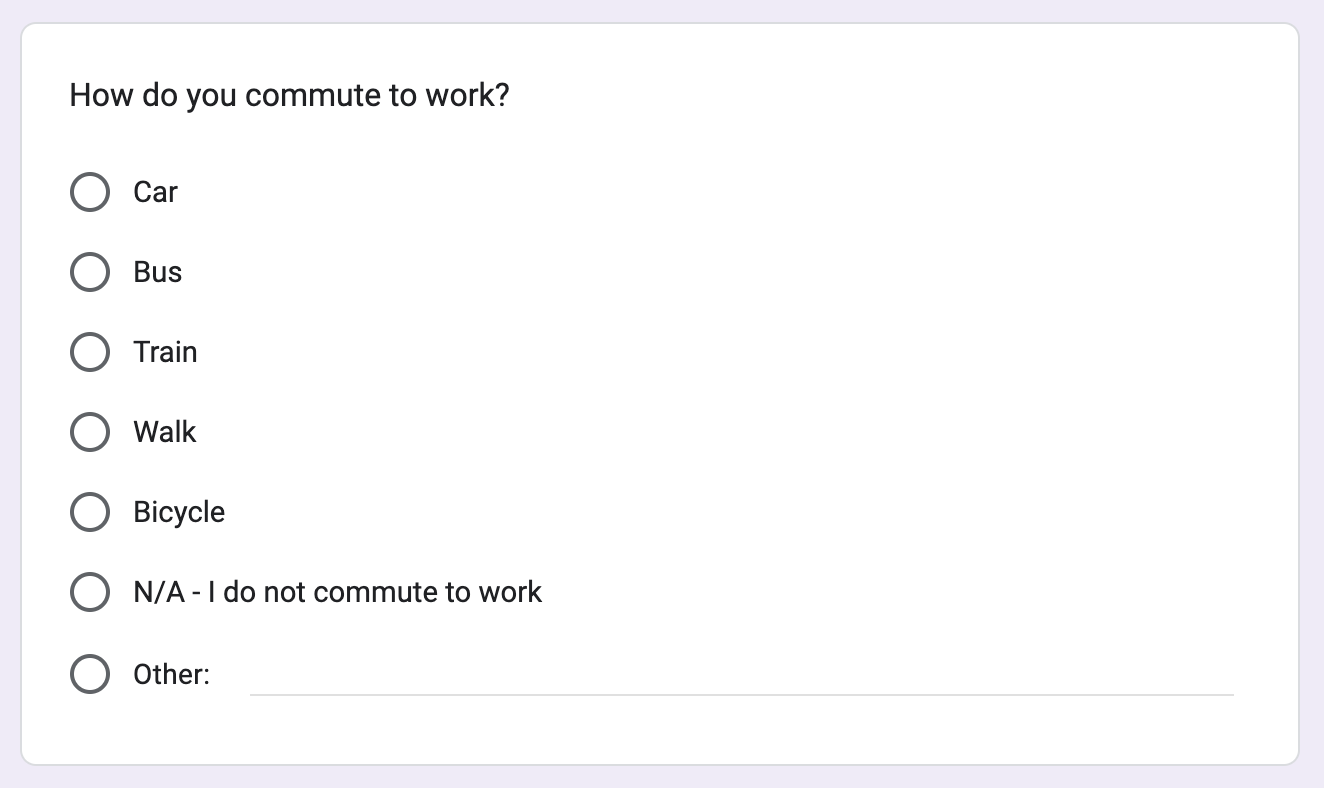
Ordinal questions
This type of question requires survey-takers to pick from options presented in a specific order, like "income of $0-$25K, $26K-$40K, $41K+." Like nominal questions, ordinal questions elicit responses that allow you to analyze counts and percentages, though you can't calculate averages or assess correlations with ordinal-level data.
Dropdown: Responses to ordinal questions can be presented as a dropdown, from which survey-takers can only make one selection. You could use this question type to gather demographic data, like the respondent's country or state of residence.
Ranking: This is a unique question type that allows respondents to arrange a list of answers in their preferred order, providing feedback on each option in the process.
Interval/ratio questions
For precise data and advanced analysis, use interval or ratio questions. These can help you calculate more advanced analytics, like averages, test correlations, and run regression models. Interval questions commonly use scales of 1-5 or 1-7, like "Strongly disagree" to "Strongly agree." Ratio questions have a true zero and often ask for numerical inputs (like "How many cups of coffee do you drink per day? ____").
Ranking scale: A ranking scale presents answer choices along an ordered value-based sequence, either using numbers, a like/love scale, a never/always scale, or some other ratio interval. It gives more insight into people's thoughts than a Yes/No question.
Matrix: Have a lot of interval questions to ask? You can put a number of questions in a list and use the same scale for all of them. It simplifies gathering data about a lot of similar items at once.
Example : How much do you like the following: oranges, apples, grapes? Hate/Dislike/Ok/Like/Love
Textbox: A textbox question is needed for collecting direct feedback or personal data like names. There will be a blank space where the respondent can enter their answer to your question on their own.
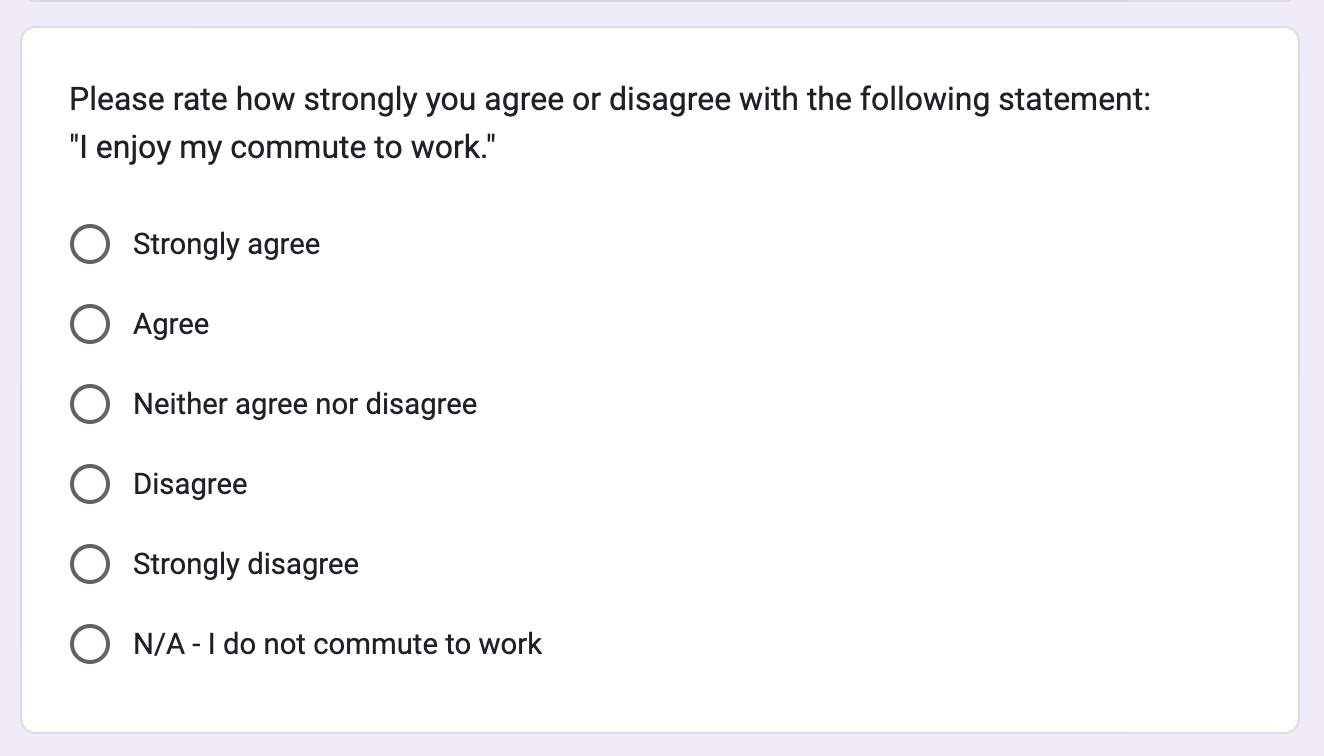
Step 2: Choose a survey platform
Most survey apps today look great on mobile, but be sure to preview your survey on your phone and computer, at least, to make sure it'll look good for all of your users.
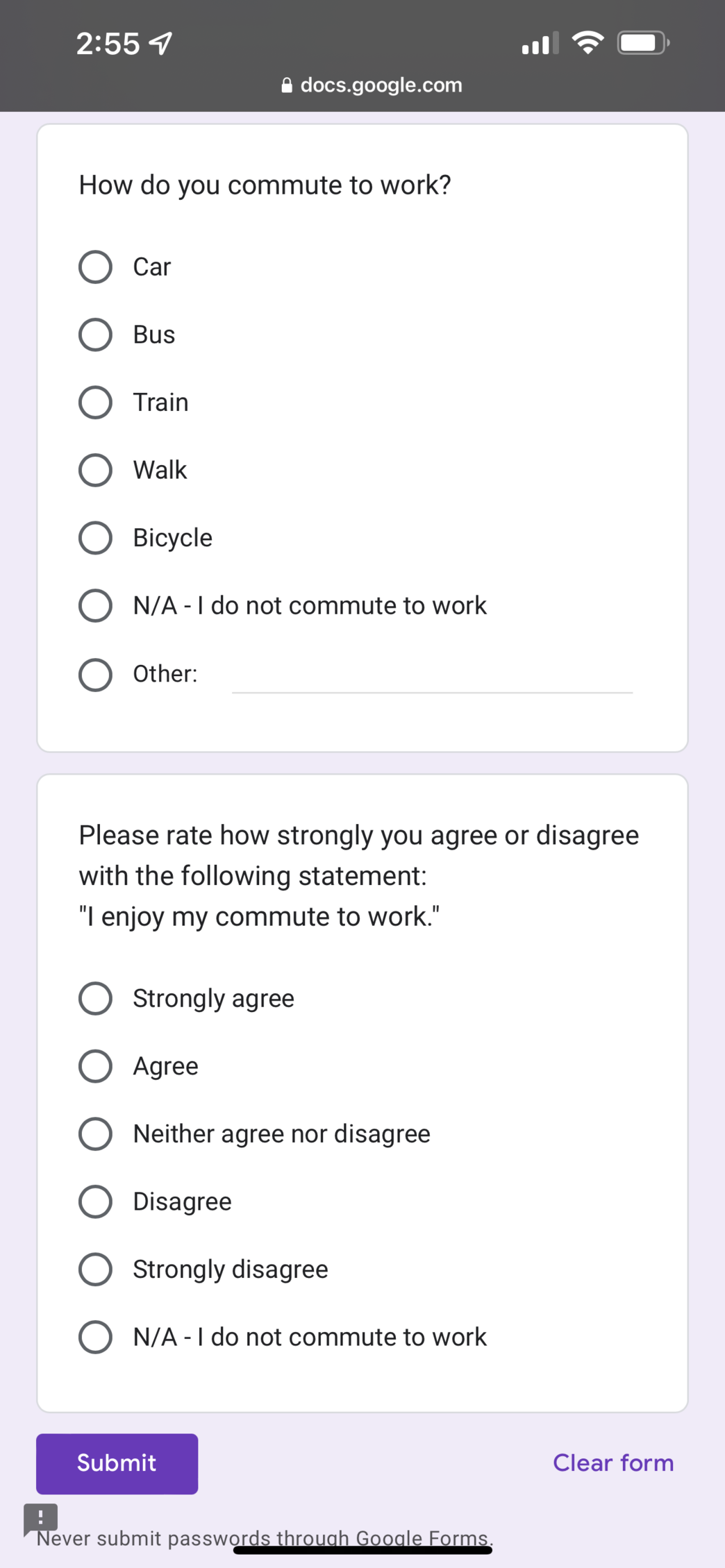
If you have the budget, you can also purchase survey services from a larger research agency.
Step 3: Run a test survey
Before you run your full survey, conduct a smaller test on 5%-10% of your target respondent pool size. This will allow you to work out any confusing wording or questions that result in unhelpful responses without spending the full cost of the survey. Look out for:
Survey rejection from the platform for prohibited topics
Joke or nonsense textbox answers that indicate the respondent didn't answer the survey in earnest
Multiple choice questions with an outsized percentage of "none of the above" or "N/A" responses
Step 4: Launch your survey
If your test survey comes back looking good, you're ready to launch the full thing! Make sure that you leave ample time for the survey to run—you'd be surprised at how long it takes to get a few thousand respondents.
Even if you've run similar surveys in the past, leave more time than you need. Some surveys take longer than others for no clear reason, and you also want to build in time to conduct a comprehensive data analysis.
Step 5: Organize and interpret the data
Tips for running a market research survey.
You know the basics of how to conduct a market research survey, but here are some tips to enhance the quality of your data and the reliability of your findings.
Find the right audience: You could have meticulously crafted survey questions, but if you don't target the appropriate demographic or customer segment, it doesn't really matter. You need to collect responses from the people you're trying to understand. Targeted audiences you can send surveys to include your existing customers, current social media followers, newsletter subscribers, attendees at relevant industry events, and community members from online forums, discussion boards, or other online communities that cater to your target audience.
Focus questions on a desired data type: As you conceptualize your survey, consider whether a qualitative or quantitative approach will better suit your research goals. Qualitative methods are best for exploring in-depth insights and underlying motivations, while quantitative methods are better for obtaining statistical data and measurable trends. For an outcome like "optimize our ice cream shop's menu offerings," you may want to find out which flavors of ice cream are most popular with teens. This would require a quantitative approach, for which you would use categorical questions that can help you rank potential flavors numerically.
Establish a timeline: Set a realistic timeline for your survey, from creation to distribution to data collection and analysis. You'll want to balance having your survey out long enough to generate a significant amount of responses but not so long that it loses relevance. That length can vary widely based on factors like type of survey, number of questions, audience size, time sensitivity, question format, and question length.
Market research survey campaign example
Let's say you own a market research company, and you want to use a survey to gain critical insights into your market. You prompt users to fill out your survey before they can access gated premium content.
Survey questions:
1. What size is your business?
<10 employees
11-50 employees
51-100 employees
101-200 employees
>200 employees
2. What industry type best describes your role?
3. On a scale of 1-4, how important would you say access to market data is?
1 - Not important
2 - Somewhat important
3 - Very important
4 - Critically important
4. On a scale of 1 (least important) to 5 (most important), rank how important these market data access factors are.
Accuracy of data
Attractive presentation of data
Cost of data access
Range of data presentation formats
Timeliness of data
5. True or false: your job relies on access to accurate, up-to-date market data.
Survey findings:
63% of respondents represent businesses with over 100 employees, while only 8% represent businesses with under 10.
71% of respondents work in sales, marketing, or operations.
80% of respondents consider access to market data to be either very important or critically important.
"Timeliness of data" (38%) and "Accuracy of data" (32%) were most commonly ranked as the most important market data access factor.
86% of respondents claimed that their jobs rely on accessing accurate, up-to-date market data.
Insights and recommendations: Independent analysis of the survey indicates that a large percentage of users work in the sales, marketing, or operations fields of large companies, and these customers value timeliness and accuracy most. These findings can help you position future report offerings more effectively by highlighting key benefits that are important to customers that fit into related customer profiles.
Market research survey example questions
Your individual questions will vary by your industry, market, and research goals, so don't expect a cut-and-paste survey to suit your needs. To help you get started, here are market research survey example questions to give you a sense of the format.
Yes/No: Have you purchased our product before?
Multiple choice: How many employees work at your company?
<10 / 10-20 / 21-50 / 51-100 / 101-250 / 250+
Checkbox: Which of the following features do you use in our app?
Push notifications / Dashboard / Profile customization / In-app chat
Dropdown: What's your household income?
$0-$10K / $11-$35K / $36-$60K / $61K+
Ranking: Which social media platforms do you use the most? Rank in order, from most to least.
Facebook / Instagram / Twitter / LinkedIn / Reddit
Ranking scale: On a scale of 1-5, how would you rate our customer service?
1 / 2 / 3 / 4 / 5
Textbox: How many apps are installed on your phone? Enter a number:
Market research survey question types
Good survey apps typically offer pre-designed templates as a starting point. But to give you a more visual sense of what these questions might look like, we've put together a document showcasing common market research survey question types.
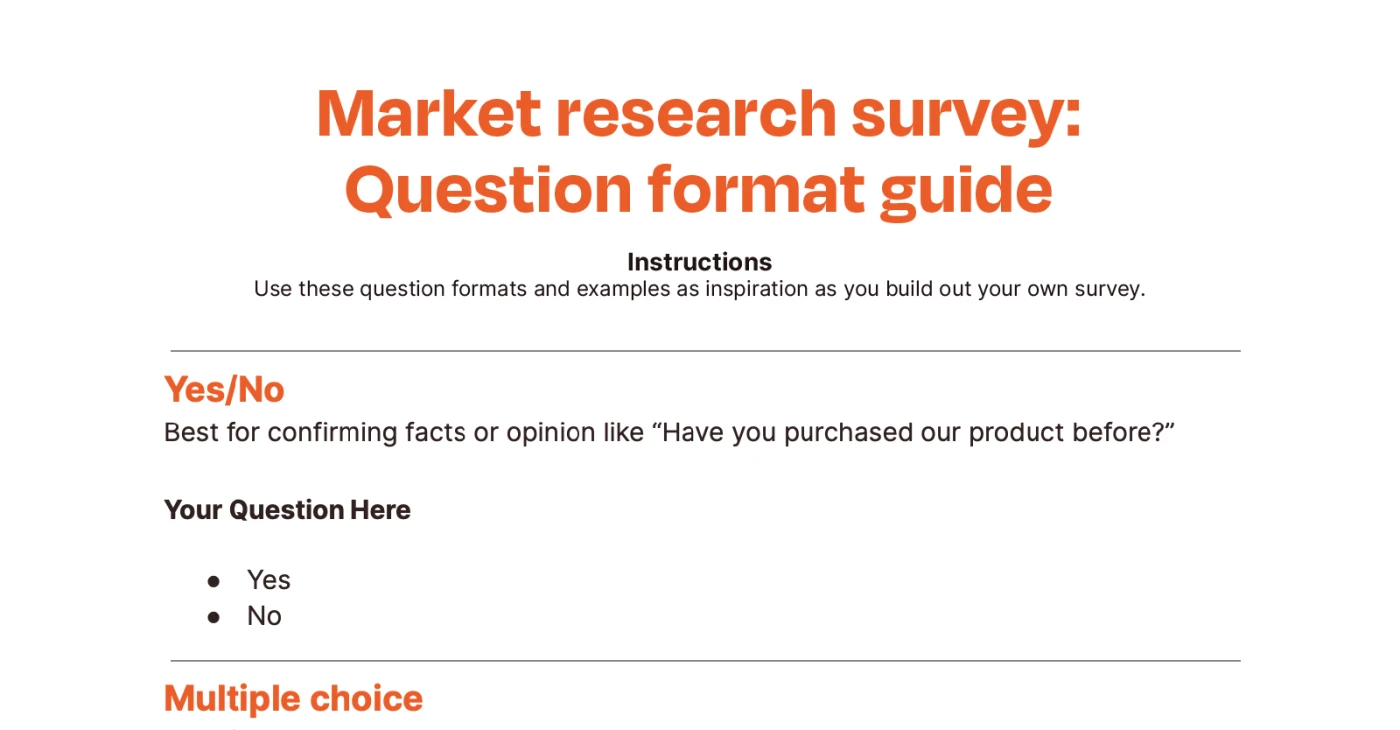
Use automation to put survey results into action
Related reading:
This article was originally published in June 2015 by Stephanie Briggs. The most recent update, with contributions from Cecilia Gillen, was in September 2023.
Get productivity tips delivered straight to your inbox
We’ll email you 1-3 times per week—and never share your information.

Amanda Pell
Amanda is a writer and content strategist who built her career writing on campaigns for brands like Nature Valley, Disney, and the NFL. When she's not knee-deep in research, you'll likely find her hiking with her dog or with her nose in a good book.
- Forms & surveys
Related articles
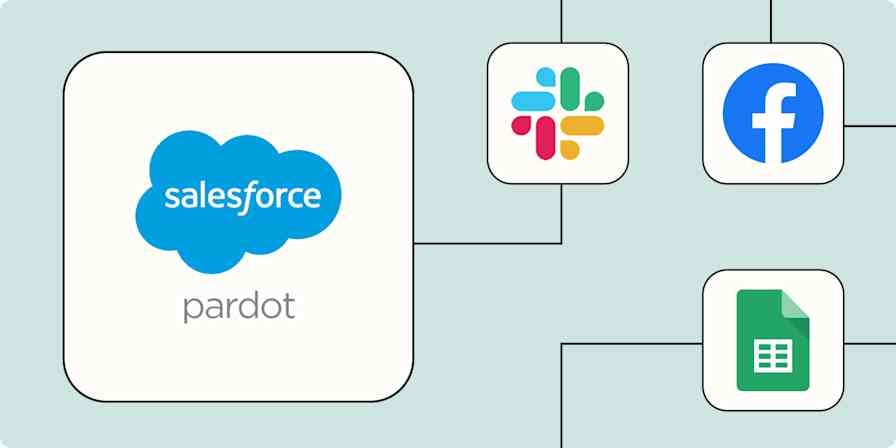
Automation inspiration
5 ways to automate Pardot with Zapier

The 12 best AI marketing tools in 2025
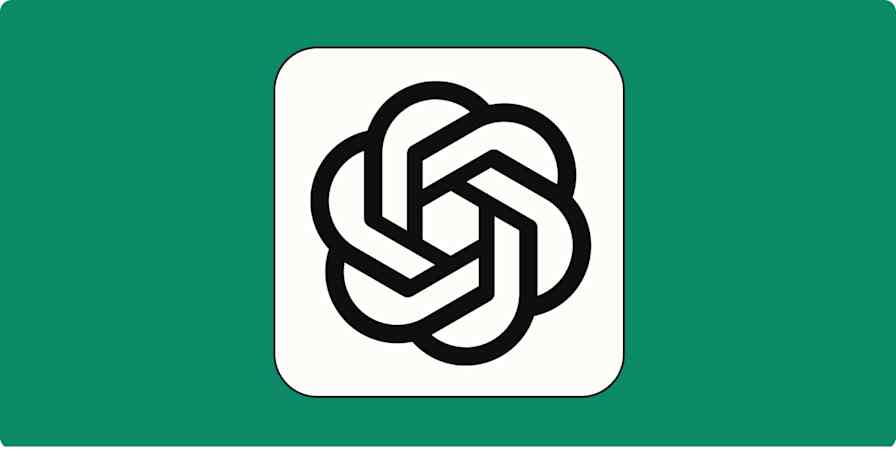
How to use ChatGPT for market research
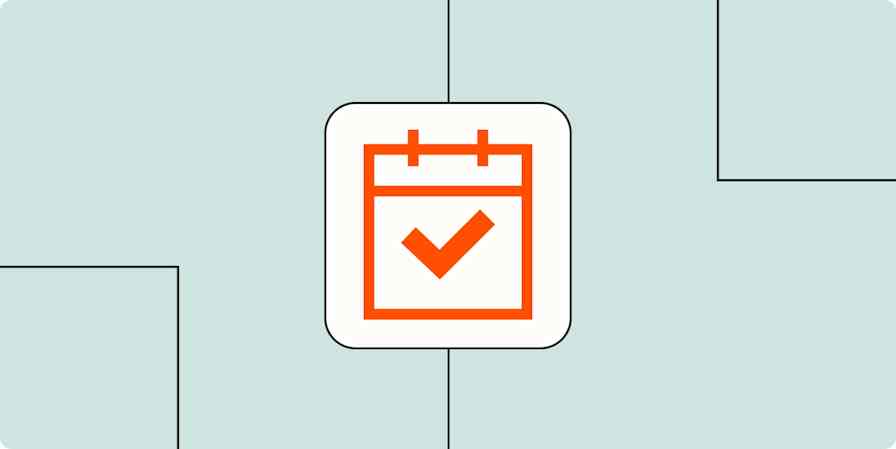
The 7 marketing calendar templates you need (+ examples)
The 7 marketing calendar templates you need...

25 call to action examples (and free CTA generator)
25 call to action examples (and free CTA...

16 examples of how to surprise and delight your customers
16 examples of how to surprise and delight...

5 ways to automate your marketing and sales ops processes
5 ways to automate your marketing and sales...

The 13 best campaign management software tools in 2024
The 13 best campaign management software...
Improve your productivity automatically. Use Zapier to get your apps working together.

- (855) 776-7763
Training Maker
All Products
Qualaroo Insights
ProProfs.com
- Get Started Free
FREE. All Features. FOREVER!
Try our Forever FREE account with all premium features!
Market Research Surveys – Types, Steps, Tips, & 20+ Questions

Market Research Specialist
Emma David, a seasoned market research professional, specializes in employee engagement, survey administration, and data management. Her expertise in leveraging data for informed decisions has positively impacted several brands, enhancing their market position.

Are you tired of feeling like your business is constantly falling behind the competition? No matter what you do, you just can’t seem to catch up! As a business owner, it can be frustrating to watch your sales decline and not know what you’re doing wrong. The answer to this lies in a powerful tool that has helped many business owners stay ahead of the game — market research surveys .
By conducting these surveys, you can make data-driven decisions to improve your products, services, and marketing strategies. In this guide, we’ll provide you with a quick overview of market research surveys, including what they are, why they’re important, how to conduct them, their purpose, types, benefits, actionable tips, and more.
So, let’s dive in and explore how market analysis surveys can help you grow your business in 2023.
What Is a Market Research Survey?
A market research survey is a questionnaire designed to gather data from a specific group of people about their opinions and preferences related to a particular product, service, or industry. According to a Statista report, among all the quantitative methods used for market research, online surveys account for a major share of 89%.

Market research surveys differ from other types of surveys because they are specifically designed for a particular market or industry. They are typically more focused and targeted than general surveys. These surveys can provide valuable insights into customer preferences, behavior, and opinions. This information can then be used to improve products and services, develop more effective marketing strategies, and stay ahead of the competition.
How to Conduct a Market Research Survey?
While jotting down all the factors to create market research surveys, it’s best to keep your business objectives in mind. This will help you craft relevant questions that can fetch detailed and accurate insights.
It is also important to remember that there’s no such thing as the ‘best market research survey questions’ because it is a widely subjective industry with different demands and requirements.
Market research surveys could cover a wide range of topics to effectively gauge deep market insights, and because of the nature of your queries and business goals, the types of questions included in a survey will also differ.
Follow through this section to discover some of the best ways to nail your market research efforts via effective surveys:
1. Determine the target audience & sample size:
Before creating a survey, determine who your target audience is and how many people you need to survey to get accurate insights.
For example, if you’re conducting a survey about a new product, your target audience would be potential customers. Also, ensure that your sample size is large enough because a small survey pool is prone to doling out skewed results.
Here are some examples of market research goals stated as examples:
- What other products are similar to our brand?
- Who are our top competitors?
- What do customers like most about a competitor’s new product/service?
- What made people choose another company over ours?
2. Develop a set of survey questions that are clear, concise, and unbiased
The survey questions should be designed to collect the information that is relevant to your research objectives. It’s important to use clear and concise language to avoid confusion or misinterpretation. Avoid using leading questions or questions that are biased towards a certain answer. For example, asking a double-barreled question like “How important is it for the product to be fast and user-friendly?” will not get you separate insights on how users prefer user-friendliness or fast products. Here, asking the questions separately could get you more precise data than otherwise.
3. Distribute the surveys & collect responses

Once the survey is created, it’s time to distribute it to the target audience. There are several ways to distribute a survey, such as via email, social media, direct links, or embedding it on your website. It’s important to choose the appropriate distribution method that is most convenient for the target audience. As the survey is distributed, responses will start to come in. Keep track of the responses and ensure that all responses are recorded accurately. You can use ProProfs Survey Maker to automate this process, as the app has a feature to collect and analyze the responses in its built-in dashboard without requiring manual handling.
4. Incentivize participation to increase response rates
Offering an incentive, such as a discount or a chance to win a prize, can increase survey participation rates. However, it should also be noted that perks such as monetary incentives could skew the results by making them speak only positively about your brand – resulting in erroneous data. Go for an incentive that offers a free initial subscription to a premium product or service, urging the respondents to be glued to your brand for long periods rather than walking away after collecting discount coupons.
5. Ask relevant questions & follow up regularly
Ensure the survey questions are focused on gathering data that is relevant to the business’s goals. This helps increase the probability that the insights gained are actionable. As the next step, test the survey with a small group of people to help to identify any issues with the survey questions or the survey platform. Amidst all this, don’t forget to follow up with your targets regularly. Following up is the gesture to gently remind people who might have missed completing your survey in their busy lives. Once you are in the middle of your first phase, consider sending follow-ups to the participants who haven’t completed their surveys yet. Also, if you aren’t already offering incentives, include them with follow-ups to ensure better response rates.
Types of Market Research Surveys
Considering the plausible benefits associated with market research surveys, professionals across the globe leverage several ways to garner market insights for their upcoming products. Let’s discuss some common ways:
1. Brand Awareness Survey

Have you ever wondered how well-known your brand is among your target audience? Conduct a brand awareness survey to find it out! This type of survey is designed to measure how familiar your target audience is with your brand and how well they recognize it.
Brand awareness surveys can be helpful in several ways. Firstly, it can help you identify any gaps in your brand awareness strategy. For example, if your target audience is not familiar with your brand, you may need to focus on increasing visibility through marketing campaigns or social media. Secondly, it can help benchmark your performance against your competitors. This lets you understand how your brand is perceived in the market and scope out areas for improvement. When designing a brand awareness survey, it’s important to ask questions that measure both aided and unaided brand awareness.
- Aided awareness refers to how well your target audience recognizes your brand when they are given a prompt, such as a logo or a tagline.
- Unaided awareness refers to how well your target audience recognizes your brand without any prompts. It’s important to ask both types of questions to get a complete picture of your brand awareness.
In addition, you can ask questions about your brand’s reputation and attributes. This can help you understand how your brand is perceived by your target audience and identify areas for improvement. The business insights gleaned from such surveys are used to gauge and improve purchase decisions among both existing and potential customers. For example, you can use these questions to make the most out of your brand awareness surveys:
- What is the first brand you think of to purchase an XYZ product? (Characters remaining 100)
- What aspects can we improve on our existing product? (Characters remaining 500)
- What words come to mind when you think of our brand? (Characters remaining 100)
- How would you describe our brand to a friend? (Characters remaining 100)
2. Customer Satisfaction Surveys

A Customer Satisfaction Survey measures how satisfied customers are with their experience of a particular product or service. It’s a great way to get feedback from customers and understand how well your business is meeting their needs and expectations.
The main goal of a Customer Satisfaction Survey is to identify areas where your business is doing well and areas where it can improve. By measuring satisfaction and gathering feedback, businesses can identify areas for improvement and develop effective strategies to enhance the customer experience. This can lead to increased customer loyalty, better word-of-mouth marketing, and, ultimately, more business.
But what makes a good Customer Satisfaction Survey?
Well, it’s important to ask questions that are clear, concise, and unbiased. You want to get honest feedback from your customers, so it’s important to avoid leading questions or questions that are too general. Also, make sure that the survey is easy to complete and not too time-consuming.
3. Product Feedback Surveys
Needless to say, a lot of products exist that offer exactly the same features and cater to the similar needs of the people just as your own products. If you want to know how you are faring against your competitors, a Product Feedback survey is your best bet.

Product Feedback surveys aim to understand how customers use your products or services, what they like about them, and what they don’t like. This can help businesses make informed decisions about product development, marketing, and customer service. By listening to customer feedback, businesses can improve their products or services and create a better customer experience. Product feedback surveys also provide you with a data-centric understanding of your existing products. This will not only help you with your new product launch but also let your customers test out your existing products to understand what’s best about them and what could be improved.
4. Market Segmentation Surveys

Market Segmentation Surveys are a type of survey that helps businesses divide their target market into smaller groups based on specific characteristics, such as demographics, interests, or behaviors.
It’s a great way to understand the different segments of your target audience and tailor your marketing campaigns to each group based on their unique needs and preferences. This can help your brand develop effective marketing strategies that resonate with each group and drive more sales.
To make your survey stand out, you should:
- Clearly define the specific characteristics you want to measure. This will help you tailor your questions to gather the most relevant information.
- Avoid using complex language or industry jargon that may confuse respondents. Use concise and easy-to-understand questions instead to get the data that you can actually use.
- Take the time to analyze your survey results and identify the different segments within your target audience. Use this information to tailor your marketing campaigns to each group and improve your overall business strategy.
5. Concept Testing Surveys

If you are a business owner considering launching a new product or service, you might want to consider using concept testing surveys to evaluate your ideas before launching them! Concept testing surveys allow you to gather feedback from potential customers on your product or service concept. Using these, you can identify potential issues or areas for improvement before investing in the development and launch of a new product or service. This feedback considerably reduces the risk of a new launch failing simply because it doesn’t resonate with your target audience. Additionally, these surveys can help you figure out the shortcomings in your existing products. By gathering feedback on specific features or benefits, you can make changes to better meet the needs of your target audience.
They are usually conducted online or through phone interviews, where the respondents are asked to provide feedback on the features, benefits, and overall appeal of your product or service.
6. Advertising Effectiveness Surveys

As important as launching business campaigns are, it is equally important to gauge how effective they are in achieving their goals, lest your budget is squandered for nothing.
That’s where advertising effectiveness surveys come in. These surveys are designed to measure how well your advertising is working and how it’s impacting your target audience.
They typically gather feedback on your advertising, such as-
- How memorable it is
- How persuasive it is
- Whether it’s driving them to take action, etc.
These surveys get you in-depth feedback on how well your ad strategies are resonating with your target audience, which, in turn, can help you make informed decisions about how to improve your advertising campaigns and make them more effective.
Additionally, you can identify which advertising channels are working best for your business. For example, you might find that your social media advertising is more effective than print advertising. This will help you allocate your advertising budget more effectively and get the most out of your campaigns.
7. Pricing Research Surveys

As one of the most important types of market research surveys out there, these surveys are all about determining the right price for your product or service. Pricing Research surveys might ask questions like, “How much would you be willing to pay for this product?” or “Do you think this product is too expensive?” to gain valuable insights into how your target audience perceives the value of your product or service.
This feedback can help you make informed decisions about how to maximize sales and profitability. Additionally, Pricing Research surveys can help you identify which pricing strategies are most effective for your business. For example, you might find that offering a discount or bundling your product with another product is more effective than simply lowering the price.
20+ Market Research Questions for Your Survey Campaigns
Given are some sample market research questions for your survey campaigns, categorized by survey type. Concept Testing Surveys:
- How appealing is the concept of our new product/service?
- Which features of our product/service are most appealing to you?
- How likely are you to purchase our product/service?
- What do you think is the main benefit of our product/service?
- How does our product/service compare to our competitors’ offerings?
Brand Awareness Surveys:
- Have you heard of our brand before?
- What do you know about our brand?
- How likely are you to recommend our brand to a friend?
- What comes to mind when you think of our brand?
- How likely are you to purchase from our brand in the future?
Customer Satisfaction Surveys:
- How satisfied are you with our product/service?
- How likely are you to purchase from us again?
- How responsive is our customer service team?
- How easy is it to use our product/service?
- How well does our product/service meet your needs?
Market Segmentation Surveys:
- What is your age?
- What is your gender?
- What is your income level?
- What is your occupation?
- What is your educational background?
Pricing Research Surveys:
- How much would you be willing to pay for our product/service?
- How does the price of our product/service compare to our competitors’ offerings?
- What pricing strategy would be most appealing to you?
- How does the price of our product/service impact your purchase decision?
- What is the maximum amount you would be willing to pay for our product/service?
Remember, these are just sample questions. You should tailor your survey questions to your specific business needs and target audience. By asking the right questions, you will be able to uncover precious data that will drive well-informed decisions for your business!
Purpose of Market Research Surveys
Just like it takes extensive skills to be a winner in the playing field, similarly, you need deep insights to steer any new concept or product deftly enough to win the market.

Let’s explore a few reasons why businesses employ market research surveys:
1. Gather Actionable Insights
Conducting market research surveys can help businesses make data-driven decisions, improve their products and services, and develop more effective marketing strategies. These surveys provide businesses with objective data that can be used to make informed decisions. By gathering data directly from customers, businesses can better understand their needs and preferences.
2. Improve Product Quality
Imagine this: You are a software provider and find it challenging to understand the specific features, functionalities, and integrations that would best cater to your target customers’ needs. To ensure that you develop a product that truly meets their requirements, who better to provide valuable insights than your customers themselves? In a situation like this, a market research survey can get you the right data on customer preferences that you can use further to develop new products that better meet their needs.

3. Validate The Demand
The probability of your product failing amplifies when you are planning to launch a product and then trying to find potential buyers. Well, to keep such a situation at bay, validate the demand and profitability of your product before diving into the production/development process. Market research surveys could help you attain the desired customer, market, and competitor’s data to save both the cost and efforts that could end up wasted otherwise.
Read More: Product Market Fit: An Ultimate Guide
4. Make Products Cost-Effective
Budget often remains a potential concern for businesses while planning to launch a new product in the market. Hence, incorporating the survey for market research helps you avoid huge losses. Depending on other sources, such as focus group discussions, can limit the responses to a certain number of participants and usually requires massive budgets. On the other hand, the availability of Market Survey tools makes it more effective to garner advanced market insights while saving a lot of time and money.

5. Understand Competitor Products Better
What can you do to keep your customers from switching to your competitors? Well, the foremost is to offer a better deal after analyzing your competitors’ data. For example, if you are unaware of the competitive prices of a similar product, you might end up charging way more than the prevailing prices. In doing that, you will lose a large chunk of your potential market and eventually take your product toward failure.
7 Tips for Creating Effective Market Research Surveys
With so many factors to consider, it’s easy to get overwhelmed and end up with a survey that doesn’t provide the insights you need. But fear not! With these tips and tricks, you can create a market research survey that not only provides valuable insights but also engages your target audience.
1. Define your research objectives:
Before creating a survey, it’s important to define your research objectives. What do you want to learn from the survey? What decisions will you make based on the results? Having clear research objectives will help you create a focused and effective survey.
2. Keep it short and simple:
People are more likely to complete a survey if it’s short and easy to understand. Keep your survey concise, and avoid using technical jargon or complex language.
3. Eliminate survey bias:
Make sure your survey is free of various forms of bias, such as-
- Sampling bias
- Acceptance and dissent bias
- Question order bias
- Personal bias
4. Use clear and specific questions:
Your survey questions should be clear and specific to avoid confusion or misinterpretation. Avoid asking leading questions or questions that are too general.
5. Use a mix of question types:

Using a mix of question types, such as multiple-choice, open-ended, and rating scales, can provide more comprehensive insights into your target audience.
6. Test your survey:
Before distributing your survey to your target audience, test it with a small group of people to ensure it’s effective and easy to understand.
7. Consider the timing and distribution method:

Timing and distribution methods can impact response rates. Consider the best time to distribute the survey and the most effective distribution method for your target audience.
How Market Research Surveys Can Help Your Business

The scope for market research services is expanding rapidly, showing a significant interest in market research as we enter 2023. The global revenue of the market research industry exceeded 81 billion U.S. dollars in 2022 and has grown more than twofold since 2008.
If you want to stay ahead of the competition, it’s time to start investing in market research surveys. Here are some benefits of conducting these surveys:
- Understand your customers Market research surveys can help you understand your customers’ needs, preferences, and behaviors. This information can help you improve your products and services and tailor your marketing strategies to better meet your customers’ needs.
- Identify market trends Market research surveys can help you identify market trends and steer ahead of your peers. By understanding what’s popular and what’s not, you can adjust your products and services to cater to the changing needs of your target audience.
- Improve customer satisfaction Market research surveys can help you identify areas where your customers are dissatisfied and make improvements to increase customer satisfaction. This can lead to increased customer loyalty and retention.

- Optimize pricing strategies Market research surveys can help you determine the optimal price points for your products and services. By understanding what your customers are willing to pay, you can set prices that are competitive and profitable.
- Make informed business decisions By gathering data and insights through market research surveys, you can make informed business decisions. This can help you minimize risks and maximize opportunities for growth and success.
Here is a quick video on how to access recent activity reports for your surveys:
Create a Strong Market Research Survey Regime to Dominate Your Field
Have you ever wondered what your customers really want? What sets you apart from your competitors? What are the latest trends in your industry? These are the questions that market research surveys can answer for you. But, designing a survey that yields accurate and reliable data can be challenging. That’s why it’s essential to ensure that your survey is well-structured, relevant, and easy to understand. Once you’ve collected the data, it’s equally important to analyze it thoroughly and use the insights gained to make informed decisions. As Peter Drucker famously said, “What gets measured, gets managed.” market research surveys are a powerful tool for businesses of all sizes to achieve their goals and stay ahead of the competition. So, don’t wait any longer. Start your survey today with a modern market research solution such as ProProfs Survey Maker and take your business to new heights!

About the author
Emma David is a seasoned market research professional with 8+ years of experience. Having kick-started her journey in research, she has developed rich expertise in employee engagement, survey creation and administration, and data management. Emma believes in the power of data to shape business performance positively. She continues to help brands and businesses make strategic decisions and improve their market standing through her understanding of research methodologies.
Related Posts

How to Create Rating Scale Surveys: Benefits, Types & Examples
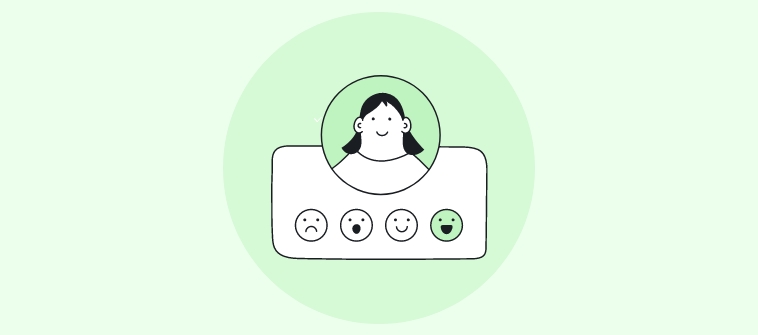
90+ Market Research Questions to Ask Your Customers

Product Market Fit: An Ultimate Guide
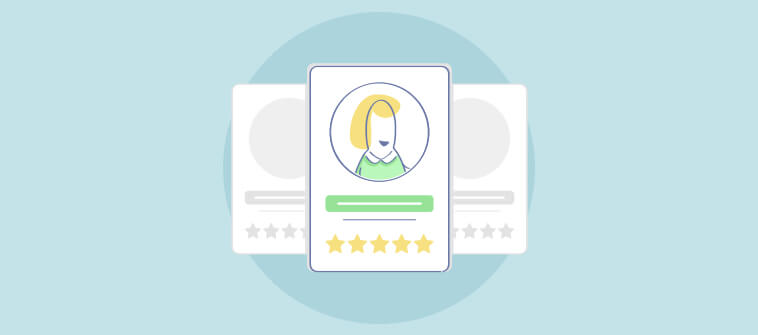
Market Segmentation: Types and Benefits

How to Write Qualitative Research Questions: Types & Examples

What Is Qualitative Research: Methods, Types, Examples & Analysis
18 Ways to Use Market Research Surveys

Free Website Traffic Checker
Discover your competitors' strengths and leverage them to achieve your own success
A market research survey is a tried and tested tool to help you uncover vital intel about consumer sentiment, something any business can benefit from. In a perfect world, we’d know exactly what people want, think, and feel about our products and company all the time. Sadly, it’s neither feasible nor realistic. And that’s ok.
With the best products, messaging, and delivery, there’s always room for improvement. And even when you get it just right, market and consumer behaviors can shift at a moment’s notice.
Enter market research surveys – the most favored and widely used qualitative research tool there is right now.

What is a market research survey?
A market research survey is a qualitative research method used to gather feedback from a person or group. It provides vital insights that support strategic decisions , allowing organizations to analyze and understand consumer behavior or motivations in more detail. Responses are collected in various forms, such as paper, in-person, mailings, or online.
What information can a market research survey tell you?
Market research surveys collect feedback from individuals by using a range of questions to find out about things like:
- Experiences
- Characteristics
- Preferences
- Motivations
- Needs & Demands
What are the benefits of market research surveys?
Here’s the top five advantages of using online market research surveys:
- Quick to set-up
- Easy to create
- Immediate feedback
- Extensive reach
“As a business that provides market research survey tools, our mission is to help companies collect crucial information so they can understand the people’s opinions, behaviors, and knowledge of specific industries, products, and services. Data collected through market research surveys are essential for making decisions about product development, marketing strategies, and business operations.”

Market research survey uses and types in action
Market research surveys are both valuable and versatile . But many organizations fail to realize their true potential; and don’t always extract the maximum ROI. Here, I’m sharing 18 different ways to use online surveys.

1. Measure customer satisfaction
Market research surveys are an ideal way to measure and obtain feedback about customer satisfaction ; they’re often referred of CSAT (Customer Satisfaction) surveys, indicating what consumers like and dislike. They also allow organizations to keep track of their Net Promotor Score (NPS). Typically, these surveys ask questions to uncover insights about a service, product, or experience. Sending timely feedback surveys to help resolve issues before they become a problem , giving you the chance to transform a poor experience into a good one.
Here’s three examples of typical questions asked in customer service surveys:
- Please rate the service you received when you visited our store today – Availability of staff (1-5) – Staff knowledge (1-5) – Friendly and helpful attitude (1-5)
- Were you recommended any additional products or services? (yes/no)
- If we could improve one thing about your experience at our store today, what would it be? (open text)

2. Do opinion polling
A great way to gather mass consensus from a large group of people. Typically, they’re short and sweet, asking just 2-3 questions. It’s one of the fastest ways to establish public opinion on a chosen topic. There are three types of opinion poll surveys you can use. They are:
- Rating – Usually a sliding scale between 0-10.
- Multiple choice – This offers three to five- options to choose from (always include ‘other’ as one of these with a free text field to uncover insights you might not have considered).
- Free text – Useful, but a little prohibitive if used too much. It’s important to balance the use of this option with quick and easy ratings and checkbox formats.
Here are three examples of opinion polling survey questions:
- What is the main reason you are attending the event?
- Do you like the changes to the lunch menu?
- What would be your ideal work setup? Office, WFH, or Hybrid?
3. Conduct audience research
Also known as buyer persona surveys, use them to better understand who your customers are, their motivations, and demographics . The results allow you to develop better value propositions and create more informed marketing campaigns that convert better and drive revenue.
Here are a few examples of audience research survey questions:
- Which social sites do you look at most?
- How often do you check your emails?
- How much research would you do before making a buying decision?
- Which search engine do you use most?
- What information formats do you most engage with?
- What tools do you use most in your daily work?
4. Automate testimonials & reviews
Testimonials can build a boatload of authority and buyer confidence. 85% of people trust reviews from strangers as much as peers, making them one of the most valuable forms of content. Automate the process, sit back, and watch the feedback roll in. During set-up, use a mix of rating-based questions and open-text fields. Once collected, they’ll support brand awareness , boost credibility, and assist with other marketing-related activities.
5. Measure employee satisfaction
It’s no secret that happy employees are more engaged and productive . According to research, happiness makes us about 12% more productive . On the flip side, low morale or job dissatisfaction can harm an organization’s reputation, culture, and bottom line. Surveys are a low-cost, effective, and easy way to measure employee satisfaction . You can also use them as exit interview surveys, a must for any business of any size.
Pro Tip: To surface any drivers of employee dissatisfaction, people need to know they can be brutally honest and open with their responses; anonymity in the survey is the only way to achieve this.
6. Validate product development ideas
Online surveys are a great way to validate whether or not a new product idea is worthy of investment. It can help you quantify demand by asking direct questions about specific features or concepts you are considering. Within our own business, we review new products or feature ideas internally and then validate their impact and potential with customers in the same way. Simply put, a quick research survey can uncover vital intel that shapes the what, how, and when to enhance your offering.
7. Measure lead generation effectiveness
Research surveys can help determine the efficiency of your lead qualification process . In short, they can measure and track how well a sales team is doing and assess things like timeliness, follow-up activities, and more. The information helps organizations find new ways to improve the management of lead generation activities and take actions that directly impact conversions in the future.
8. Improve market segmentation
Market surveys for better understand customers can help you better understand customers and prospects. With this, you can separate customers into smaller groups based on interest, demographics , geography , usage, or brand preferences. This gives you the ability to do more targeted marketing and a clearer view of why people in a specific group have or haven’t done business with you.
Segmentation survey example: A spa owner could use segmentation to group clients based on their treatment type or specific brands or products they prefer. They’re then able to offer specific promotions that involve the cross-pollination of products and services. This is just a single example; the possibilities are endless.
9. Qualification of pricing models
Surveys help you qualify any initial work on pricing new products or services. They can provide a clear indication of price ranges to consider and in some cases, give insights that shape pricing models and strategies that better serve the needs of different groups in a market. For demand analysis, these surveys are designed to determine if prices are set too high or too low.
10. Choose the right create assets
Establishing what types of creative assets most appeal to a target audience saves time and money while increasing the potential for success . For example, suppose you’re considering a few different titles for a major email campaign or trying to decide between a physical billboard campaign vs. digital marketing. In that case, a targeted survey can give you a general inclination of what will or won’t work.
Even with a sample network to target, you can get valuable insights to help you prioritize resources.
11. User experience
User experience (UX) surveys are one of the most important things you can do when designing or improving a product or service. The key to success is crafting an unbiased UX survey that enables people to freely open up about their preferences and attitudes. The questions you ask will be largely determined by what you want to achieve. User experience surveys can take place live from within an app or on a website, but can be confused with usability testing; a method that evaluates how easy a product is to use by testing it with actual users.
Here’s a few tips to get you started:
- Ask the right questions:
- Avoid using closed questions (yes/no) as they’ll often not provide usable intel about a customer’s mindset
- Use task-driven questions like ‘can you tell me more about your experience using our mobile app to make your booking?’
- Ranking questions, like ‘how would you rate the ease of booking via our app?’
- Avoid leading questions to avoid bias, like ‘if you enjoyed this product, should we create more like it?’
- Keep your survey short, clear, and simple – no more than eight questions is ideal.

12. Conduct a competitive analysis
You can use market surveys to get a quick taste of consumer appetites for a rival’s product, marketing efforts, and pricing. Here, I’ve highlighted three areas, along with specific questions to gather telling feedback about your competitors.
Where a market survey delivers value is by asking focused questions about sentiment and perception. Questions like:
- Do you perceive company x’s products to be high-quality or low-cost vs. our own?
- Do you find x feature valuable or not?
- Would you be prepared to pay more for a new feature that does x, y, or z?
Here’s a few questions you can ask:
- Which channels do you prefer to interact through, phone, app, live chat, etc.?
- What made you decide to purchase with us vs. a competitor?
- Do competitors offer promotions that would compel you to buy from them over us?
- What would deter you from buying x product from a competitor?
Enables you to clearly see which assets people respond to most positively. Aside from using a rival’s website to see their latest marketing campaigns, look at social media too. Do your competitors have a mobile app?
- If so, then you need to download it and experience things from your customer’s perspective.
- If not, do a survey to find out whether there’s an appetite for this or not?
Pro Tip: Use market research surveys to show your target demographic a selection of marketing materials from different competitors; ask them which they prefer and why, but make sure you remove their branding to avoid bias.
Here’s a few good questions to ask:
- How does this ad make you feel?
- Would you be more or less likely to buy if you saw this?
- What perception of the company or product do you have after seeing this ad?
Using surveys for competitive market research is just one of the many methods of gaining market intelligence to stay informed and gain market share . Surveys take time, and you need to consider how you tap into audiences that are aware of your rival’s offering and your own. Here’s a link to an article with some competitive analysis examples to help you find other ways to do this.
13. Monitor and track brand perception
Good brand perception can do wonders for your business. If people believe in your brand, it can open doors to new partnerships, boost buyer confidence, and make launching products easier. Brand tracking surveys give you a low-cost, effective way to monitor and benchmark brand perception regularly. Run them quarterly to get trackable results, and use a sliding scale, allowing people to indicate whether they’re more or less interested in specific products, features, or services.
Pro Tip: Brand tracking surveys aren’t just for customers and prospects, but employees, partners, and other stakeholders. Make sure your distribution accounts for this.
14. Analyze purchase or intent analysis
The consumer decision-making process typically consists of five stages, sometimes more.

Taking time to understand purchase intent allows you to capitalize upon and generate future demand for products, uncovering key drivers behind consumer intent. As a result, you can build more effective campaigns based on genuine consumer patterns; and discover what drives consumers to move from interest to purchase.
Different types of questions can be used to measure purchase intent. Always consider the objectives of your survey first before selecting the questions you’re going to ask; the format of the question will directly determine the type of information you yield.
Scale survey questions
These are used to determine feelings and opinions. For instance, to determine the likelihood of a future purchase from a specific set of customers, you can present respondents with a statement like this.
Q. I will probably purchase a new walk-in shower in the next 12 months
- Strongly agree
- Neither agree, nor disagree
- Strongly disagree
Ranking questions
Enable you to understand a service or product’s popularity. These are used more so in the early stages of a purchasing journey and can tell you how you compare with competitors, and which products most appeal to certain groups of people.
Q. Rank the following walk-in shower brands in order of preference
Rating scale questions
Use a numerical scale (usually 0-10) that allows respondents to rate the likelihood they’ll choose your offering over a rival.
Multiple-choice questions
These are the most widely used survey question type because they’re quick and easy for people to answer. They can help you establish purchase timeframes, which ties into demand and sales projections. An example of this could be:
Q. When do you expect to buy a new walk-in shower?
- Within 3 months
- Within 6 months
- Within 12 months
- I have no plans to buy a walk-in shower in the near future
Feedback from a survey question like this means your sales division can turn its attention to prospects who indicate they’re likely to purchase in the near future.
15. Discover factors that impact customer loyalty
Customer loyalty surveys tell you ‘why’ people love you or leave you, providing a valued measurement for your NPS. Using surveys for loyalty purposes lets you translate raw data into actionable insights that shape future strategies, campaigns, and messaging.
Here are a few examples of questions to ask in a customer loyalty survey:
- How likely are you to continue using our services?
- On a scale of 0-5, how satisfied are you with our company?
- Do you deal with any other companies for a similar product or service?
- How do you rate the value we offer for the money you pay?
16. Do B2B market research
The global B2B eCommerce market is growing , so much so that it’s expected to reach over 25 trillion by 2028. Needless to say, having effective tools to help with B2B market research is key. Market research surveys are a quick and easy way to target a large group of people at a low cost.
Here are a few ways to use B2B market research surveys, with sample questions included:
- Demographical information – Who are your target customers? – What is your line of business? – How many employees does your company employ? – What is your position at the company?
- Need vs. demand data – Does your business ever buy x products? – Do you use any apps or tools to boost productivity? – Who is the person responsible for buying x products? – Where do you go if you’re looking to buy x?
- Buying pattern insights – What’s the most important feature when buying promo products for your customers? – What motivates you to spend more money buying from a new vendor? – What business issues motivate you to invest in new products or marketing campaigns?
17. Measure advertising effectiveness
Conversion and click-through rates are widely regarded as the best way to measure advertising effectiveness. The often-forgotten about survey tool is another way to test how strong or relevant your ads or messaging is. The results can give you deeper insights that help you shape future marketing efforts for better results.
Here, you’re looking to find out:
- How much an advert motivates people to purchase?
- Are they memorable?
- Did customers understand them?
- What do customers think or feel about a specific slogan or tagline?
Pro Tip: You can also use this type of survey to uncover how people think about your ads vs. those of your rivals.
18. Improve content marketing strategy
Online surveys are a lesser-known but highly valuable tool to enhance your content marketing strategy . Instead of simply crunching the regular performance metrics, develop a quick online survey to gauge feedback from your content VIPs (your audience). It gives you the chance to connect with your readers, show them you care , and ensure your content efforts exceed expectations.
The questions asked should address experiences, likes, dislikes, and preferences. Ask about their preferred content formats, and find out if they’d like to hear more or less about a theme or topic. Another easy way to do this is by adding a rating score at the bottom of an article that asked people if they found it useful, or not.
Read more: this article outlines 99 market research questions you should be asking, some are for you, others for your customers.
Best Online Market Research Survey Tools for 2022
We’ve all likely heard of names like SurveyMonkey, Typeform, and Qualaroo, either from personal experience or through marketing. One thing that surprised me was the sheer volume of tools for online surveys; far too many to list here (48 and still counting).
For now, here are nine of the best.
- SurveyMonkey
- Branded surveys
- Google forms
Wrapping Up
There’s no doubt that a well-constructed market research survey can be golden for your business. But, there are now more efficient ways to gain insights into most of the same things I’ve covered in this post. Similarweb Research Intelligence is a great example of this in action.
Features like website demographics, search keyword analysis , market analysis , audience interests, industry analysis , segment analysis, and competitive analysis are just a few relevant places where you can uncover instant insights to help you shape strategic decisions around marketing, growth, and product development.
Enjoy 360 Visibility 24/7
Get the data you need to adapt to market changes and industry trends in an instant.
Further Reading:
- Market Research Tips Straight From the Experts
- Get Growing with Small Business Market Research
- 7 Highly Successful Market Research Examples
- The Complete Guide to Desk Research
- Market Research Trends to Conquer 2022
- 64 Market Research Questions You Should Be Asking
How do you choose which type of market research survey to use? Answer these questions to determine the best type of survey to use:
- Size of the survey base – how many people are you likely to survey? (monthly/yearly)
- How many times will you conduct surveys? (monthly/yearly)
- What format will you use? (Online, telephone, in-person, paper)
What are the things to consider before doing a market research survey? Note down what you want to achieve, and consider the type of structure you will use to collect responses. For instance, surveys can be based on ratings, rankings, open text, or a mixture of all three. Another consideration is anonymity and whether you will offer an incentive to participants who take the survey.
Should you incentivize market research survey participants? If you’re surveying a niche market or niche audience , and their input is of high value, or you have a survey that’s more than 5-minutes to complete, you might want to offer an incentive to encourage a response. It’s now considered common practice to offer incentives via promotional codes, PayPal credits, or charitable donations to entice participation.
Can you automate market research surveys? Automating market research surveys is the best way to ensure relevant questions are asked at the right time. Specifically for surveys about customer satisfaction, testimonials, and reviews, these are very easy to automate and quick to set up.
Is a market research survey the same as market research? Market research surveys are a type of qualitative research, which is one type of market research method.

by Liz March
Digital Research Specialist
Liz March has 15 years of experience in content creation. She enjoys the outdoors, F1, and reading, and is pursuing a BSc in Environmental Science.
Related Posts

20 Mobile App Metrics To Track In 2025

2025 Market Research Industry Statistics, Facts, and Trends

7 Common Types of Website Traffic Sources Explained

Traffic Attribution: Understanding Marketing Attribution Models

Qualitative Data Analysis Methods and Techniques

Market Saturation: Definition, Examples, and How to Avoid It
Track your digital metrics and grow market share.
Contact us to set up a call with a market research specialist
Guide to market research surveys

Research Director
Market research surveys are powerful tools that help companies better understand current and potential customers. This information can be used to make business decisions based on facts and data —not flimsy gut feelings. But how, exactly, do you go about conducting market research surveys? We answer this question and more below.
What are market research surveys?
Market research surveys are a reliable means of gathering insight into the people that matter most: your target audience. Put more simply, surveys help market researchers get to know current and potential customers. And in some cases, like new product launches, can help to determine who your customers are.
The type of information extracted from these surveys varies. However, businesses typically use market research surveys to collect demographic data as well as data related to consumer desires, beliefs, and purchasing behavior. For example, a company may develop a market research survey to evaluate brand awareness. Meanwhile, another company may design a market research survey to assess demand for a potential product.
It’s worth noting that market research surveys are an example of primary research. That means you are collecting information that hasn’t already been collected. Comparatively, secondary research involves using pre-existing data. For example, market researchers may reference census data.
Furthermore, it’s also important to note that the data collected through market research surveys is usually quantitative. This allows company executives to make quick, fact-based business decisions. For instance, information gleaned through a market research survey may show that customers in certain areas are willing to spend 50 percent more on a particular product. Companies can use this information to adjust pricing accordingly.
While online surveys are typically used to collect quantitative data, they can also be useful in collecting qualitative information as well. Market researchers achieve this by including open-ended questions that require panelists to type answers into a comment box. From there, market researchers can analyze the text manually or use text analysis tools.
Why use market research surveys?
Market research surveys provide a window into the consumer psyche, helping market researchers and end users better understand consumer wants, needs, and pain points. Companies can then use this information to develop products and services that resonate with the target market or better understand and respond to consumer concerns.
Simply put, market research surveys can boost the bottom line by helping businesses:
Research and analyze a target market
The primary goal of a market research survey is to gain insight into the people who are buying or who may buy your products or services. This insight may range from customer satisfaction to a consumer’s reaction to advertisements (i.e., ad testing).
Market research surveys often collect demographic data as well to enable deeper analysis among sub-groups of the population or your target market. For example, a questionnaire may request information regarding gender, location, and education level.
Measure brand awareness
When you live and breathe your company, it can be difficult to objectively assess what your target market thinks of your products and services. (Or, if your products and services are even on their radar.) That’s where a brand awareness survey comes into play.
A brand awareness survey seeks to evaluate consumers’ awareness of your brand, frequency of usage, and their perception of it compared to competitors. This information can be used to determine if your company is breaking through the noise or if more energy needs to be invested in marketing efforts.
Gain insight into current or future products
Is a product meeting customer needs? The best way to find out is to ask customers directly through an online product feedback survey. This questionnaire may ask questions like: ‘What changes would improve the product?’ and ‘What do you like most about products available from other brands?’
A similar type of survey can be conducted prior to releasing a product as well. These surveys help companies work out kinks or determine which features are most important to consumers before officially launching the product.
Types of market research surveys
Market research surveys can give companies the information needed to make key decisions, from adjusting or determining pricing to providing a new service. However, to collect meaningful data, market researchers must be sure to select the correct type of survey based on the target audience and the overarching research goal.
Online surveys
Online surveys (aka panel surveys ) are developed using survey platforms and then distributed to panelists (typically via email).
In recent years, online surveys have exploded in popularity, and with good reason. Thanks to the internet, market researchers can use this tool to reach consumers across the globe quickly. Even better, this survey method is relatively quick and affordable.
However, there are some downsides. Namely, online surveys are vulnerable to survey fraud—a phenomenon in which panelists or online bots offer disingenuous responses. Respondents may, for example, straight-line or speed through questions. Meanwhile, some scammers make a living by intentionally hacking surveys to collect economic incentives.
- Relatively low cost
- Global accessibility
- Real-time access to results
- Convenient for both panelists and researchers
- Quick execution
- Vulnerable to survey fraud
- Vulnerable to response bias
- Sampling is limited to respondents with internet access
In-person interviews
In-person interviews have long been a staple of market research. To conduct these interviews , participants must travel to a physical location. From there, a market researcher asks a series of questions that are answered verbally.
There are clear benefits of this survey method. In particular, a market researcher is present to answer and clarify any questions that the interviewee may have. In comparison, panelists completing online questionnaires may abandon the survey altogether if they become confused.
Nevertheless, in-person interviews are significantly more expensive and time-consuming. Participants may also feel less inclined to offer honest responses to potentially sensitive questions (e.g., ‘How many alcoholic beverages do you consume each week?’).
- Market researcher is available to offer clarification
- Moderators can take note of non-verbal cues
- Panelists can experience products in real life (in the case of product testing)
- Relatively higher cost
- More time-consuming
- Panelists are geographically limited
Telephone surveys
During a telephone survey, market researchers ask panelists a series of questions over the phone.
As with the in-person survey, the primary benefit of a telephone survey is that the moderator can offer further instruction and clarification if a respondent is confused by a particular question.
There are downsides, though. Chiefly, it can be difficult for market researchers to connect with panelists. Most people screen their calls and are hesitant to answer a phone number they don’t recognize. Additionally, questions that can be asked in an online survey to keep the respondent engaged typically do not translate over to phone interviews well. For example, an exercise where respondents are asked to rank a list of 10 items in order of importance is easier to complete when you can see all 10 items on your screen vs. a phone interviewer having to read them off to you.
- Wide geographic access
- Relatively cost-effective
- Market researcher available to answer questions
- Difficult to connect with panelists
- Questions must be simple and brief
- Panelists may be unwilling to share sensitive information
Mail surveys
With a mail survey, questionnaires are sent directly to panelists’ homes. The panelists then complete the surveys and mail them back to the company.
Though this method may seem antiquated, it allows market researchers to target segments of the population based on geography and reach people who are not part of online panels or are an underrepresented group. Panelists may also be more willing to offer honest answers in writing as opposed to online, in-person, or via phone.
However, there are some clear downsides. Namely, it can be difficult to motivate panelists to return the surveys via mail and there is no way to ensure that the sample that responds is representative. The process is also significantly slower than other methods, particularly online surveying.
- Lower administrative costs relative to in-person/telephone surveys
- Geographical segmentation is possible
- Panelists may offer more honest responses
- Time-consuming
- High nonresponse error
- Difficult and time consuming to process data
How to conduct market research surveys
If you want to gain insight into what makes your target consumers tick, then market research surveys are a must. But it’s important that these surveys be conducted properly, otherwise you risk wasting company time and money. A faulty survey could also sour a customer’s relationship with your company.
Fortunately, you can conduct market research surveys that yield high-quality data by following the six steps below.
Step 1: Set clear research objectives
Start the process by establishing a clear research goal. What do you hope to discover by conducting this research? Be sure to get specific here; the more granular, the better.
Examples of research objectives include:
- To better understand our customer journey, we aim to discover what triggers our five user segments to purchase Product X.
- To improve our spring marketing campaign, we want to assess brand awareness among consumers ages 18 to 25.
Knowing what you hope to discover will help you design an effective market research survey.
Step 2: Identify your audience
Before you can conduct a survey, you must determine who you will be surveying. In other words, you must identify your audience. Will you be targeting existing customers? Or are you hoping to collect information about prospective consumers?
If you’re struggling with this step, let your research objective act as a navigational compass. For example, let’s say your goal is to gauge customers’ willingness to purchase a product at a certain price point. With this in mind, you may target people who earn over a certain amount. Or, you may segment based on geography to determine how different areas respond to price changes.
Again, use your research goal as a guide. Then, work to determine the key demographics of your target audience.
Step 3: Create survey timelines
This step is rather straightforward but important nonetheless. Essentially, you want to answer questions like:
- When will the survey be sent to panelists?
- Will the survey be sent multiple times?
- When do you hope to collect all of the information?
Keep in mind that when you send surveys will affect the quality and quantity of data collected. If you choose to send a survey at midnight, for instance, it will likely have a lower response rate than a survey sent to panelists in the morning.
Step 4: Determine margins of error
In an ideal world, companies would survey every single consumer. But since this is unrealistic, market researchers instead survey a subset of the total population. Ergo, the resulting data may not fully reflect the total population but our goal is to make it representative.
Exactly how much your sample data differs from “true data” that would be achieved if the total population were surveyed is called the margin of error. The larger the margin of error, the higher the uncertainty. As a market researcher, it’s up to you to determine how much uncertainty is acceptable. This value will help you determine an appropriate sample size.
Step 5: Send the survey
After designing the survey with respect to survey design best practices , it’s time to send it to your target audience.
As responses roll in, you must check the quality of your data . It’s also important that you set a total sample size for the number of responses collected. The value you land on will be determined by your margin of error.
Step 6: Analyze the data
Once responses have been collected, the last step is to use data analysis tools to answer your overarching research question. Collecting data that is representative of your consumer universe also allows you to analyze the data by different subgroups such as men vs. women or Millennials vs. Gen X. The information gleaned through this process will help you make data-driven decisions that serve your consumers and give your company a competitive edge.
As a leader in the realm of online survey design, Kantar is committed to helping brands develop questionnaires that yield meaningful, high-quality data. We do this by equipping market research partners with state-of-the-art programming tools and results-driven survey consultation. Our audience network is also the biggest and best source of real people who are who they say they are—not scammers or bots.
Want to know more? Speak to our award-winning survey design team to learn how we can help you design surveys that provide invaluable business insights.
Want more like this?
Read: 11 best practices for more effective survey designs
Read: How to combat survey fraud
Read: Your guide for writing open-ended questions for more thoughtful feedback

Boost Data Quality with Anti-Fraud Technology
Market Research Surveys Guide with Examples
Market research surveys are a method of collecting data from a group of individuals to gain insights into their behaviors, attitudes, and preferences towards products or services. They are typically used by businesses to inform their marketing strategies and make informed decisions about their products or services.
Table of contents
What are Market Research Surveys?
Benefits of market research surveys, drawbacks of market research surveys, types of market research surveys.
- When to use Market Research Surveys
- Tips for writing good Market Research Surveys
Market research surveys are valuable for any business to understand its customers, competitors, and market trends. Collecting data directly from your target audience can gain valuable insights that inform your marketing strategy, product development, and overall business decisions.
However, creating and conducting effective market research surveys can be complex. From designing questions that accurately capture the information you need to analyzing and interpreting the data you collect, there are many factors to consider.
Market research surveys are surveys that businesses and organizations use to gather information about their target market, industry trends, and consumer behavior. These surveys can be conducted through various methods, such as phone surveys, online surveys, or in-person interviews. Here are some key features and uses of these surveys:
- Survey Design – These research surveys capture a range of information about the target market, such as demographic information, purchasing habits, product preferences, and opinions on marketing messages.
- Competitive Analysis – Market research surveys provide valuable insights into competitors’ strengths and weaknesses. Businesses can identify areas where they can differentiate themselves in the market by asking questions about competitors’ products, services, and marketing strategies.
- Product Development – These surveys inform product development by gathering feedback on product features, pricing, and packaging. By understanding the needs and preferences of their target market, businesses can develop products that meet customer needs and are more likely to succeed in the market.
- Branding and Marketing – Surveys help businesses refine their branding and marketing strategies. By gathering information on how customers perceive their brand and messaging, businesses can identify areas for improvement and develop more effective marketing campaigns.
Market research surveys are important for businesses and organizations looking to gather information about their target market and make data-driven decisions. By designing effective surveys and gathering accurate data, businesses can gain insights that can help them stay ahead of the competition, develop successful products, and refine their branding and marketing strategies.
Market research surveys offer a range of benefits for businesses and organizations looking to understand their target market and make data-driven decisions. Here are some of the key benefits of market research surveys:
- Insight into Customer Behavior Market surveys can give businesses valuable insights into customer behavior, such as purchasing habits, product usage, and opinions on marketing messages. This information can inform product development, pricing strategies, and marketing campaigns.
- Competitive Analysis This survey type can help businesses understand their competitors’ strengths and weaknesses. By gathering information on competitors’ products, services, and marketing strategies, businesses can identify areas where they can differentiate themselves in the market.
- Risk Reduction These research surveys can help businesses reduce the risk of launching new products or entering new markets. By conducting surveys before launching a product or expanding into a new market, businesses can gain insights into customer needs and preferences and make data-driven decisions that reduce the risk of failure.
- Improved Decision-Making Market research surveys can help businesses make more informed decisions by providing data-driven insights. Businesses can make better product development, pricing, marketing, and more decisions by gathering accurate information about customer behavior, market trends, and competitive landscapes.
- Increased Customer Satisfaction Surveys can help businesses improve customer satisfaction by gathering feedback on products and services. By addressing customer concerns and suggestions, businesses can improve their products and services and increase customer loyalty.
These surveys are important for businesses and organizations looking to understand their target market and make data-driven decisions. Businesses can reduce risk, improve decision-making, and increase customer satisfaction by gathering accurate information about customer behavior, market trends, and competitors.
Here are some of the key drawbacks of market research surveys:
- Cost Conducting surveys can be expensive, particularly if large sample sizes or specialized research methods are required.
- Sampling Bias These surveys are only as accurate as their sample. If the sample is not representative of the target market, the results may be biased and not reflect the true attitudes and behaviors of the target market.
- Respondent Bias Respondent bias can occur if survey respondents provide inaccurate or incomplete information, intentionally or unintentionally.
- Limited Scope Surveys may not capture the full range of consumer behavior factors. For example, surveys may not capture the influence of cultural or social factors on purchasing decisions.
- Timing The timing of these research surveys can also be a drawback. Conducting surveys at the wrong time may yield inaccurate results, as consumer attitudes and behaviors can change over time.
Market research surveys can provide valuable insights for businesses and organizations looking to understand their target market and make data-driven decisions. However, it is important to know potential drawbacks such as sampling and respondent bias, cost, and limited scope and to carefully design surveys to minimize these issues.
Market research surveys are important for businesses and organizations looking to gather information about their target market and make data-driven decisions. Here are some of the different types of research surveys that businesses may use:
- Online Surveys Online surveys are common market research surveys used today. These surveys can be delivered via email, social media, or a website. Online surveys are typically easy to distribute and can reach many people quickly. They are also cost-effective and can be designed to capture a wide range of information, including demographic data, product preferences, and opinions on marketing messages.
- Phone Surveys Phone surveys involve calling a sample of the target market and conducting a survey over the phone. Phone surveys can be used to gather detailed information and can be particularly effective for reaching older demographics who may not be as comfortable with online surveys. However, phone surveys can be more expensive than online surveys and time-consuming to administer.
- In-Person Surveys In-person surveys involve interviewing people face-to-face . These surveys can be conducted in various locations, such as at a retail store, in a public space, or at an event. In-person surveys can be particularly effective for capturing nuanced information and can be tailored to the target market’s specific needs. However, in-person surveys can be more expensive and time-consuming than other surveys.
- Mail Surveys Mail surveys involve sending a survey to a sample of the target market. These surveys can be particularly effective for reaching older demographics that may not be as comfortable with online surveys. Mail surveys can also be designed to capture detailed information and tailored to the target market’s specific needs. However, mail surveys can be more expensive than other types of surveys and can take longer to complete.
- Focus Groups Focus groups bring together a small group to discuss a specific topic. Focus groups can gather detailed information and effectively understand consumer attitudes and behaviors. However, focus groups can be more expensive than other surveys and may not represent the wider target market.
- Panel Studies Panel studies involve following people over time and gathering data regularly. Panel studies can be used to track changes in consumer behavior and can be particularly effective for understanding long-term trends. However, panel studies can be expensive and time-consuming to administer.
In conclusion, market research surveys are an important tool for businesses and organizations looking to gather information about their target market and make data-driven decisions. By understanding the research surveys available, businesses can select the most appropriate method to meet their research needs and capture accurate, valuable insights.
When to Use Market Research Surveys
Market research surveys can be a valuable tool for businesses and organizations looking to make data-driven decisions. Here are some situations where these surveys can be particularly useful:
- Launching a New Product or Service Before launching a new product or service, businesses may use market research surveys to gather feedback from their target market. It can help identify potential issues and areas for improvement before the product or service is launched.
- Testing Marketing Messages Market research surveys can be used to test marketing messages before they are launched, and they can help businesses identify the most effective messages and adjust their marketing strategy accordingly.
- Identifying Customer Needs and Preferences This survey type can gather information about customer needs and preferences. It can help businesses design products and services that meet the needs of their target market, improving customer satisfaction and loyalty.
- Assessing Customer Satisfaction Surveys can be used to assess customer satisfaction and identify areas for improvement. It can help businesses address customer concerns and improve the customer experience.
- Evaluating Brand Perception The surveys can be used to evaluate how customers perceive a brand. It can help businesses identify areas where their brand image may be weak and develop strategies to improve brand perception.
Quick Tips for Writing Good Market Research Surveys
Writing good market research surveys is crucial to obtaining accurate and valuable insights. Here are quick tips to help you write effective market surveys:
- Writing good market research surveys is crucial to obtaining accurate and valuable insights. Here are quick tips to help you write effective market research surveys:
- Use simple and easy-to-understand language in your survey. Avoid using technical jargon or complex language that may confuse respondents.
- Closed-ended questions, such as multiple-choice questions , are easier for respondents to answer and can help reduce survey fatigue.
- Organize your survey questions logically so that they make sense to the respondent.
- A double-barreled question asks two questions in one. Avoid these questions as they can confuse respondents and lead to inaccurate results.
- Provide clear and concise instructions on how to complete the survey. It can help reduce confusion and improve the accuracy of responses.
- Put yourself in the respondent’s shoes when writing the survey questions. Consider how the respondents perceive the questions and ensure they are relevant and easy to answer.
- Mix up the types of questions you use in your survey, including multiple-choice, rating scales, and open-ended questions . It can help keep respondents engaged and provide a variety of insights.
- Avoid asking questions that may lead respondents to a particular answer. It can bias the results of the survey.
- Before launching your survey, pilot-test it with a small group of respondents to identify any issues or areas for improvement.
By following these tips, you can increase the effectiveness of your market research surveys and obtain more accurate and valuable insights.
Market research surveys are essential for businesses and organizations looking to make data-driven decisions. By understanding the different types of surveys, their benefits and drawbacks, and best practices for writing effective surveys, businesses can gather valuable insights to inform their strategic decisions and improve performance.
What is the ideal sample size for a market research survey?
The ideal sample size for a market research survey depends on several factors, including the size of the target population, the margin of error, and the level of confidence desired. Generally, a larger sample size will result in more accurate data but may also be more expensive and time-consuming. It's important to consider the specific goals and budget of the research project when determining the appropriate sample size.
Can market research surveys be conducted online?
Yes, market research surveys can be conducted online through various survey platforms and tools. Online surveys offer several advantages, including faster response times, lower costs, and the ability to reach a larger and more diverse audience. However, online surveys also have limitations, such as potential bias due to self-selection and a lack of personal interaction with respondents. It's important to consider the pros and cons of online surveys when deciding on the best approach for a specific research project.
Related pages
All about polls.
Master the art of polling with our guide to writing effective poll questions. Learn best practices and get insights to create good polls.
Political Surveys
Political surveys can inform policymaking, campaigns, and media coverage by providing insights into public opinion on political issues.
Event Surveys
Learn to create effective event surveys with tips, examples, and best practices for gathering feedback from attendees.
Employee Feedback Surveys
Employee feedback surveys are a powerful tool for improving workplace culture. Learn the basics of creating a productive working environment.
Customer Satisfaction Surveys
Discover why customer satisfaction surveys are important, how to design and distribute them, and how to analyze and act on the results.
Academic Research Surveys
Design effective academic surveys: where to start & how to proceed ✚ benefits & drawbacks ► Discover the world of academic research surveys
- Privacy Overview
- Strictly Necessary Cookies
- Additional Cookies
This website uses cookies to provide you with the best user experience possible. Cookies are small text files that are cached when you visit a website to make the user experience more efficient. We are allowed to store cookies on your device if they are absolutely necessary for the operation of the site. For all other cookies we need your consent.
You can at any time change or withdraw your consent from the Cookie Declaration on our website. Find the link to your settings in our footer.
Find out more in our privacy policy about our use of cookies and how we process personal data.
Necessary cookies help make a website usable by enabling basic functions like page navigation and access to secure areas of the website. The website cannot properly without these cookies.
If you disable this cookie, we will not be able to save your preferences. This means that every time you visit this website you will need to enable or disable cookies again.
Any cookies that may not be particularly necessary for the website to function and is used specifically to collect user personal data via analytics, ads, other embedded contents are termed as additional cookies.
Please enable Strictly Necessary Cookies first so that we can save your preferences!

Up to 65% off on all yearly plans! 🎁 Start fresh with a yearly plan. Now 65% off! ❄️ 🏷️
- Form Builder
- Survey Maker
- AI Form Generator
- AI Survey Tool
- AI Quiz Maker
- Store Builder
- WordPress Plugin
HubSpot CRM
Google Sheets
Google Analytics
Microsoft Excel
- Popular Forms
- Job Application Form Template
- Rental Application Form Template
- Hotel Accommodation Form Template
- Online Registration Form Template
- Employment Application Form Template
- Application Forms
- Booking Forms
- Consent Forms
- Contact Forms
- Donation Forms
- Customer Satisfaction Surveys
- Employee Satisfaction Surveys
- Evaluation Surveys
- Feedback Surveys
- Market Research Surveys
- Personality Quiz Template
- Geography Quiz Template
- Math Quiz Template
- Science Quiz Template
- Vocabulary Quiz Template
Try without registration Quick Start
Read engaging stories, how-to guides, learn about forms.app features.
Inspirational ready-to-use templates for getting started fast and powerful.
Spot-on guides on how to use forms.app and make the most out of it.
See the technical measures we take and learn how we keep your data safe and secure.
- Integrations
- Help Center
- Sign In Sign Up Free
- Market research surveys: Types and examples

Defne Çobanoğlu
One of the most important aspects of market research is understanding the needs and wants of potential customers . This can be done through surveys, which come in many different forms. Your business can be one of the biggest in the market or even a small start-up. In any case, using a smart survey tool to create market research questionnaires will help the growth of your business!
The market research survey is one of the most important tools a company can use to understand its customers. By asking the right questions, companies can get detailed feedback about what their customers want and need . In this article, we will explore the different types of surveys and give examples of each type.

- What is a market research survey, and why is it important?
A market research survey is a questionnaire tool used by companies to understand the needs and wants of their customers. By understanding what customers want, companies can create products and services that appeal to them.
Surveys can be conducted online or through other means, such as paper questionnaires. They can be used to gather data about all aspects of a customer's experience, from their satisfaction with a product to their overall brand loyalty .
There are many different types of market research surveys, each with its own strengths and weaknesses. The type of survey you choose will depend on your research goals and the resources you have available. Some of the most common types of market research surveys are as listed below:
1 - Online Surveys
2 - Telephone Surveys
3 - In-Person Surveys
4 - Mail-In Surveys
5 - Focus Groups
6 - Mystery Shopping
7 - Product Testing
One may choose any one of these templates, but they may differ in the outcome. To have the best possible result you must decide which aspect of a survey is the most important for you. In addition to this, you must keep in mind the positive and negative ways of these types. Because each type of survey has its own advantages and disadvantages . For example,
- Online surveys are convenient and easy to administer, but they may suffer from low response rates if not done effectively.
- Telephone surveys are quick and relatively inexpensive, but they can be difficult to administer if you don't have a good list of potential respondents.
- In-person surveys are great for collecting detailed information, but they can be time-consuming and expensive.
- Mail-in surveys are easy to administer, but they can be costly if you have a large number of potential respondents.
- Focus groups are excellent for gathering in-depth information, but they are expensive and time-consuming.
- Mystery shopping is a great way to collect detailed information about a customer's experience, but it can be difficult to find qualified mystery shoppers.
- Product testing is an excellent way to get feedback about a new product, but it can be expensive and time-consuming.
When choosing a market research survey tool, it's important to consider your research goals and the resources you have available . Each type of survey has its own strengths and weaknesses, so it's important to choose the right tool for your needs.
Do you need help choosing the right market research survey tool for your needs? Visit forms.app today and create the right survey for your project.
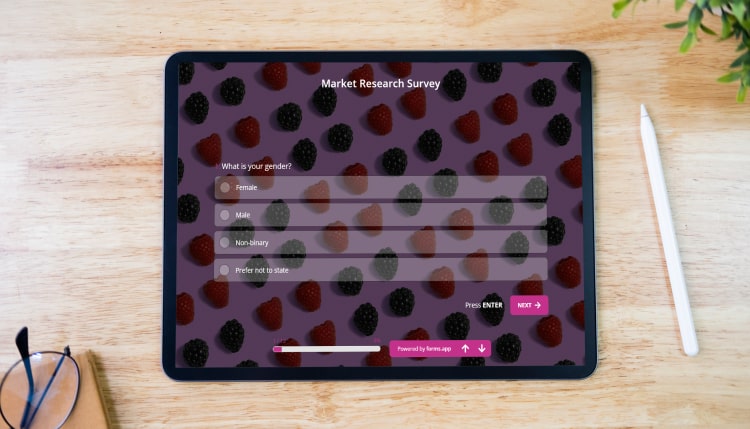
- Benefits of using online market surveys
Creating a market survey does not take long, and its gain is ten folds. However, you may be thinking what are the benefits of using this survey and what you can gain. There are numerous benefits of using market surveys, but to name a few:
- Using market research questionnaire templates allows you to measure brand awareness.
- Allows you to gain insights into your customers.
- Works fast and efficiently to obtain the data.
- Allows you to analyze a target market.
- Helps you plan future products and services.
- Allows you to gain critical customer feedback
- Online market research survey types
Online market research surveys allow businesses to collect data from a large number of people in a short amount of time. There are many different types of online surveys, but the most common are questionnaires and polls.
There are many different online survey tools that businesses can use to create and distribute surveys. For example, Google forms and forms.app are some of the most popular online survey tools .
When creating an online market research survey, businesses should consider their target audience, the type of data they want to collect, and the length of the survey. Businesses should also create clear and concise questions that are easy for respondents to understand. Surveys that are too long or have confusing questions will likely result in low response rates.
Here are some examples of different types of online market research surveys :
- Customer satisfaction survey : This type of survey is used to collect data on how satisfied customers are with a product or service. Customer satisfaction surveys typically include questions about the respondent's experience with the product or service, their level of satisfaction, and whether they would recommend the product or service to others.
- Demographic survey : This type of survey is used to collect data on the characteristics of a target market. Demographic surveys typically include questions about the respondent's age, gender, income, education level, and location.
- Product research survey : This type of survey is used to collect data on people's opinions of a product. Product research surveys typically include questions about the respondent's experience with the product, their level of satisfaction, and whether they would recommend the product to others.
- Market trends survey : This type of survey is used to collect data on people's opinions of current and future market trends. Market trends surveys typically include questions about the respondent's opinions of current market trends and their predictions for future trends.
- Tips for creating market surveys
You can get great results by using an expert survey builder, such as forms.app. forms.app offers many templates and customization options. In addition to all these smart features you can get the best possible results by having these tips in mind:
- Consider your target audience
- Decide on the type of data you want to collect
- Make sure the length of the survey is not too excessive
- Create clear and easy-to-understand questions. Surveys that are too long or have confusing questions will likely result in low response rates
- Customize your survey with forms.app
- Examples of market research surveys
As a business owner or a manager, you may be looking for market research surveys and helpful tools. If you already have a vision in your mind and set your mind on what you want, the next step is to find the right tool. That great tool is forms.app!
forms.app is a powerful survey maker that can help anyone. Its easy-to-use interface eases the survey creation process. forms.app offers hundreds of useful templates and many colorful and adjustable themes. There are many options for market research surveys.
For example, market research survey template is a great start to getting to know the market and the customers’ needs. Or, speaking of customers, the customer research survey is the key to getting into the minds of your clients. Additionally, if you are planning on launching a new product or you want to evaluate the success of your existing product, product research survey template is perfect.

Market Research Survey Template
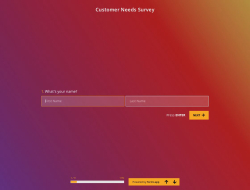
Customer Needs Survey Template
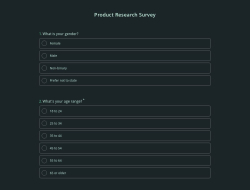
Product Research Survey Template
- Our verdict
In a competitive business world where you always have to be one step ahead, knowing your customers is a must. You can plan the future of your company by listening to your clients’ wants and needs. That is the number one key to success in professional life. And, what better way to do it other than using an online survey?
By using the appropriate market research survey or questionnaire, you can easily learn if your clients are satisfied with the service or product you give them. Additionally, as a great survey tool, forms.app will help you tremendously when creating your web survey.
The best survey tool: forms.app
If you have any questions on how to create exquisite forms and surveys , you can check out forms.app today. It is a great tool that allows you to customize your survey according to your wishes and serves helpful tools such as conditions . It is an excellent means to go into specific details.
No matter the survey you choose, you will surely benefit from it because data is knowledge in the modern competitive business world. And, learned data from surveys will help you build a road map. As marketing scientist and author Dan Zarrella said :
“Marketing without data is like driving with your eyes closed.”
Defne is a content writer at forms.app. She is also a translator specializing in literary translation. Defne loves reading, writing, and translating professionally and as a hobby. Her expertise lies in survey research, research methodologies, content writing, and translation.
- Market Research
- Form Features
- Data Collection
Table of Contents
Related posts.
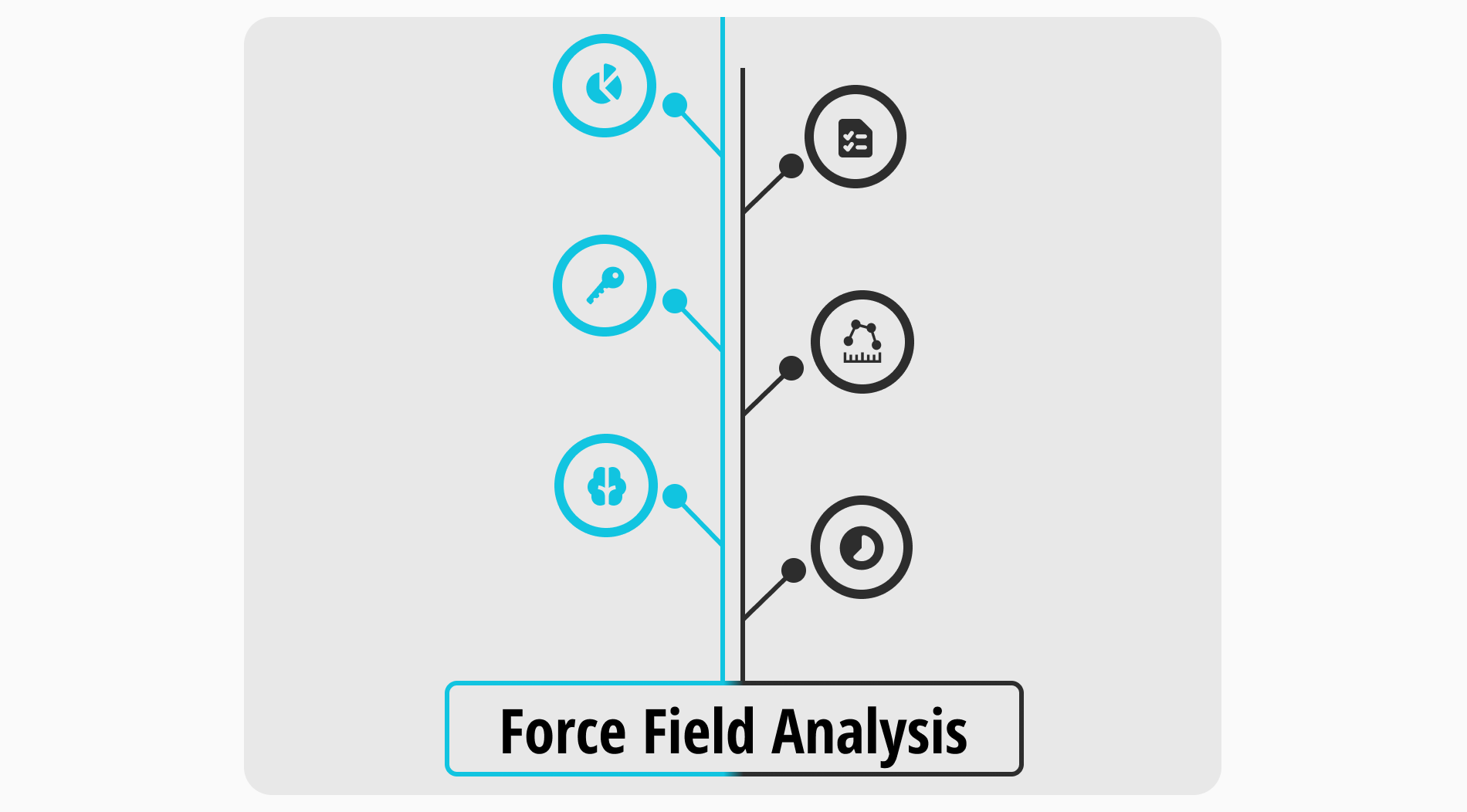
A complete guide to force field analysis (+Examples)
Fatih Serdar Çıtak
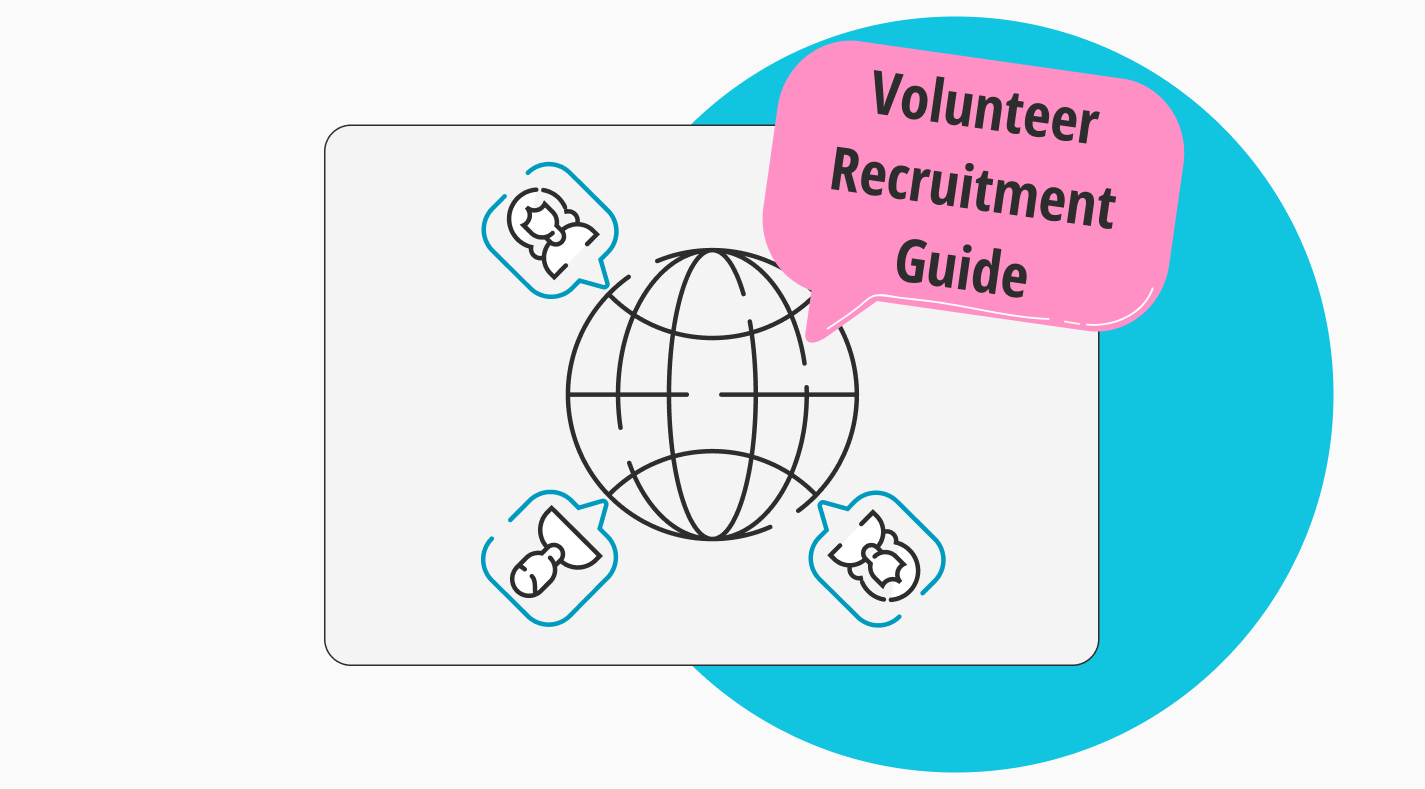
Volunteer recruitment: A complete guide
Sevgi Soylu

Starting an online retail business with order forms

Advisory boards aren’t only for executives. Join the LogRocket Content Advisory Board today →

- Product Management
- Solve User-Reported Issues
- Find Issues Faster
- Optimize Conversion and Adoption
Different types of market research surveys (with templates)
Product design is a bit of a “chicken and egg” situation — should we get the product idea first and then attempt to find product-market fit (PMF), or research a market to see if there’s a product that’s missing from it? Well actually, both are great approaches and market research surveys can help with either of them.

In this article, you’ll learn about the different types of market research surveys, what each type is useful for, and what questions to put in them to ensure that you make great data-driven decisions about your products and overall brand.
Table of contents
What is market research, what is a market research survey, buyer persona surveys, competitor analysis surveys, brand awareness surveys, market-field research, market research diary studies, market research interviews, market research focus groups, market research conjoint analysis.
Market research is the process of gathering information about a market. More specifically, the customers and opportunities to thrive within it (if any), and how it feels about your products and brand if such exists. In a nutshell, this information is used to determine product-market fit .
Market research surveys are used to map out markets and the customers within them, determine target markets, reposition brands within the markets that they’re already in, or simply just reaffirm that the products are in the best positions and that the brand is perceived in the right way.
Now let’s take a look at the different types of market research surveys.
The different types of market research surveys
There are different types of market research surveys. We’ll cover the following:
Buyer persona surveys are used to understand who buys the type of product you’re selling or thinking about selling. This is the market research survey you’d start with but also carry out periodically, investigating further should the market appear to change.
These are the questions that I’d ask (but feel free to adapt as necessary):
- What is your age?
- What is your gender identity ?
- What is your highest level of completed education?
- What is your employment status?
- What motivates you to [buy/subscribe to] [product]?
- What is your average [e.g., monthly] spend on [product]?
- How important are the following factors when [buying/subscribing to] [product]?
- How do you typically learn more about [product]?
You can access this buyer persona market research survey template on Google Docs:
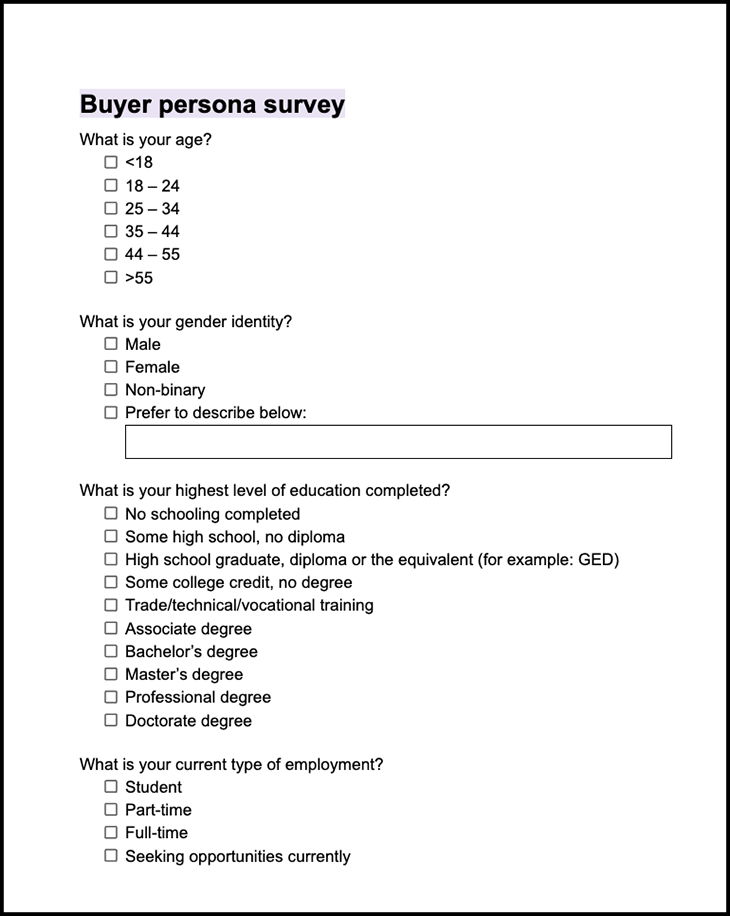
Find out where customers of the product “hang out” and send them this survey.
You won’t acquire any insights from observing the results at face value — you’ll need to identify trends within them. For example, different age demographics might have different motivations for buying. For this reason, you’ll usually learn about the size and motivations of multiple submarkets as well as the market overall.
You’ll also learn where customers hang out most by the number of responses per source. In addition, the “How do you typically learn more about [product]?” question provides additional sources of respondents to the survey.
Ultimately, you’ll learn who and where.
Competitor analysis surveys are used to see how dominated, underserved, or untapped a market is. They’re also used to discover opportunities for improvement, the shortcomings of rivals to exploit, and even fresh product ideas. When combined with buyer personas, you’ll be able to position or reposition your product in the market, or if necessary, call it a day and exit the market entirely.
Again, these are the questions I’d ask (adapt as necessary):
- When you hear “[product]”, who comes to mind?
- How often do you see their marketing campaigns?
- (Conditional) What do you like and/or dislike about them?
- (Conditional) How do they compare to us?
- (Conditional) Why did you choose that answer?
- (Conditional) How likely are you to choose their [product] over ours?
You can access this competitor analysis market research survey template on Google Docs:
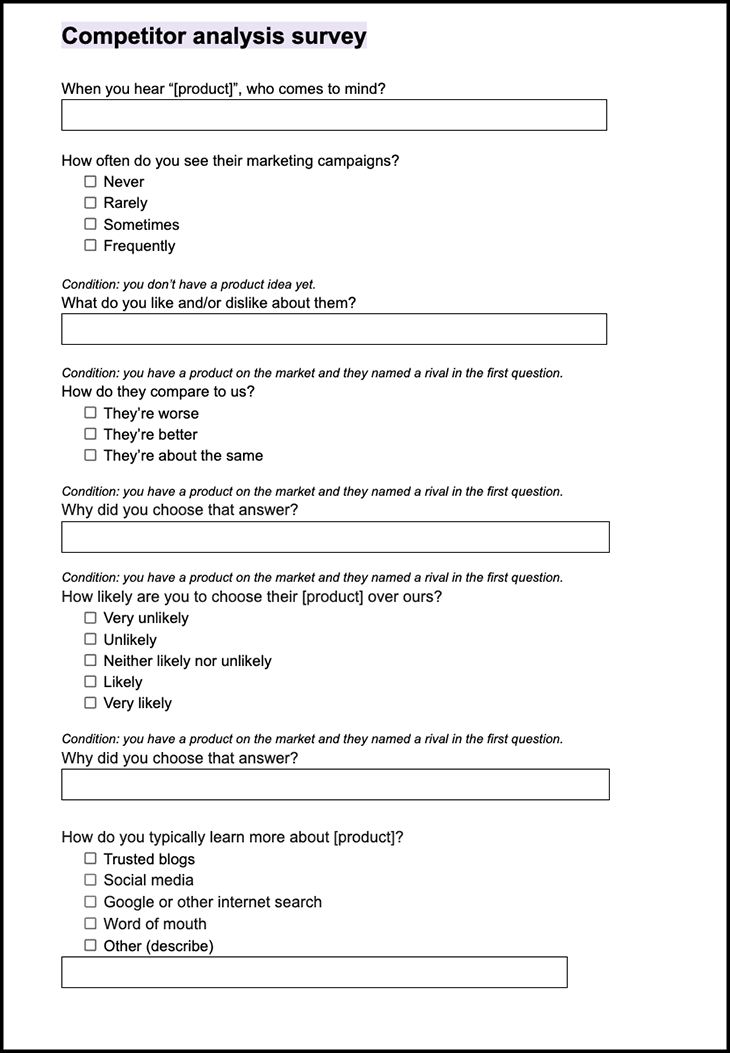
The audience for this survey is the same as that of buyer persona surveys — customers who use the type of product in question. Run it periodically, especially if you’re seeing low sales. However, if you’re fishing for a product idea, start with this survey (feel free to be a bit more vague; for example, ask about coffee rather than coffee shops) and then lead into your buyer persona survey after that.
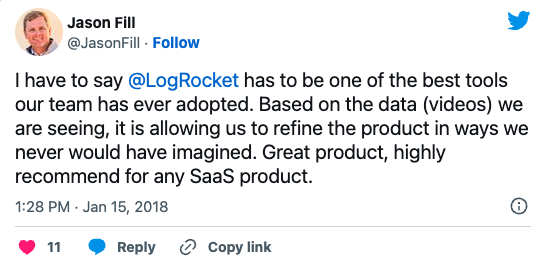
Over 200k developers and product managers use LogRocket to create better digital experiences
Competitor analysis surveys are a bit more qualitative than buyer personas, so you’ll want to synthesize the data by using affinity mapping to quantify the insights.
You can use brand awareness surveys to see how your brand is perceived by a target market. This is less about product needs/wants and more about how people see your brand overall, which in turn affects whether or not people are willing to consider or recommend your products.
Sometimes it can seem like you’re doing everything right, yet the market looks to your competitors. In this case, it could be that people are just unhappy or unaware of your brand, and this is where brand awareness surveys come in. Previously mentioned market research surveys cover brand awareness a bit, but this focuses on it.
These are the survey questions I’d recommend:
- How familiar are you with our brand?
- How did you first hear about our brand?
- How often do you see our marketing campaigns?
- Have our marketing campaigns influenced you to buy from our brand?
- Have you used our products before?
- Which of our products have you used?
- How likely are you to recommend our brand to friends or family?
And here’s the brand awareness survey template for you to adapt and use:
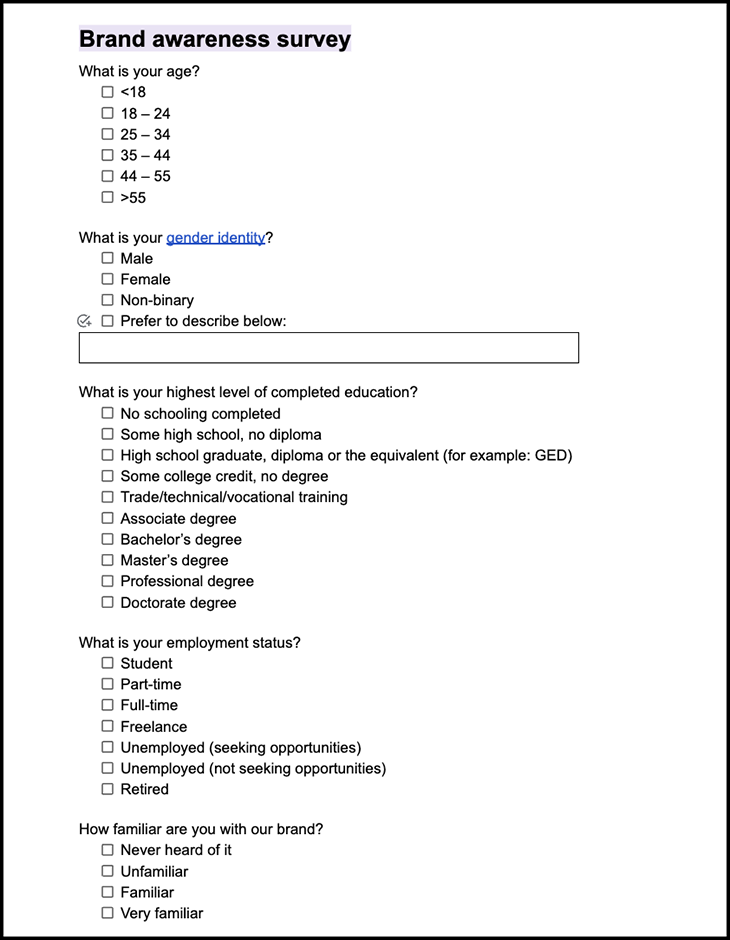
Send this one to your target market specifically.
It’s a quantitative survey, so once again, synthesize the results using affinity mapping and then use the insights to make data-driven decisions about your brand.
Other types of market research
Market research surveys should be utilized alongside other types of market research. Let’s take a quick look at what those types are.
With market-field research, you’d carry out your survey in-person and more contextually. For example, if you were researching an existing or potential market for coffee shops in a neighborhood, you’d benefit from surveying people at those establishments or whatever you think is the next best thing. You can approach this as a 1:1 interview or as what’s referred to as participant observation (which in this scenario is coffee and casual conversation!).
There’s also direct observation, where you’d just observe from a distance (in this scenario, you’d perhaps observe how long customers spend in coffee shops). If you’d really like to lean into this type of market research, I’d suggest doing both as part of a general market-field research case study.
Also, ethnography is a type of field research where entire social settings are observed, but this has very few use-cases.
The point of field research is to catch people in context, where their thoughts and feelings are at their most intense. Diary studies are similar, except that participants will record their experiences with a product (or lack thereof) over a specific course of time. Do whichever feels most applicable.
Market research interviews are 1:1 conversations to be used in place of market research surveys or as follow-ups to them.
Market research focus groups are essentially interviews but with all of the interviewees at once. The main benefit of focus groups is that a participant’s remark can help other participants to discover their unconscious thoughts. They’re also faster than conducting 1:1 interviews individually, but slower than surveys.
Different people open up in different situations depending on their personality type, so if resources allow I’d recommend doing all of them.
Conjoint analysis helps you to determine how much customers are willing to pay and for which features. If you’ve ever come across a useful feature but the overall product seemed expensive and/or had too many unwanted features, you either weren’t the target market for it or they didn’t do any conjoint analysis.
There are also many types of product pricing surveys — generic price testing , willingness-to-pay, price laddering, Van Westendorp’s price sensitivity meter — that are typically used during the product design process. While these are more for product research than market research, they can still be useful and you’ve probably done them already, so the best way to avoid reinventing the wheel is to see what kind of insights product designers are already sitting on.
Closing thoughts
Market research surveys are extremely useful for defining target markets, actually targeting them, repositioning ourselves within the markets that we’re already in, or reaffirming that we’re already in the right positions for product success.
However, market research surveys alone aren’t enough — we must also utilize other types of market research (as mentioned above) and utilize them in a strategic way. Kimberly Hale put together a great high-level guide to the overall market analysis process that demonstrates how to approach market research strategically.
As always, thanks for reading. Drop your thoughts and questions into the comment section below!
Featured image source: IconScout
LogRocket generates product insights that lead to meaningful action
Get your teams on the same page — try LogRocket today.
Share this:
- Click to share on Twitter (Opens in new window)
- Click to share on Reddit (Opens in new window)
- Click to share on LinkedIn (Opens in new window)
- Click to share on Facebook (Opens in new window)
- #market analysis
- #tools and resources

Stop guessing about your digital experience with LogRocket
Recent posts:.

A guide to mastering the product sense interview
A product sense interview measures a candidate’s ability to understand users deeply, frame problems clearly, and generate creative solutions.

Building a competency matrix for product job families
A competency matrix is a structured framework organizations use to evaluate, align, and map skills across different roles.

Scrum master vs. product owner (PO): Key differences and roles
It’s important to distinguish between these roles and create an infrastructure where they come together to build useful products.

Memo format guide: How to write a memo with examples
Memos don’t have to be complicated. Just keep them clear, concise, and focused on actionable items. More on that in this blog.

Leave a Reply Cancel reply
- Market Research
Market research surveys: all you need to know
- November 7, 2022
You know you should spend more time conducting market research surveys, but keep pushing it to the bottom of your “to-do” list.
Don’t worry. You are not the only one. Many get overwhelmed by the thought of market research because it feels like ‘too much work’.
You don’t need to be a research expert or a data scientist — all you need is to write practical survey questions, reach out to your audience, and analyze their response. If done correctly, surveys offer many insights into how your customers feel about your business and what you can do to improve.
Let’s break down everything about market research surveys in this article and help you get started quickly.
Table of Contents
What is a market research survey?
Why use market research surveys, different types of market research surveys., step 1: write down your survey questions., step 2: choose a survey platform. , step 3: run a small pilot or test survey., step 4: launch the survey, reach out, and record insights., step 5: analyze the insights., improve your market research survey insights with customer reviews..
A market research survey is a method for conducting qualitative research to gather opinions from your target audience. It offers valuable insights to understand your customers better and help in decision-making.
A market research survey is the most popular and favored tool among researchers, business owners, and entrepreneurs.

A market research survey gives you a hang of the consumer pulse to help you stand out in a competitive ecosystem.
If you have been building and growing something, you would have dreamt of ‘getting inside the head’ of your customers, probably more than once. A market research survey is a tool that makes your dream come true.

A market research survey is like a portal that allows you to peek into your audience’s mind and use the knowledge to improve your business. They’re quick and easy to create and, when conducted well, give your business enough information to:
- Find untapped market opportunities
- Create and/or improve your product
- Optimize your value proposition
- Improve your marketing effectiveness
- Delight your customers
Read More: Why is market research important?
- Online Surveys: Online surveys are the most popular out of the lot and are conducted using a market research tool or platform. You share a survey link with respondents and analyze the results afterward.
- Paper Surveys: Manual surveys are generally conducted when a researcher is in direct contact with the respondent. Such surveys are part of focus groups or a research panel.
- Mail Surveys: Sent to respondents by physical mail, these have become obsolete with the penetration of the internet in modern times. They are still used in some industries that need hyper-local insights.
- Telephonic surveys: Interview-style surveys conducted over a phone call. Online connectivity has now added another element — video to telephonic surveys, which helps analyze the sentiment of the respondent too.
- Face-to-face surveys: Conducted in person by a researcher or an entrepreneur, these surveys require a lot of time, money and effort. Useful for market research in high-ticket industries like precious metals, jewelry, or real estate.
- Panel surveys: Panel surveys are conducted with a sample set of respondents, i.e., a focus group with representations from all the target audience segments for accurate insights.
How to conduct a market research survey.

Okay! Now that you know the fundamentals, let us move on to the process of creating your first survey. Here are the steps you should follow to launch a market research survey:
Questions are like the soul of your market research survey. The right questions will give you the desired insights to make informed decisions.
Before you even think of planning market research, spend time crafting your market research survey questions. While you are at it, keep the following things in mind:
- A market survey questionnaire should be made with a single goal, like searching for untapped market opportunities or finding pain points with an existing product.
- Every question should be straightforward and should not confuse the respondent at any stage.
- Do not over-optimize survey questions to lead the respondent into sharing a biased response. Leave room for opinions and preferences by mixing different types of survey questions.
Writing effective survey questions is an art as well as a science. If you are unsure about the questions you should include in your survey, you can look for survey question examples online to get inspired.
Also Read: Market Research Questions
Once you have written relevant questions for your survey, you need a way to share these questions with respondents. If you are conducting an online survey, you should sign up for a market research survey platform to get started.
A tool like Typeform can help you set up a market research survey, share it with respondents, and gather insights. Remember to try multiple tools before you finalize a survey platform for your market research surveys.
Read More: Best Market Research Tools in 2022
Now, you have the questions, a way to share your surveys, and a platform to analyze the insights.
Technically, you should move ahead to launch your survey, but wait, don’t just rush into launching your survey for the public yet.
Instead, share your survey link with a small batch of ideal respondents. Think of it as a testing phase that will help you improve your chances of gathering valuable insights.
A small test or pilot will help refine your survey questions and set the right expectations. You will understand how people respond to your questions and get a chance to address red flags such as:
- Non-responsive prospects or audience.
- Non-serious or one-word responses to your open-ended questions.
- Too many ‘none of the above’ answers in your opinion-based questions.
- Skewed metrics reflecting the same (or similar) response from the entire audience pool.
When you conduct a pilot and get into any of the above scenarios, you should spend more time refining your survey questions. Also, consider expanding your respondent pool or factor in for margin of error to ensure you get desired results from your survey.
After you have got desired response from your pilot, you can launch your market research survey to all the respondents.
Reach out to respondents, asking them to complete the survey honestly and allow them enough time to complete it. Depending on the market survey type, region, and industry, it can take days to even months to receive all the responses. Sometimes, people are busy, so don’t jump to conclusions early.
The survey tool you pick will automatically record all the responses that you can access at a later stage to start market research analysis.
This is the final step of the process, and think of it like sitting on top of a gold mine.
Any tool that you pick will have a reporting dashboard that will give you access to basic insights, like individual responses, trend charts, and general statistics about your survey.
Start analyzing the reporting dashboard and make notes to improve your understanding of the audience. Check for cues to validate your hypothesis, make notes of any new insight that was not evident before, and start preparing a document highlighting key takeaways.
In case you need more profound insights, you can also export the insights to advanced data analytics tools like Tableau. Though, this depends on your need and goals from a market research survey. You can also use Google for market research to expand your understanding of gathered insights.
Conducting a market research survey is a lot of work that can sometimes take weeks to months. While it is definitely a good source of valuable insights, sometimes it is not feasible in an era of agility and continuous innovation.
That might be the reason that has stopped you from starting market research until now. You must be thinking if there is a better way to access insights without wasting time, effort, and money.
Well, you can use online reviews to speed up market research. In a connected world, your target audience, prospects, and customers already share their thoughts, opinions, and valuable insights on social media, forums, and review platforms. You can use these to conduct market research and drive decision-making regarding your product, marketing, and value proposition.
GapScout analyzes existing online reviews and collates real-time customer insights on a single dashboard. You can use real customer feedback to identify opportunities, develop new products, optimize pricing strategy, drive marketing and make important decisions while saving time and money.
So, stop thinking and drive your market research efforts in real-time with customer reviews using GapScout.
Ready to Automate Your Market Research? Get exclusive access to GapScout prior to release!
Share this:
The best in market research.
Market research tips & tools sent to your inbox.
By clicking Subscribe, you agree to our Terms and Conditions.
Popular Articles

Market research future: 5 trends

10 proven conversion optimization tips (with examples)

How to use storytelling to create buyer personas
Email us: [email protected] Made with ♥ in sunny California
- Legal Policies
Sign up for early access here!
ⓒ 2023 GapScout. All rights reserved.

Get Early Access!
Sign up to get early beta access to GapScout before it becomes publicly available!
We use cookies to give you the best possible experience on our website.

6 types of market research surveys and how to create one
Continuous improvement is what makes you stand out from other players in your respective industry and helps you engage your target audience.
The preferences of your customers change over time, along with their buying behaviors and market dynamics. To survive the cutthroat competition, it’s vital to constantly improve your solutions.
But how do you identify the changes that need to be made or find where there’s room for improvement? Conducting a market research survey may help.
When it comes to improving your solutions, the best source of information is your current or potential customers. So, reaching out to them will help you access relevant insights that steer you in the right direction.
Market research surveys enable you to collect extensive feedback from your customers. They allow you to explore behavioral dynamics and extract actionable insights from customer experiences.
This makes it easier for you to improve your products and promote them to the right audience in an efficient way.
There are different types of market research surveys. You can go with one or several that pique your interest.
In this article, we’ll explore different types of market research surveys and discuss a step-by-step process to create one.
So, without further ado, let’s get started.
6 types of market research surveys
There are a variety of market research surveys that you can leverage to collect useful information and make data-driven decisions when it comes to improving your products and offering seamless experiences. We’ll be discussing the six of the best.
Online surveys
Online surveys enable you to reach out to your target audience or customers anywhere in the world and collect the required information from them. People only need an internet connection to participate in the survey and share their experiences or preferences with you.
There are a number of solutions that you can leverage to create an online survey. You can either choose to go with free solutions such as Google Forms for simple surveys, or a Google Forms alternative , as well as other premium form builders for more advanced design features.
The tools will generate a survey link for you, which can be easily accessed by the chosen participants.
This survey type is ideal for exploring the changing preferences of your target audience, collecting feedback about your products, and assessing customer satisfaction.
Telephone/virtual call surveys
If you want to access in-depth insights and detailed feedback from your audience, conducting a market research survey via telephone or virtual calls may be your best bet.
Telephone surveys are generally preferred to reach out to participants who are a little less tech-savvy and not acquainted with modern communication methods.
For example, if your audience comprises elderly individuals, reaching out to them via phone may be the best strategy to get useful information. However, you can choose to conduct a survey through a virtual call if the participants prefer using modern communication solutions.
This survey method is best suited when you ask open-ended questions, facilitating your access to detailed responses and valuable insights for decision-making.
Face-to-face surveys
Conducting telephone or virtual call surveys is an effective way to gather useful information by asking open-ended questions. However, you may come across problems like a low response rate.
This is the reason why many resort to face-to-face surveys and personally reach out to the participants. Plus, interacting with the participants face-to-face ensures a high response rate, especially when your survey is lengthy and requires more time to complete.
Face-to-face surveys provide you with the opportunity to connect with your audience on a deeper level. The method enables you to probe for more detailed answers that can help you devise efficient business strategies .
Mobile surveys
Mobile surveys encourage participants to submit their responses using mobile devices. People can respond to your questions using their smartphones or tablets.
Nowadays, people are always on-the-go and use mobile devices to access useful information or interact with their preferred brands.
So, optimizing your surveys with mobile-first experience in mind is an efficient way of collecting relevant insights and required information from your current or potential customers.
Mail/email surveys
People may have diverse preferences when it comes to contacting their preferred brands. However, 60% of people prefer to be contacted by businesses via email .
Hence, conducting email surveys may be an efficient way to engage the intended audience and collect the required information from the participants.
You can ask questions directly in the email sent to the recipients or add a survey link in the email body. It’s one of the most cost-effective ways to gather insightful data at a mass level.
Leveraging social media is one of the most efficient strategies to explore the changing behavioral dynamics of your audience and market trends .
There are over 5 billion social media users worldwide , enabling you to cast a wider net and reach out to your target audience anywhere in the world.
Polls are one of the most common types of market research surveys that brands use to collect useful information from their respective audiences through social media . They generally comprise a single question paired with a variety of responses to choose from.
Polls are best suited to find out what the majority of your audience wants or to know their opinion. For example, you can ask your audience about a particular feature they would like your solution to offer or identify areas for improvement.
You can leverage polls to engage your target audience with ease and gather useful insights from them in no time.
How to create a market research survey
Now that we have discussed different types of market research surveys, let’s dive into the process of creating one that can help you access relevant insights.
Define your objectives
The first step to creating a market research survey is to clearly define your objectives. The goal here is to collect useful data. So, it’s best that you know what to do with it.
For example, you are planning to launch an online project management solution and want to conduct a market research survey to make informed decisions.
In this case, your survey objective may be to know what your target audience expects from an ideal online project management solution.
They must have come across different alternatives in the industry. So, they can share meaningful insights with you that can help you outmaneuver the competition by offering better project management features or capabilities.
Know your audience
Once you have set clear goals for the survey, the next step is to identify an audience best suited to participate in the survey.
Carrying forward the aforementioned example, if your goal is to launch a feature-rich project management solution, your target audience may comprise project managers, entrepreneurs, and small business owners.
Encouraging them to participate in your survey will help you get acquainted with their needs or preferences . As a result, you may be able to design a project management solution that offers a seamless user experience and helps you establish lasting customer relationships.
Craft engaging questions
After identifying your target audience, you should move on to the next step, which is designing the market research survey.
If your goal is to launch a feature-rich online project management solution, you should ask questions that pave the way for you to come up with capabilities superior to the competing products.
Your questions should be clear, concise, relevant, and easy to understand. Your objective is to collect useful information from the participants, not confuse them.
Furthermore, you should refrain from designing lengthy surveys with unending questions, as it will severely affect participation or response rates.
Choose the right survey method
It’s not necessary to stick to a single survey method when it comes to collecting information from your participants. You can leverage different types of surveys to gather relevant insights.
To see which method works for you, you can test them all and go with the one that gives you the best results.
Let’s say your audience comprises project managers, entrepreneurs, and small business owners. These people are less likely to respond to polls, telephone surveys, and emails. Furthermore, you may have to make an appointment to meet with them face-to-face.
Similarly, if you're conducting ux research to design successful products, you'll probably need to schedule user interviews or card sorting sessions to find out what makes sense to your users.
So, online or mobile surveys may help you engage the intended audience. However, the selection of the right survey method may vary from one scenario to another.
Analyze and interpret data
Once you’ve gathered responses from your participants, the next step is to analyze and interpret the data collected. There are a variety of data analysis solutions that you can leverage to analyze the data and draw conclusions.
The software you choose to go with and the analysis technique depend on the complexity of your potential findings.
If you simply want to discover the most sought-after project management software features by participants, you can simply choose to go with Excel. However, if you want to run complex analysis, you may want to consider solutions like Python, SPSS, Minitab, R, SAS, and more.
Once you’ve analyzed the data, the next step is to interpret the results and make data-driven decisions.
Final thoughts
In this article, we discussed different market research survey types and how you can create a market research survey to gather useful information from your target audience.
Conducting a market research survey helps you get acquainted with the preferences of your current or potential customers and stay tuned to market trends.
The findings from these surveys pave the way for you to make smart decisions and stand out in the competitive landscape .
So, if you’ve been planning to conduct a market research survey, the information laid out in this article may help.
Product marketing insider
Thank you for subscribing
Level up your product marketing career & network with product marketing experts.
An email has been successfully sent to confirm your subscription.
Ops! Something went wrong!

- Media Guide
- Ambassadors
- Privacy Policy
- Terms of Service
- Help Centre
- Product marketing tools
- Product Marketing Certification
Market Research Surveys: Sample Questions + Template

Sample Questions
- Creation Tips
- Types of Data
- Employee Feedback
- Creating the Survey
- Identity Protection
- Research Tools
Need a survey tool? Features include MaxDiff, conjoint, and more!
Definition: Market research surveys are a tool used to collect information about a target market. These surveys allow businesses to understand market needs and preferences.
Your company can offer better products or services by understanding your target market. Often, market research surveys will also include questions about competitors. Competitor data help paint the complete picture of your target market.
Depending on your goal, you want to include different question types in your survey. Here are three general categories of question types to include:
- Customer demographic questions
- Product/service questions
- Company/brand questions
Customer Demographic Questions
These questions will help you to understand your audience better. In addition, this data can be used to create market segments.
- What is your age range?
- What is your marital status?
- What is the highest level of education?
- What is your monthly income?
- Which of the following online retailers do you use most often?
- How many hours a week do you spend doing [task]?
- How did you find our company?
Product or Service Questions
When researching a product or service, you want to find out what attributes customers find most valuable in addition to a proper price point. MaxDiff will help you determine what is least and most important for this type of research, while Gabor Granger and Van Westendorp will help you find the optimal price points.
Important note: Don’t ask customers what they would pay for a product or service using an input box. The data will be unreliable. Instead, we recommend using a Gabor Granger question to determine optimal price; this question mimics real-world buying decisions where random price points are evaluated.
Asking about competitors is also essential when drafting product or service questions. Understanding the competition will help your own company build better offerings.
- Of the following features, which are LEAST and MOST important to you?
- Does this product help solve your problems?
- Is there any feature you wish a competitor offered?
- Was our product easy to use?
- How would you evaluate the following price points when purchasing this product?
Company/Brand Questions
When asking questions about your company or brand, the key focus should be on asking the Net Promoter Score question. This question asks, “How likely is it that you would recommend this company to a friend or colleague?” with options from 0 to 10. The overall score will range from -100 to 100 and can be benchmarked against other companies.
Some additional questions in this area could include the following
- Do you understand what our brand stands for?
- Of the following terms, which do you associate with our brand?
- When thinking of a new [product] to buy, which of the following brands first comes to mind?
Tips to Create a Great Market Research Survey
Create an objective:.
Once you get the data, what actions will you take with it? For example, do you want to research features or pricing? Whatever the objective is, make sure it is clear. This will ensure the right questions are asked to gather valuable data.
Determine How to Collect Responses:
Do you have a customer list or want general consumers’ opinions? We recommend using your own customers as a starting point for market research surveys. Then you can add in a targeted survey panel to grab more general consumer opinions.
Here is a sample size calculator to determine your needed sample size. This data will enable you to know how many responses you need to collect based on the overall population you are studying.
Use Crosstabulation:
To spot hidden trends and relationships, use cross-tabulation . For example, you could create a cross-tabulation report for a MaxDiff question with gender. Then you can see what product each prefers features. This can be used for marketing or to decide what target market would be more profitable.
Keep Your Survey Short:
No one wants to be overwhelmed. A study by Survicate found that surveys with 1-3 questions had an 83% response rate. Use skip logic to hide irrelevant questions from users that do not meet specific criteria.
Offer Incentives:
Offer incentives! Offer respondents a discount if they take your survey. This will help drum up new business and ensure you can collect the data you need.
Why Use Market Research Surveys?
Research a target market:.
Your target market is the consumers who would find your product or service most helpful. So first, create a survey to discover opinions on a product or service and respondent demographics such as age, income level, or education level. You can segment your results from here and find out what characteristics make up your target market.
Market Segmentation:
Now that you know your general target market, a more specific group of those people is known as a segment. With the dealership example, maybe you realize consumers in your area and target market love Audi but hate BMW. Luxury cars and people of the same income level drive them, but this difference in product preference is a segment. Knowing this is key to offering the correct brands or prices.
Competitor Analysis:
Often called SWOT analysis (strengths, weaknesses, opportunities, threats), analyzing your competition is key to gaining market share. Go directly to consumers and ask about their opinions on competitors. Ask questions about what they do well or what you do well. Your survey results will help you identify opportunities for growth or ways your company needs to change to stay competitive.
Product Launches:
Does your product meet your customers’ needs? Sending an online product survey to customers will help you gain insights that drive improvements, consumer satisfaction, and ultimately, sales. When measuring the importance of product features, include a MaxDiff question. Additionally, you can enhance product feedback presentations using tools like an AI video generator to create engaging videos that summarize key insights visually.
Types of Market Research Data
Of course, surveys are only part of market research. You might be able to shorten your survey if you can collect data from other places first.
Primary Information (aka Field Research):
First step in marketing research is information YOU collect specific to your objective. This type of information is most often collected via surveys! For example, you might want to open up an arcade in a small town in the United States. You can send out a survey to a sample of the town’s residents to get demographic information and if they are willing to visit your arcade.
Secondary Information (aka Desk Research):
Secondary market research is information YOU DO NOT collect specific to your objective. This type of data is already available to you in public government databases, journals, publications, or even Google! For example, let’s say you were interested in starting your luxury car dealership. You could look at government census data for income levels for your target market before conducting your detailed research. Secondary information should help narrow down what preliminary information you need to collect.
ABOUT THE AUTOR
Allen is the lead developer for SurveyKing. A former CPA and government auditor, he has a passion for data and has helped SurveyKing serve customers worldwide.
Ready To Start?
Create your own survey now. Get started for free and collect actionable data.

23 SurveyMonkey Alternatives to Use in 2024
Discover alternatives to the most popular online survey tool, SurveyMonkey. Gain an understanding of where SurveyMonkey lacks in features and get intr...

Creating an Anonymous Employee Survey + Template
Definition: An anonymous employee survey is a convenient way to collect honest feedback in the workplace. The survey can either measure employee satis...

10 Survey Tools for Academic Research in 2024
These nine survey tools are perfect for academic research because they offer unique question types, solid reporting options, and support staff to help...

8 Best Strategies of Survey Promotion to Increase Response Rates
Survey promotion is the process of spreading surveys through different channels to encourage more responses and participation. It involves placing the...
Business Process Improvement Consulting: Expert Solutions
Definition: A business process improvement consultant will help design and implement strategies to increase the efficiency of workflows across your o...
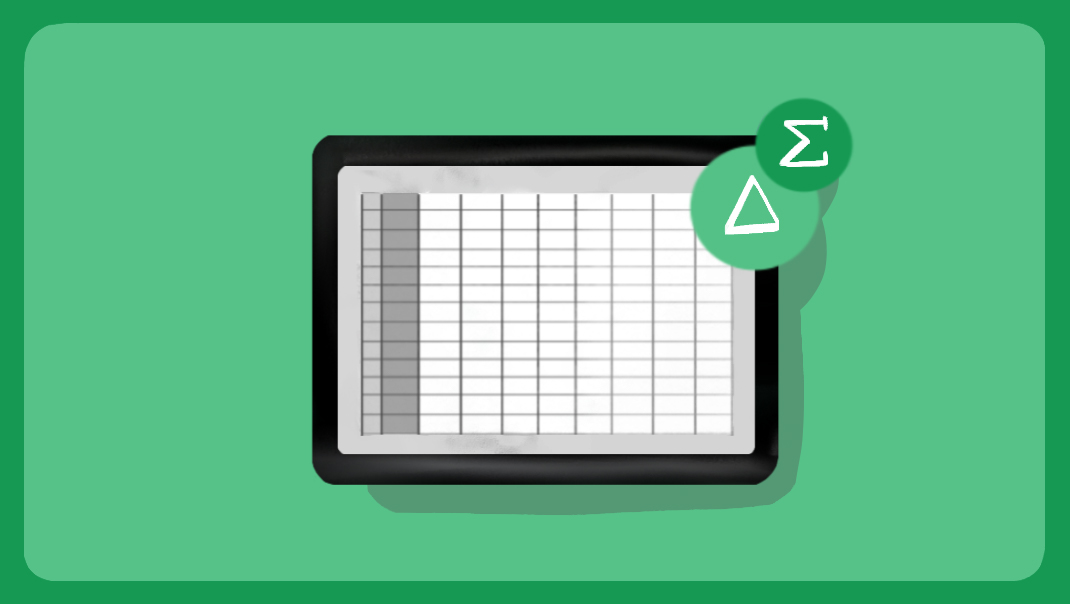
8 Excel Consulting Services to Use in 2024 + VBA Support
These 6 Excel consulting firms offer support, training, and VBA development to help you automate tasks and increase efficiency when using Microsoft Ex...

7 Great Qualtrics Alternatives to Use in 2024
These seven alternatives to Qualtrics offer either more features, a lower cost, or a cleaner user interface. These alternative platforms also include ...

Union Negotiation Consulting: Planning Labor Agreements
A labor union negotiation consulting engagement involves quantifying member needs, proposing contract language, and developing communication strategie...
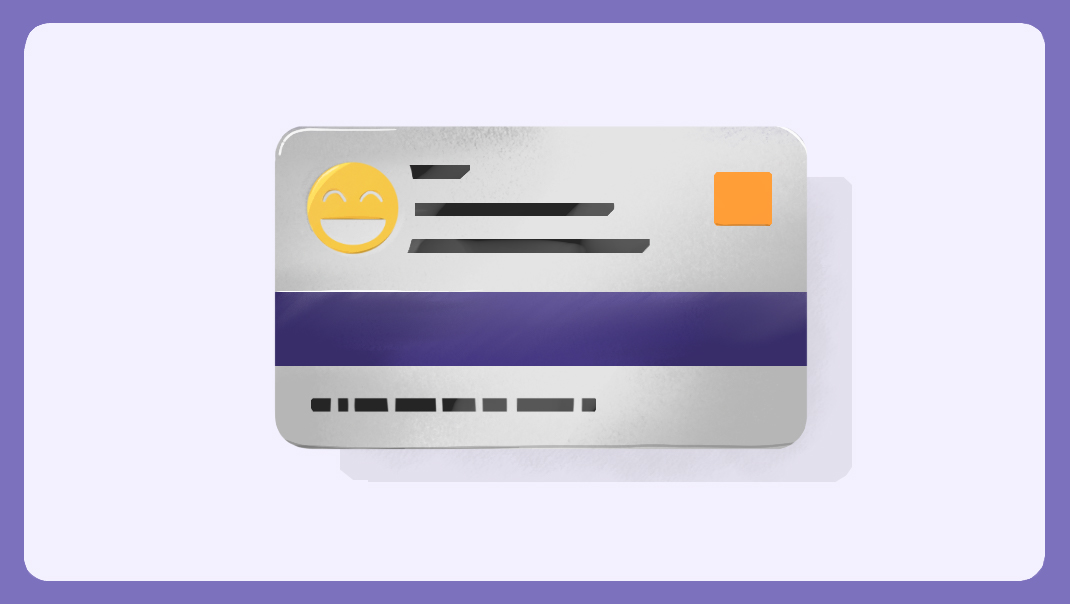
Creating a Transactional Survey: Examples + Template
Definition: A transactional survey captures customer feedback after a specific interaction, referred to as a touchpoint. This survey type provides dir...
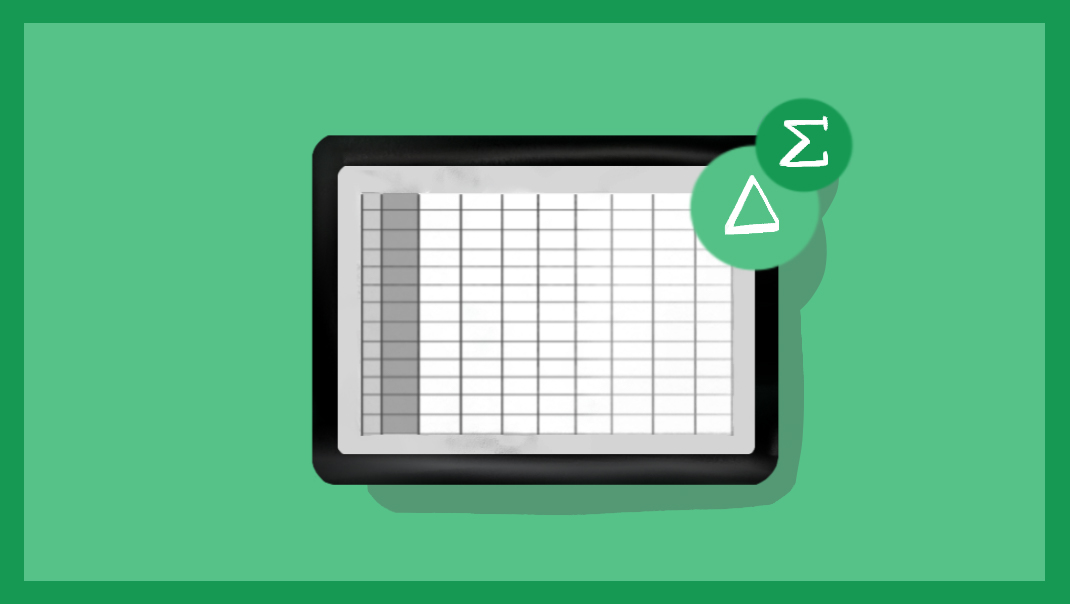
Hire an Excel Expert: Automation + VBA Development
An Excel expert will help you to complete your projects within Microsoft Excel. A good Excel expert should be proficient in advanced formulas such as ...
Improving Fleet Performance Through Driver Feedback Surveys
In the US, the trucking industry generated $875.5 billion in gross freight revenues, accounting for 80.8% of the country’s freight invoice in 20...
13 College Study Tips to Use in 2023
These 15 college study tips will help you succeed in your academic career.
Maximizing the Value of Skills Assessment Tools Using Surveys
When you apply for a job, it’s only natural that you’ll aim to present the best possible version of yourself. You’ll focus on your best skills a...
Creating UX Surveys: 6 Tips and Examples
UX surveys are used to help create a great user experience. A good UX survey will incorporate a variety of question types to help understand what user...
5 Web Consultants to Use in 2023: Design + Development
Definition: A web consultant can update an existing website design, create a custom website, help increase traffic, recommend layout changes, and even...

Creating a Targeted Survey: Panels to Reach Your Audience
Definition: A targeted survey is used to research a specific audience, frequently utilizing a survey panel provider. A paneling service generally has ...

8 Typeform Alternatives to Use in 2023
These seven alternatives to Typeform offer a lower cost or additional features. In addition, these alternative platforms include question types that T...

7 Ecommerce Skills For Professionals + Students
Ecommerce has occupied its leading niche in the world, allowing us to draw certain conclusions. For example, it is not surprising that more specialize...
Ecommerce Analytics Explained + Tools to Use
Definition: Ecommerce analytics is the practice of continuously monitoring your business performance by gathering and examining data that affects your...
Planning a Survey: 6 Step Guide + Best Practices
Planning a survey involves six steps: Set objectives, define the target audience, select the distribution method, organize external data, draft the su...
4 Survey Consulting Services to Use in 2023
Definition: These 4 survey consulting services offer planning, design, development, and support to help complete your survey project. Whether it’s f...
Excel Automation Explained: VBA Code + Sample Workbooks
Definition: Excel automation will streamline repetitive tasks such as updating data, formatting cells, sending emails, and even uploading files to Sha...
Hire a Financial Modeling Consultant: Forecasts + Valuations
Definition: A financial modeling consultant will provide expertise in planning budgets, generating forecasts, creating valuations, and providing equit...
Excel Programming Services: Development, Macros, VBA
Definition: An excel programmer can be hired to organize workbooks, create custom formulas, automate repetitive tasks using VBA, and can consult on h...

What do Americans Value Most in the Coming Election? A Comprehensive and Interactive 2020 Voter Poll
SurveyKing set out on a mission in the fall of 2020, to poll American's and help identify, with quantifiable data, what issues american are most focus...
Get Started Now
We have you covered on anything from customer surveys, employee surveys, to market research. Get started and create your first survey for free.
8 types of surveys (methods and examples)
How to choose the right survey method, 8 types of surveys, survey research examples in action, survey faqs.
What type of survey research is best for my business? Can I do customer satisfaction surveys over the phone? When are panel research surveys the way to go? And are in-person interviews worth the time?
Great questions to ask yourself when you’re looking into survey methods for your brand.
There are many different types of surveys, and each one has its own advantages and disadvantages. In this guide, we will discuss eight different types of surveys and provide examples of how consumer businesses like yours can use them. We will also discuss the benefits and drawbacks of each type of survey.
To whet your appetite, here are the 8 survey types we’ll talk about:
- Online surveys
- Face-to-face surveys
- Phone surveys
- Panel surveys
- Paper surveys
- Kiosk surveys
- Pop-up surveys

Ultimately, the best way to choose the right survey method for your research is to consider your goals and objectives. Let’s look at how you can identify which types of surveys you should consider.
There are many different objectives for consumer research. Some common objectives include understanding customer needs, gauging customer satisfaction, tracking customer behavior, informing new product development and measuring brand awareness.
If you want high data quality for your research make sure you choose survey research methods that match your objectives.
Here’s an example: Mail surveys are not great for collecting large amounts of data—all those envelopes to fill!—but can help if you want to ask questions to consumers in a specific zip code.
Your available resources play a major role in determining the type of survey that is right for your market research.
If you don’t have the budget or people power to conduct a telephone survey or in-person interviews, you might want to choose online surveys. And even within that spectrum, there are countless survey methods depending on your budget.
Interviews, for example, require more time than online surveys, but they provide more accurate, qualitative results.
It’s crucial you don’t just look at the time it takes to conduct your surveys, but also keep in mind how long it takes to analyze the results. Transcribing interviews can be a lot of work, and you might need some external or even AI help to analyze sentiment.
Your audience
You might be leaning towards conducting research using online surveys, because it’s quick and relatively easy to analyze.
But what if your audience is on average 85 years old—and not the kind that knows how to work an iPad better than the average millennial? Take into account how your audience will respond to the survey method you use.

There’s a survey for every occasion, but which one is right for you? Let’s dive into eight different survey methods and look at which one will help you collect data for your research the best way possible.
1. Online surveys
Online surveys offer a number of benefits for market research. They are fast, cheap, and easy to distribute, and they provide large sample sizes.
There can be drawbacks with online surveys too. Different survey platforms gather insights in different ways, so make sure the platform you use gathers responses in a way that maximizes honesty and quality, but minimizes respondent frustration and rushed answers.
When you use survey software well, online surveys can help you reach a very specific demographic, fairly easily.
It’s a good point to mention that with Attest’s survey software, you get everything you need for a successful research project. You get an easy-to-use survey platform, designated research support from our in-house research team, and data that’s triple-checked for quality.
Triple-checked data and designated research support with Attest
With Attest you get designated research support from our in-house experts plus triple-checked data—all to make sure the insights you get are as valuable as possible
It’s crucial to approach your online surveys with care: choose a tool that helps you get in front of the people you need, in a way that will help respondents understand and fill in the survey correctly and honestly.
2. Interviews
Talking to people one-on-one is the oldest survey method in the book, but is it right for you?
The benefits of using interviews for market research are that they allow businesses to get detailed feedback from customers, and they can help businesses to understand customer attitudes and behaviors with a bit more flavor than you might get from a paper or screen: you can ask follow-up questions, and clarify questions that might seem confusing to respondents.
The drawbacks of using interviews for market research are that they can be expensive and time-consuming, and they may not be suitable for all types of businesses. And while the qualitative insights you get are super useful, it’d take you a really long time to gather as much data as you would with, for example, online survey tools.
3. Face-to-face survey
A face-to-face survey is different from an interview, in that you follow a specific set of questions. It’s therefore a lot quicker than interviews, and does not necessarily require experienced surveyors.
This is useful if you want to target a specific audience in a certain location, for instance in a supermarket or shopping mall.

4. Phone surveys
Phone surveys can be a great way to get feedback from customers for market research.
They have several benefits: they’re personal, they reach a wide audience, and they can be tailored to collect specific information.
However, there are also some drawbacks: response rates tend to be low, people may not be honest on the phone, and it’s expensive to conduct a survey this way. Not to mention the time it takes: sometimes you’ll have to call people back, and collecting and analyzing all the data can be a time-consuming activity.
5. Panel surveys
Panel surveys are a type of survey where the respondents are chosen beforehand because they fit certain criteria. For example, they might own a certain product or live in a specific area. Panel surveys can be carried out online, by telephone or face-to-face.
One example of a panel survey is the American National Election Study, which interviews the same group of people every presidential election year to track voting patterns and opinions. Panel surveys are often part of longitudinal surveys, combined with trend surveys and cohort surveys.
A longitudinal survey is a type of research survey that is administered to the same group of people over a period of time. This type of survey allows researchers to track changes in attitudes or behaviors over time. Longitudinal surveys are often used in social science research, but can also be used for consumer and market research.
6. Paper surveys
Yes, even with the internet being integrated with every part of our day, there are still some reasons to choose paper surveys for your market research.
For instance, perhaps you need to survey people who don’t have smartphones and might all be in one location—remember those 85-year-olds who aren’t the savviest with technology? Now imagine they live in residential care—a paper survey is ideal.
7. Kiosk surveys
Kiosk surveys are conducted on-location, often in stores or public spaces, to gather people’s opinions right where they are.

Kiosk surveys offer a number of benefits for businesses and consumers. For businesses, they provide a way to collect feedback from customers in a quick and easy manner. Kiosks can be used to survey customers about their experience at a particular location or about a product or service that they’ve purchased. This feedback can help businesses improve the quality of their products and services.
For consumers, kiosk surveys provide a convenient way to provide feedback about their experience in the moment. They can also be used to enter contests or sweepstakes, or to receive discounts on products or services.
8. Pop-up surveys
Pop-up surveys are a type of survey that can be found on many websites. They allow businesses to collect data from website visitors in real-time, and they are easy to deploy.
However, there are some drawbacks to using pop-up surveys, including the fact that they can be intrusive and annoying to website visitors. They might click at random or fill in complete gibberish just to get rid of the pop-up.
That means you have to take timing and placement into account, and consider incentives for people to motivate them to take a second longer to fill in the survey.
We’re not going to lie: we’re big fans of online surveys.
They’re versatile, valuable and continue to give businesses insights that can turn their brand upside down—in a good way. Let’s look at some use cases for surveys and how our consumer brands have used Attest to gather insights that are truly valuable to them.
Market research surveys
Market research surveys are a type of survey used to gather information about a particular market. This type of survey is often used by businesses to understand customer needs and preferences, track market trends and identify potential areas for growth. It can also be used to get to know how people feel about competitors, or to understand differences between different markets on a national level.

And that’s exactly what Baby Brezza did. They used Attest to carry out market analysis among mothers in France, Germany, Italy, the UK, Australia, Korea and Taiwan.
We wanted to cover some of the big markets in Europe, and some big markets in Asia and understand consumer habits and practices in those markets. Because even though babies are the same around the world, parents’ behaviors and approaches are different. David Contract, Marketing Team Lead, Baby Brezza (Betesh Group)
This is exactly something you can clarify using a market research survey. Extra points for doing this with an online survey, because traveling to all those countries and interviewing mothers on the spot is unrealistic.
What was great was that within less than a week, we got the results back. I was able to go through it all and then I realized that there’s actually a lot more similarity than difference in terms of this new product opportunity around the world. David Contract, Marketing Team Lead, Baby Brezza (Betesh Group)
Read about what Baby Brezza did with their insights .
Brand tracking surveys
You can track different brand metrics using surveys, such as brand awareness , brand perception and brand recall. There are a few different types of brand research:
Brand awareness surveys are used to measure how familiar consumers are with a given brand. This type of survey can help businesses determine which marketing campaigns are most effective at increasing brand awareness. Additionally, brand awareness surveys can help businesses track their progress over time and make sure that their branding efforts are paying off.
Brand perception surveys are a type of survey that businesses can use to measure how their customers perceive their brand. This type of survey can help businesses identify any areas where they may need to improve their branding, and it can also help them track the progress of their branding projects over time.
Brand recall surveys are a type of survey used to measure how well a consumer remembers a particular brand. Brands will often want to know whether consumers can think of the brand name without being prompted, and then present a list to see how many people recognise their brand name in a list of competitors. This type of survey is often used by businesses to measure the effectiveness of their marketing campaigns.

But how do you track something like ‘awareness’ in a survey? How realistic is ‘recall’ as a metric? And what do you do with opinions and brand perception? Here are some guides that explain it all in detail:
- 10 simple ways to measure brand awareness
- How to do a brand recall survey
- Brand perception survey: questions, examples and templates
- Brand tracker survey template – written by Attest’s in-house research experts
Consumer profiling surveys
Consumer profiling surveys are a type of survey that is used to build an organization’s understanding of their ideal customers.
This type of survey can be used to determine things such as what products or services a customer might be interested in, what their spending habits are, or what kind of customer they are.
You can use this information to create an ideal customer profile (ICP) or a buyer persona, which will help you create better products, and campaigns that speak to your ideal customers.
Creating buyers personas or consumer profiles without actually talking to your target group, is simply a guessing game.
It’s important you first identify what it is you really want to know about your target audience. Asking about spending behaviors, opinions, or even their hopes and dreams has to be relevant to your research, and you need to do it in the right context.
New product development surveys
A new product development survey or concept testing survey is a type of survey that businesses can use to gather feedback about potential new products. You can use this type of survey to gauge interest in a product, collect ideas about features or design and track satisfaction with prototypes.
Which is what cult entertainment experience Secret Cinema did when they got hit by the consequences of Covid-19, and their signature live immersive movie events were put on hold. Instead of waiting for things to pick back up again, they grabbed the bull by the horns and developed a new global digital offering.

Secret Cinema’s live shows usually take place in London or Los Angeles, but the brand’s new ‘virtual live’ offering is designed to be enjoyed from anywhere. And they won’t stop doing those, because the world has been changing. They use Attest to figure out exactly what their audience wants to see.
With the gradual reopening of the world, we have had to pivot and we have had to learn new behaviors, some of which are here to stay. Connecting with people online has become part of our behavior now, and it’s going to continue as people work from home and find it a lot easier to connect online. Ayomi Rupasinghe, Marketing Director, Secret Cinema
See how Secret Cinema pivoted their business successfully despite all the challenges the industry faced.
Creative testing surveys
You can also test creative concepts with surveys . For instance, when creating new marketing material, fine-tuning your brand’s tone of voice of other branding choices.
You can—should!—even use it for redesigning your website, like The Big Prawn Co. did.
They found that visitors to their website actually didn’t want to see plates of juicy prawns and shellfish—which is what they sell—they wanted imagery of people and fishing. The discovery came about when Claire Evans, Category Manager at The Big Prawn Co. surveyed consumers leading up to a redesign of their website.
“There are consumers that come to the website to look at recipe content, but we also try to explain our position as a company and how we’re sustainably sourcing and all of the CSR we do. Basically, we weren’t speaking to anybody because we’d become too confused. We’d ended up with a website that was trying to be everything to everyone and that was a recipe for disaster.”
Ultimately, all this consumer data helped them redesign their website in a way that helps their business.
It was really invaluable insight that we were able to draw on, and it came from a huge pool of people rather than just being something internal where we all have our own ideas and it’s hard to set those aside. It gave us a really clear understanding of how to make a fit-for-purpose website. Claire Evans, Category Manager, The Big Prawn Company
Hungry for more info on what The Big Prawn Company learned and how they did it?
When’s the last time you conducted a survey?
Now’s the time to talk to your customers or target audience again to gather fresh insights and make decisions for your business that give you the upper hand.
Our team of research experts is on standby to help you create the perfect survey. Like to give it a go yourself? Check out all our survey templates !
Learn attitudes and behaviors of your ideal customers
Create surveys yourself—with expert research guidance when you need it—and get consumer insights about your perfect customers
This depends largely on your type of research, audience, budget and resources. The most popular survey method is online surveys because it allows you to reach a large audience and gather results relatively quickly.
Online surveys offer several benefits over other survey methods. They are cheaper, faster and more accurate than paper surveys, and they reach a larger audience than telephone surveys. Additionally, online surveys can be customized to target specific audiences, and respondents can complete them at their convenience. This makes them an ideal tool for market research and customer experience surveys. Try it for yourself here.
Businesses use surveys to gain insights into customer experiences, and market research, and to gauge public opinion on topics. Researchers use surveys to learn about people’s habits and opinions. Pollsters use surveys to predict election results. Governments use surveys to help make policy decisions. There’s a survey for everyone and every occasion!
Some market research tools , including Attest, offer you a dashboard and reporting tools where you can see the results of your survey arrive in real-time. Here, you can play around with filters to get a better look at the answers before you start drawing conclusions.

Customer Research Lead
Nick joined Attest in 2021, with more than 10 years' experience in market research and consumer insights on both agency and brand sides. As part of the Customer Research Team team, Nick takes a hands-on role supporting customers uncover insights and opportunities for growth.
Related articles
11 brand tracking tools for marketers (and how to use them to monitor brand awareness), brand tracking, how to do market research for branding to improve your brand strategy, how can a brand become indispensable, subscribe to our newsletter.
Fill in your email and we’ll drop fresh insights and events info into your inbox each week.
* I agree to receive communications from Attest. Privacy Policy .
You're now subscribed to our mailing list to receive exciting news, reports, and other updates!
Product Overview
SurveyMonkey is built to handle every use case and need. Explore our product to learn how SurveyMonkey can work for you.
SurveyMonkey
Get data-driven insights from a global leader in online surveys.
Explore core features and advanced tools in one powerful platform.
SurveyMonkey Forms
Build and customize online forms to collect info and payments.
Integrations
Integrate with 100+ apps and plug-ins to get more done.
Market Research Solutions
Purpose-built solutions for all of your market research needs.
SurveyMonkey Genius
Create better surveys and spot insights quickly with built-in AI.
Financial Services
See more industries, customer experience, human resources, see more roles, online polls, registration forms, employee feedback, event feedback, customer satisfaction, see more use cases.
Contact Sales
Net Promoter Score
Measure customer satisfaction and loyalty for your business.
Learn what makes customers happy and turn them into advocates.
Website Feedback
Get actionable insights to improve the user experience.
Contact Information
Collect contact information from prospects, invitees, and more.
Event Registration
Easily collect and track RSVPs for your next event.
Find out what attendees want so that you can improve your next event.
Employee Engagement
Uncover insights to boost engagement and drive better results.
Meeting Feedback
Get feedback from your attendees so you can run better meetings.
360-degree employee evaluation
Use peer feedback to help improve employee performance.
Course Evaluation
Create better courses and improve teaching methods.
University Instructor Evaluation
Learn how students rate the course material and its presentation.
Product Testing
Find out what your customers think about your new product ideas.
See all templates
Resource center.
Best practices for using surveys and survey data
Curiosity at Work Blog
Our blog about surveys, tips for business, and more.
Help Center
Tutorials and how to guides for using SurveyMonkey.
How top brands drive growth with SurveyMonkey.
- English (US)
- English (UK)
Marketing surveys: A guide to learning what your customers want
Learn how to use marketing surveys to gather insights from customers and inform your marketing strategies.
- A marketing survey is a type of market research used to gather data and insights from a target audience about their preferences, behaviors, and opinions.
- Surveys offer insights that help businesses tailor strategies, address pain points, improve products, and make data-driven decisions.
- Turn marketing surveys into a feedback system by regularly collecting and acting on survey responses to enhance customer experiences.
Understanding what motivates your target audience is a challenge every marketing professional encounters. Whether launching a new business or managing an established brand, incorporating surveys into your marketing campaigns can be highly beneficial.
Marketing surveys are one of the most efficient and effective market research methods. With marketing surveys, you can gather valuable information about your target audience's demographics, opinions, and motivations. Use customer data from online surveys to guide your marketing strategies and drive business growth.
In this article, we’ll explain the different types of marketing surveys and how they can be used to craft better marketing strategies.
What is a marketing survey?
Marketing surveys are a powerful tool for gathering data and actionable insights from customers and prospects, enabling you to better engage your audience. These surveys are often online, making them easy to send to customers via email or SMS.
There are several types of marketing surveys designed to gather information from different audiences.
The format and question types you select for a marketing survey determine the data you can collect— quantitative and qualitative . Together, these insights can inform your strategies for reaching more customers.
Why should I use marketing surveys?
Marketing surveys are essential for conducting market research. They can gather consumer data to inform product development, marketing strategies, ad campaign development, and more.
The top benefits of using marketing surveys include:
- Cost-effectiveness: Consumer or market research surveys can be much more cost-effective and provide a broader reach than focus groups or panels. While focus groups are great, customers are typically compensated in some way. By sending a survey to existing customers, you can gather valuable feedback often at cost-effective rates.
- Agile research method: Marketing surveys are typically more agile than other research methods. With SurveyMonkey, you can launch quickly using our survey templates and get results in minutes.
- Track trends over time: You can benchmark results and track trends to compare your performance with others in your industry. These trends can also offer valuable insights for product development and marketing teams, helping them better serve consumers.
- Follow up with customers: A customer service survey is an effective way to follow up with customers after customer journey touchpoints, such as making a purchase, visiting your website, or signing up for your newsletter. Follow-up surveys can gauge how customers perceive your organization. This can help your business improve the customer experience (CX) to boost brand reputation and promote customer loyalty.
- Versatile distribution: Send surveys via email, SMS, website, point of sale (POS) pop-ups, or offline on mobile devices at events. The opportunities to gather valuable data and insights from customers through marketing surveys are endless.
Needless to say, there are plenty of reasons to consider implementing these surveys into your marketing plans.
The 4 main types of marketing surveys
Marketing surveys can be utilized in any industry to gain deeper insights into the customer experience or to access market research panels for competitive intelligence on your target market. While different types of marketing surveys often overlap, here are the four most popular types, along with examples.
1. General market research surveys
General market research surveys empower businesses to make strategic decisions by providing precise data on customers, trends, and competitors. Read our Ultimate Guide to Market Research for more in-depth information on market research.
You can perform market research with surveys to:
- Understand consumer usage and attitudes : Drive better marketing strategies by uncovering how your existing and potential customers feel about your products or services. Gather in-depth data on consumer preferences and spending habits to inform how to promote your business and products.
- Conduct pricing research : Conduct market research to discover what your target market is willing to pay for your products. Optimize your prices to take advantage of untapped revenue potential.
- Gain customer insights: You can partner with teams across your organization to survey at different touchpoints, like collecting feedback after a customer service interaction .
You can also use general market research and polling surveys to understand more about your target market with questions like:
- How do you typically find out about brands in this product category?
- Are you the primary decision-maker in your household regarding purchasing this product category?
- Which factors are important to you when you decide which brands to purchase?
2. Product development surveys
Product development transforms an idea into a tangible product by evaluating its feasibility, marketability, and potential performance in the marketplace .
You can use product development surveys to collect feedback and gather proof points on the following:
- Concept testing : Concept testing allows you to assess how consumers will receive a product before it goes to market. The gathered quantitative data provides the evidence needed to justify an investment in a product or service.
- Logo design : Logo design testing is a critical part of product development. Gather data on consumer design preferences with logo design surveys showcasing different variations of a potential logo.
- Package testing : Package testing allows you to optimize your designs, planograms, and concepts for the greatest appeal. Test packaging designs to see what your target audience responds to.
- Idea screening : Test early-stage products to get feedback from your target audience on design or ad concepts to determine which ideas have the strongest appeal.
- MaxDiff analysis : MaxDiff analysis surveys use an analytic methodology to gauge respondents' preferences for different items and rank those attributes in a best-worst ranking. These surveys can help you make better decisions during product development.
- Conjoint analysis : Conjoint analysis is a statistical method used to understand how customers value different product features. It helps determine the combination of attributes that impact consumers’ perceived product value.
Fortunately, you can customize our product development survey templates to determine which products or services will most likely succeed with your target market.
3. Brand tracking surveys
Brand tracking surveys help measure and improve your brand’s perception by tracking changes in how consumers view different brands on the market. To build a stronger and better-received brand, you can utilize these survey types:
- Awareness : Get your brand name out there by measuring brand recognition through brand awareness surveys. These surveys tell you what is working and what needs improvement to inform your future brand strategy.
- Reputation : A positive brand reputation is vital for attracting new customers, retaining existing ones, and driving sales for your business. Track your brand reputation through sentiment analysis and feedback to ensure customers see your brand well.
- Attributes : Identify what attributes set your brand apart by asking customers for feedback in a quick and easy survey. Sharpen your messaging and hone in on the attributes that matter to customers with this insight.
- Equity : Measure and improve your brand equity by asking customers about their perception of your brand and why they are loyal or unloyal.
- Loyalty: Net Promoter® Score (NPS) surveys measure customers’ likelihood to recommend your brand. These scores gauge customer loyalty, satisfaction, and experience.
Our Brand Tracking Survey Template offers expertly crafted survey questions such as:
- Thinking about [COMPANY], what word or short phrase comes to mind?
- For your next purchase, which [CATEGORY] brand would you buy?
- When deciding on a [CATEGORY], how important are each of the following attributes?
4. Content marketing surveys
You can use surveys to help your content marketing efforts reach the right target audience. From planning an editorial calendar to finding messaging that moves the needle, content marketing surveys allow you to glean valuable insights.
The following content marketing surveys all play a role in making content shine:
- Lead generation : Learn more about your target audience to help you gain more customers.
- Website feedback : Gather feedback from website visitors to determine if your site is user-friendly. Gauge how well your website is performing by asking website visitors what’s working and what’s missing.
- Ad testing : Test different ad creatives to see which stands out to consumers.
- Message and claims testing : Measure the effectiveness of slogans, taglines, value propositions, company positioning, and more with SurveyMonkey.
- Name testing : Before releasing your latest product or brand, test what names consumers like most.
- Personalization : Use content marketing surveys to monitor what information customers are looking for in content. Get details on how to personalize your content strategy to specific market segments and boost customer experience.
SurveyMonkey makes it easy to gather information from your target audience about what they want to see in your upcoming content marketing.
Ask questions like these with our Content Strategy Survey Template to guide your content planning:
- When you share information about companies and their products or services, which of the following do you use? (Select all that apply)
- How often would you want to receive information from our company?
- What information would you like to see our company provide?
Best practices for analyzing your marketing surveys
The following survey best practices ensure that you gather reliable data and that your analysis is accurate.
- Keep surveys brief. According to our research on survey length , it’s in the best interest of your response rate and data reliability to ensure your survey is concise. To create a concise survey, set clear goals to focus your questions.
- Weight your surveys . Weighting a survey allows you to make the sample of respondents appear closer to the broader population you’re interested in studying.
- Know when to embrace relativity. Making sense of the numbers can be a tricky feat. Learn when to use numbers and when to use percentages.
- Look at the raw number of responses. Examining the “frequencies” gives you a good picture of your data.
- Use comparison groups. See how your results compare to competitors or other organizations by checking into other data available.
How to turn surveys into a marketing feedback system
Improvement requires actively seeking feedback and iterating based on the results. This is why transforming surveys into a marketing feedback system is crucial.
Here is some helpful advice on turning surveys into a marketing feedback system:
- Build a survey research program . Ad hoc surveys can be useful, but developing a holistic survey research program helps drive growth by collecting continuous feedback and data to inform your strategy formulation.
- Use surveys in your CRM . Integrating surveys with your Customer Relationship Management (CRM) software lets you automate feedback surveys at vital customer touchpoints. Additionally, you can automate triggers for targeted follow-up care.
- Use a single survey multiple times. To get repeated value from a single survey , consider benchmarking results and tracking changes, transitioning to a longitudinal study , or replicating results to prove a theory.
Continuously using surveys can help you make targeted improvements that impact brand awareness and customer loyalty while driving sales for your business. See the difference implementing surveys into your marketing process can make.
Sample online marketing survey templates
Ready to find out what your customers want? Sign up for SurveyMonkey to start creating your own surveys, or begin with one of our expert-written marketing survey templates:
- Brand Awareness Template
- Business to Business Template
- Customer Comments Template
- Customer Satisfaction Template
- Customer Service Feedback Template
- Customer Support Template
- Firmographics Template
- Market Research – Product Template
- Market Research – Service Template
- Market Research Template
- Media Usage Template
- Household Budget Template
- Net Promoter ® Score (NPS) Template
- NPS and Brand Loyalty Template
- Online Content Strategy Template
- Online Social Networking Template
- Retail Customer Feedback Template
- Software Evaluation Template
- Target Market Analysis Template
- Target Market Demographics Template
- Typical Customer Analysis Template
- Typical Customer Demographics Template
- U.S. Demographics – Snapshot Template
- U.S. Demographics Template
- Website Design Feedback Template
NPS®, Net Promoter® & Net Promoter® Score are registered trademarks of Satmetrix Systems, Inc., Bain & Company and Fred Reichheld.
Ready to get started?
Discover more resources.

Understand your target market to fuel explosive brand growth
Brand marketing managers can use this toolkit to understand your target audience, grow your brand, and prove ROI.

Customer Behavior Analysis: A Complete Guide and Examples
Read our step-by-step guide on conducting customer behavior analysis. Learn how to collect data and improve customer touchpoints.

Survey Analysis Report: How to Create, Tips & Examples
Presenting your research soon? Learn the most effective way to use a survey analysis report. See sections to include and report best practices.

What is agile market research and how to use it
Conduct market research faster for real-time insights and smart decision-making. Learn what agile market research is and how to apply the framework.
- 11 Market Survey Template + [Question Examples]

One of the many ways to gather information about customers is through a market research survey. A market research survey, thus, is an affordable and reliable way for organizations to collect useful information from prospective consumers and target markets.
Apart from leveraging online data collection platforms like Formplus for your market research survey, it is also important for you to ask the right questions in your survey in order to gather the most relevant information. In this article, we’ll share some market research survey templates and question examples for your business.
What are Market Surveys?
A market survey is a data collection tool used to gather information from target markets with regard to a particular product/service. It involves gathering feedback on the needs and preferences of customers by asking a series of questions that reveal the inclinations of your target market.
Typically, organizations depend on the results of market research surveys to create effective marketing strategies. Through a marketing survey, you can understand the expectations of prospective customers as well as gain insights into your competition.
Why Administer Market Surveys?
Market surveys are essential to the success of every business; whether new or existing. Understanding the needs of your target market means that you would be able to create and improve products to suit their specific demands, and therefore, record more sales and revenue.
Here are some other reasons why you should conduct a market research survey for your business:
With a market survey, you will gain direct feedback from your customers on their expectations for your product. Such critical information plays a key role in product marketing and feature enhancement.
- A market research survey provides key insights into consumers’ purchasing behaviors. You would know what customers are most likely to purchase, the product features that appeal to them, and what they think about your competitor’s product or service.
- Effective Marketing Strategy
This is one of the most important reasons for conducting a market research survey. Findings from this research activity reveal customer inclinations and this information can help you to create an effective marketing strategy.
- Better Decision-Making
Findings from a marketing research survey often translate to better decision-making for your business. Instead of investing in trial-and-error processes, you would make decisions with a high level of predictability.
- It helps you to optimize your business operations by investing in product features that appeal to your customers.
- It maps out a clear path of demand and supply in the target market (s).
Tips for Conducting the Best Market Research Surveys
- Define a clear goal for your survey. You should be specific about the aim and expected outcomes of your market research survey.
- Identify your target market for the survey. Make your data more relevant by focusing on the right target market. Avoid generic data by ensuring that your target market aligns with your product or service.
- Use the right market survey tool like Formplus.
- Employ a thorough analysis method to process the data gathered via the survey into actionable findings. In the Formplus analytics dashboard, you can access important survey metrics and even generate a custom visual report.
- Engage the services of a market research survey expert to help you get the best results from the process.
11 Market Research Survey Templates
- Market Survey Form
Use this market survey form to gather actionable insights into consumers’ preferences and behaviors. In the drag-and-drop form builder, you can edit this template by adding different form fields to help you collect a variety of information from your target audience.
- Product Pricing Survey
Do you want to know whether you’re charging too much or too little for your product? Then use administer this product pricing survey to gather information about your client’s preferred pricing range. With the Formplus product pricing survey, you will gather first-hand data on the customers’ perception of your pricing.
- Product Evaluation Form
Use this product evaluation form to collect feedback from consumers about your product and improve your product features. The Formplus product evaluation form will help you gather information on the strengths and weaknesses of your product from your customers’ points of view.
- Customer Satisfaction Survey
Find out how well your product meets up with the expectations of your customers using the Formplus customer satisfaction survey . In the drag-and-drop form builder, you can tweak this form to suit your organization’s needs by adding different form fields and changing the appearance of the form.
- Demographic Survey
This demographic survey will help you to better understand your customers. You can collect information about the age, marital status, gender, educational level, religion, and income of your customers to help you create objective buyer personas.
- Interview Consent Form
Use this interview consent form to collect authorized permissions from participants during qualitative and quantitative research. This form would help you prevent any breach of data privacy, and you can also collect digital signatures from participants in your form.
- Opinion Poll Template
This opinion poll template is an easy way for you to sample the public’s opinion on a range of issues. You can edit this template and share the poll’s link with participants in order to understand how they feel about the issue at hand.
- Patient Satisfaction Survey
After providing medical services for a patient, you can administer this patient satisfaction survey to get feedback on how he or she feels about your service delivery. This survey form is a great way for hospitals and other healthcare practitioners to gather feedback from patients and improve their overall service delivery.
- Restaurant Satisfaction Survey
Use this restaurant satisfaction survey to gather feedback from your clients on the quality of your service delivery. Find out what clients think about your brand and how you can improve the overall service experience and perception of your business.
- Strawpoll Template
This straw poll template can be easily modified in the form builder to suit your organization’s needs. With this form, you can collect useful data from respondents about their interests, thoughts, and other important consumer demographics.
- Website Evaluation Survey
Gather first-hand feedback from website visitors about their experience on your website with the Formplus website evaluation survey . You can embed this survey form on your website to make it easily accessible to visitors.
How to Create Market Surveys with Formplus
Seamlessly create and administer your market research survey in little or no time with Formplus. After creating your survey, you can use any of the multiple form-sharing options to get your market research survey across to your customers and target markets.
Formplus also has a form analytics dashboard that displays important metrics like the total number of form submissions and the total number of form views. With the teams and collaboration feature, you and your team members can work on the market research survey and organize responses and folders, together.
Here is a step-by-step guide on how to create a market research survey with Formplus:
- Sign in to your Formplus account to access the form builder. If you do not have a Formplus account, create one here .
- In your dashboard, click on the Create new form button to get started.
- Start by adding a title to your form, e.g. Market Research Survey.
- Next, drag preferred fields into your form from the builder’s inputs section. You can edit form fields by clicking on the pencil icon beside them.
- After dragging and dropping preferred fields into your form, click on “save” to move to the form customization section. You can add background images, insert your organization’s logo, and change your form layout with custom CSS.
- Copy the form’s URL and share it with the respondents. You can send out email invitations to form respondents and also embed your market research survey on your organization’s website.
Market Research Question Examples
Question samples for target markets .
To better understand your target market and customer demographics, here are a few questions you can ask:
- How would you rate your spending habits?
- How much do you spend on groceries every month?
- How do you like to make purchases?
- Would you be willing to pay a premium subscription fee for this service?
- What is your preferred service payment plan?
Market Research Questions for Your Customers
Gathering feedback from your existing customers can provide great insights into your product’s market performance and help you to meet up with the expectations of your clients. Here are 5 questions you can ask here:
- How well does our product meet your needs?
- What do you like best about our product?
- What product feature would you like to see?
- How would you rate our service delivery?
- Has our product improved your daily output?
Market Research Questions for Competitive Analysis
These questions would provide a clearer picture of industry competitors and how they are perceived by your target market:
- What is your favorite toothpaste brand?
- Why did you choose this brand?
- What benefits do you get from this product?
- What milk brands are you familiar with?
Other market research questions are;
- How would you rate your last experience with our product?
- How likely are you to buy this product?
- How often do you make use of this product or service?
- Why did you choose our services?
- How would you rate our pricing for this product?
- How likely are you to subscribe to our services?
Best Types of Questions for Market Research Surveys
Open-ended question.
An open-ended question is a fluid question type that does not restrict respondents to a set of premeditated responses. In other words, it is a type of question that allows respondents to freely communicate their thoughts, feelings, and perceptions as they provide answers to it.
In market research surveys, open-ended questions provide an opportunity for you to get extensive and descriptive information from respondents. Since there is no limit to the responses that can be provided, open-ended questions help you to gain better insights into the behaviors and preferences of your customers.
Examples of open-ended questions are:
- How would you describe your experience with our product?
- How do you think we can improve our product for you?
- What factors influence your spending habits?
Close-ended Questions
A close-ended question is a rigid survey question type that limits respondents to a set of predetermined responses; typically in the form of options. Close-ended questions restrict respondents to already-provided responses (options) and these types of questions are mostly employed in quantitative research.
In market research surveys, close-ended questions are typically used for evaluation; that is when you want to assign statistical values to your customers’ perceptions. Close-ended questions target specifics rather than long-form responses, and they make your data collection process faster and cost-effective.
Examples of closed-ended questions are:
1. Did you enjoy using our product?
2. Would you recommend our services to other people?
3. How would you rate our service delivery?
Multiple Choice Questions
A multiple-choice question is a common type of closed-ended question that allows respondents to select one or more answers from the options provided. Multiple choice questions can restrict respondents to only one option or allow them to choose multiple options that are applicable to them.
Examples of multiple-choice questions include:
1. How long have you been using our product?
- 6-12 months
- More than 1 year
2. How often do you use our product?
- Somewhat often
Rating Scale Questions
A rating scale question is a type of survey question that requires a respondent to choose a rating option that best represents his or her perception of the subject matter. It usually displays a scale of answer options set within a specific range (like some sort of gauge).
Net promoter score questions in customer experience surveys are good examples of rating questions.
Conclusion
A market survey is an important data collection tool for new and existing businesses that intend to create customer-centric products while recording increased sales and revenue. In your market research survey, ensure that you list questions that will prompt respondents to provide relevant answers.
Also, outline specific aims and objectives for your market research survey and tailor your questions to reflect these. Finally, use Formplus to achieve a seamless data collection process from start to finish – you can create your survey, share it with respondents, and analyze the resulting data with little or no hassle.

Connect to Formplus, Get Started Now - It's Free!
- market research survey
- market survey
- market survey template
- markey survey examples
- busayo.longe

You may also like:
8 WordPress Plugins for Creating Website User Polls
Use this guide to learn more about different Wordpress polling plugins, their features and pricing.

Highest-Paying Survey Sites on the Web
In this post, we will highlight how the paid survey companies operate and we will also list out sites with legit paid surveys.
Community Survey: Types, Importance + [Questionnaire Examples]
In this article, we’ll look at what a community survey is, the types, why it is so important and some community survey templates you can...
Target Market: Definitions, Examples + [Audience Identification]
Without knowledge of your target market, your entire product conception and marketing process is flawed. This article covers practical...
Formplus - For Seamless Data Collection
Collect data the right way with a versatile data collection tool. try formplus and transform your work productivity today..
- Skip to main content
- Skip to primary sidebar
- Skip to footer
- QuestionPro

- Solutions Industries Gaming Automotive Sports and events Education Government Travel & Hospitality Financial Services Healthcare Cannabis Technology Use Case AskWhy Communities Audience Contactless surveys Mobile LivePolls Member Experience GDPR Positive People Science 360 Feedback Surveys
- Resources Blog eBooks Survey Templates Case Studies Training Help center
Home Market Research
Market Survey: Definition, Types and Examples

Market Survey Definition
Market survey is the survey research and unit of analysis of the market for a particular product/service which includes the investigation into customer inclinations. A study of various customer capabilities such as investment attributes and buying potential. Market surveys are tools to directly collect feedback from the target audience to understand their characteristics, expectations, and requirements.
LEARN ABOUT: Level of Analysis
Marketers develop new and exciting strategies for upcoming products/services but there can be no assurance about the success of these strategies. For these to be successful, marketers should determine the category and features of products/services that the target audiences will readily accept. By doing so, the success of a new avenue can be assured.
LEARN ABOUT: Market research vs marketing research
Most marketing managers depend on market surveys to collect information that would catalyze the market research process. Also, the feedback received from these surveys can be contributory in product marketing and feature enhancement.
LEARN ABOUT: Marketing Insight
Market surveys collect data about a target market such as pricing trend analysis , customer requirements, competitor analysis, and other such details.
Purpose of Market Survey
- Gain critical customer feedback: The main purpose of the market survey is to offer marketing and business managers a platform to obtain critical information about their consumers so that existing customers can be retained and new ones can be got onboard.
- Understand customer inclination towards purchasing products: Details such as whether the customers will spend a certain amount of money for their products/services, inclination levels among customers about upcoming features or products, what are their thoughts about the competitor products etc.
- Enhance existing products and services: A market survey can also be implemented with the purpose of improving existing products, analyze customer satisfaction levels along with getting data about their perception of the market and build a buyer persona using information from existing clientele database.
- Make well-informed business decisions: Data gathered using market surveys is instrumental in making major changes in the business which reduces the degree of risks involved in taking important business decisions.
LEARN ABOUT: Pricing Research
Market Survey Templates
Product Surveys : New products/concept testing survey templates offer questions to obtain insights about products and concepts. These survey questions are curated by market research experts and can help in analyzing which kind of products or features will work in a market.
Conference Feedback Surveys : Conference feedback survey templates provide questions that can be asked to participants of a conference. An organization can organize better conferences by implementing feedback received from these surveys such as enhancing overall conference management, improved IT infrastructure, better content coverage or other such factors.
Focus Group Surveys : Focus group survey templates can be implemented during and after the recruitment of the focus group. Gaining insights from a dedicated group of 8-10 people can be done easily with this existent survey template.
Hardware And Software Surveys : Hardware and software survey templates offer editable questions about software product evaluation, hardware product evaluation, pre-installation procedure, technical documentation quality and other such factors.
Website Surveys : Website survey templates are customizable as per application and consist of questions pertaining to website customer feedback, visitor profile information, online retail audit information etc.
Learn more: Market Survey Templates
Importance of Market Survey
There are 5 factors that depict the importance of a market survey.
1. Understanding the demand and supply chain of the target market: A product is most likely to be successful if it is developed by keeping in mind the demand and supply of the target market. This way, marketers can obtain insights about market capabilities to absorb new products and concepts to develop customer-centric products and features.
LEARN ABOUT: Test Market Demand
2. Developing well-thought marketing plans: The World is a target market for an organization, especially a well-established one. Getting data from the target market through thorough market research using market surveys and segmentation can be a source of creating concrete and long-term marketing plans.
3. Figure out customer expectations and needs: All marketing activities revolve around customer acquisition. All small and large organizations require market surveys to gather feedback from their target audience regularly, using customer satisfaction tools such as Net Promoter Score , Customer Effort Score , Customer Satisfaction Score (CSAT) etc. Organizations can analyze customer feedback to measure customer experience, satisfaction, expectations etc.
4. Accurate launch of new products: Market surveys are influential in understanding where to test new products or services. Market surveys provide marketers a platform to analyze the scope of success of upcoming products and make changes in strategizing the product according to the feedback they receive.
5. Obtain information about customer demographics: Customer demographics form the core of any business and market surveys can be used to obtain intricate and sensitive details about customer demographics such as race, ethnicity or family income.
Types of Market Survey with Examples
Multiple types of market surveys are used by enterprises to collect data depending on the objective of their market research . The information collected can be used to study various aspects of the market to address topics such as the right time to launch the product/service, to understand the trends in the market, to measure customer loyalty, to study their competitors and many more.
There are various types of market surveys out of which we will talk about the top 10 to get information from customers about their demands, expectations and what they opine about the competitors. Each one of these market surveys has a different approach and has a marking impact on the various aspects of a business.
LEARN ABOUT: Performance Appraisal Survey
In order to conduct various types of market surveys, successful enterprises in today’s world, use powerful market research survey software to get actionable market insights through real-time data collection and robust analytics. Following are the top 10 types of market surveys that are conducted by successful enterprises.
1. Market Surveys for segmentation: An organization can spot existing and prospective customers and understand why the customers have chosen their products/services and the prospects have not yet made a purchase. This can lead to a structured market segmentation and analysis.
2. Market Surveys for exploring various aspects of the target market: Get information about factors such as market size, demographic information such as age, gender, family income etc. to lay out a roadmap by considering growth rate of the market, positioning, and average market share.
3. Market Surveys to probe into purchase procedure: How does a customer deciding on making a purchase? What are the factors that convert product awareness into sales? This type of market survey will unveil awareness, information, free trial, purchase, and repeat.
4. Market Surveys to establish buyer persona: These surveys are to build a buyer persona by knowing about customer preferences, inclination, and capabilities of purchasing a product.
5. Market Surveys to measure customer loyalty: What is the degree of loyalty that the customers have towards and organization? The answer to this question can be obtained by conducting a market survey.
6. Market Surveys to analyze a new feature or concept: It is essential for an organization to include market-compliant features and concepts. By carrying out a market survey to understand which features to launch, will help all the teams involved in the feature development process to do that with proper research.
7. Market Surveys for competitor analysis: Healthy competition is always good for an organization’s progress. Market surveys done with the motive of competitor analysis will produce results about how does the target market weigh the organization’s products/services in comparison to the others in the market.
8. Market Surveys to understand the impact of sales activities: Sales activities are the backbone of an organization and it becomes crucial to keep track of these activities. Market surveys for sales activities will produce a report of the impact of sales activities, whether their frequency needs to increase or any changes the audiences think should be inculcated in the sales process.
9. Market Surveys to assess prices for new products/services: Affordability of products also is an aspect that drives the market for organizations. Price ranges, product variants to cater multiple price ranges, target customers for each of the products etc.
10. Market Surveys for evaluation of customer service: Good customer service can lead to enhanced satisfaction levels among customers. Factors such as time taken to resolve issues, the scope of improvement, best practices of customer service etc.
LEARN ABOUT: Average Order Value
Learn more: Gym Survey Questions + Sample Questionnaire Template
MORE LIKE THIS

2024 QuestionPro Workforce Year in Review
Dec 23, 2024

Affective State: Types, Applications & Impact in Research

Hypothesis Testing: What it is, Types, Steps & Examples
Dec 20, 2024

QuestionPro Workforce Has All The Feels – Release of the New Sentiment Analysis
Dec 19, 2024
Other categories
- Academic Research
- Artificial Intelligence
- Assessments
- Brand Awareness
- Case Studies
- Communities
- Consumer Insights
- Customer effort score
- Customer Engagement
- Customer Experience
- Customer Loyalty
- Customer Research
- Customer Satisfaction
- Employee Benefits
- Employee Engagement
- Employee Retention
- Friday Five
- General Data Protection Regulation
- Insights Hub
- Life@QuestionPro
- Market Research
- Mobile diaries
- Mobile Surveys
- New Features
- Online Communities
- Question Types
- Questionnaire
- QuestionPro Products
- Release Notes
- Research Tools and Apps
- Revenue at Risk
- Survey Templates
- Training Tips
- Tuesday CX Thoughts (TCXT)
- Uncategorized
- What’s Coming Up
- Workforce Intelligence
Extract Insights from Qualitative Data. In minutes.
6 best primary market research tools.
Home » 6 Best Primary Market Research Tools
In today’s rapidly evolving marketplace, understanding customer needs is paramount. As businesses strive to gain a competitive edge, identifying the top research tools for primary market research becomes essential. These tools not only streamline data collection but also enhance the quality of insights derived from consumer feedback. By tapping into these resources, organizations can make informed decisions that resonate with their target audiences.
Exploring the top research tools reveals a variety of options tailored for different business requirements. From survey platforms to data analytics software, each tool provides unique features that facilitate better data interpretation. The right combination of these tools empowers businesses to uncover valuable insights, ensuring they remain ahead in a crowded market.
Top Research Tools for Generating Qualitative Insights
Gathering qualitative insights is essential for understanding consumer behavior and preferences. To facilitate this, several top research tools can be employed that streamline the process, enhancing the depth of analysis. These tools are designed to capture and analyze rich, contextual data, enabling researchers to extract meaningful conclusions.
First, interaction-based tools allow for the recording of customer conversations, offering valuable quotes and themes that emerge from discussions. These insights help organizations tailor their strategies and drive improvements. Secondly, data aggregation platforms compile feedback and identify recurring topics across multiple sources, simplifying the synthesis of information. Utilizing these top research tools not only enhances the understanding of customer needs but also supports informed decision-making. With the right approach, businesses can transform qualitative data into actionable insights that lead to actionable outcomes.
Leveraging Surveys for In-Depth Consumer Understanding
Surveys have emerged as a powerful tool for gaining in-depth consumer understanding. They provide a direct line of communication between businesses and their customers, enabling organizations to gather valuable insights about preferences, behaviors, and unmet needs. The simplicity of surveys allows for diverse question formats, which can reveal both quantitative data and qualitative feedback, leading to enriched consumer profiles.
To maximize the effectiveness of surveys, consider the following key strategies. First, target a specific audience to ensure relevance and gather actionable insights tailored to your market segment. Second, keep your questions concise and clear to avoid confusion and improve response rates. Lastly, analyze results promptly to translate feedback into meaningful business strategies. Utilizing these tips will not only help in getting accurate consumer insights but also in making well-informed decisions that drive business growth.
Utilizing Interviews to Capture Detailed Market Perspectives
Interviews are essential for capturing in-depth market perspectives. They allow for direct engagement with customers, creating a narrative that reveals genuine insights. Conducting interviews facilitates an understanding of customer motivations and preferences, providing rich qualitative data that surveys alone may not deliver. This detailed approach empowers businesses to identify trends and adapt strategies effectively.
To maximize the effectiveness of interviews, consider the following components. First, establish a clear objective to guide your questioning. Second, utilize open-ended questions, encouraging participants to share their thoughts freely. Third, actively listen and probe for deeper insights, ensuring a comprehensive understanding of the responses. Lastly, organize findings systematically for seamless analysis and integration into your broader market research. By employing these strategies, interviews can become one of the top research tools to gather actionable insights, driving business growth and fostering customer connections.
Top Research Tools for Quantitative Data Collection
Quantitative data collection plays a crucial role in understanding market trends and consumer behavior. To facilitate this process, several research tools stand out for their efficiency and reliability. These top research tools are designed to gather numerical data that can be statistically analyzed, providing insights that are both actionable and impactful. Understanding which tools to use can significantly enhance your ability to make informed business decisions.
Here are some essential tools for quantitative data collection:
- Online Surveys : These tools allow for a wide reach and quick responses, making data collection efficient and effective.
- Data Analytics Software : Powerful platforms that help in analyzing collected data, providing visualizations and comprehensive reports .
- CRM Systems : Customer Relationship Management tools assist in gathering quantitative insights from customer interactions.
- Statistical Analysis Tools : Software designed specifically for running complex analyses on collected data, helping identify trends and patterns.
- Mobile Data Collection Apps : These facilitate on-the-go data gathering, capturing insights from users in real time.
These research tools not only simplify the data collection process but also ensure accuracy and efficiency, leading to better strategic planning for businesses.
Online Polls: Quick and Effective Data Gathering
Online polls have emerged as a popular tool for quick and effective data gathering, especially in the realm of primary market research. These tools enable businesses to engage their audience instantly, offering real-time insights that drive smarter decisions. By crafting straightforward questions, organizations can gauge public opinion, preferences, and trends effortlessly. The ease of distribution across various platforms ensures that responses come in quickly, allowing for a prompt analysis.
In utilizing online polls, businesses can implement several strategies. First, ensure the questions are concise and relevant to the target audience. Second, consider timing the polls to coincide with key events or product launches to increase participation. Lastly, analyzing the collected data effectively can yield actionable insights. These elements illustrate why online polls are among the top research tools available for businesses aiming to refine their strategies and understand their market better.
Experimentation: Testing Hypotheses in Real-Time
Experimentation is essential for validating hypotheses in real-time. By utilizing the top research tools, businesses can efficiently gather and interpret data that sheds light on customer behavior and market trends. These tools allow researchers to create experiments that test theories in practical settings, providing immediate feedback that can guide decision-making.
When conducting real-time experimentation, consider these crucial steps. First, define your specific objectives clearly. Next, design your experiment to minimize bias and ensure reliable results. Third, utilize data analytics platforms to analyze the insights collected and refine your hypothesis based on these outcomes. Finally, adjust your strategy according to the insights gained to improve future research efforts. By applying these steps using the top research tools, you can transform raw data into actionable intelligence, enhancing your understanding of market dynamics. This iterative process not only validates findings but also drives ongoing improvements in your approach.
Conclusion: Selecting the Right Top Research Tools for Your Market Analysis Needs
Selecting the right primary market research tools is crucial for gaining valuable insights. As you navigate through various options, consider your specific needs and objectives. Each tool offers unique features that can enhance your market analysis , whether it's data collection, analysis, or reporting.
Ultimately, choosing the best research tools involves understanding your target audience and aligning the tools’ capabilities with your goals. When you find the perfect match, you’ll be empowered to make informed decisions that drive growth and innovation in your market strategy. Explore options thoroughly to unlock the true potential of your research efforts.
Turn video, audio & docs, into actionable insights —in minutes
On this Page
6 Best Research Survey Tools
You may also like, best 8 ai tools for business research.
Best 8 AI Based Tools for Research
Best 8 analytical tools in research.
Unlock Insights from Interviews 10x faster
- See a Live demo
- Start Analyzing Free
Insight7 transforms interviews, call recordings, surveys, and reviews into actionable insights in minutes, not weeks. Quickly uncover pain points, themes, desires, trends, and sentiments from your files and documents..
Our CEO, Odun Odubanjo introduces new tools that simplify and enhance conversation analysis at scale. With Project Kits and a Visual Designer, Insight7 now makes it easier than ever to turn conversations into actionable insights and assets.
Research Methodologies
December 30, 2024
Market Research Dashboards 101
Market Research Dashboards provide real-time insights, track trends, and guide strategic decisions with data visualization, helping businesses stay competitive.
by Ashley Shedlock
Senior Content Coordinator at Greenbook
A Market Research Dashboard is a centralized platform that visualizes key data and consumer behavior for businesses. It offers a snapshot of metrics, trends, and insights, helping companies understand their audience, competitors, and market dynamics in real-time. In today's competitive landscape, these dashboards are crucial for staying ahead by tracking trends, customer sentiment, and identifying opportunities or threats swiftly, enabling businesses to adapt strategies effectively for sustained growth.
Market Research Dashboards are essential for informed decision-making in organizations. They present data clearly, enabling stakeholders to make evidence-based choices aligned with company goals. These dashboards guide strategic initiatives by providing insights for new product launches, marketing campaigns, and pricing strategies.
They offer a comprehensive view of market trends, consumer preferences , competitive analysis, and performance benchmarks through visualizations, customizable reports, and real-time updates. By consolidating data sources, businesses gain a holistic view, streamline research efforts, and extract actionable insights efficiently.
What is a Dashboard in Market Research?
A market research dashboard is a vital tool that consolidates data from various sources to reveal insights on market trends, consumer behavior, and competition. It acts as a central hub for marketers and researchers to monitor key metrics, assess campaign effectiveness, and make strategic decisions. These dashboards present data visually, simplifying complex information to reveal patterns crucial for shaping business strategies. Customizable to specific needs, they display relevant KPIs for customer segmentation , product analysis, and competition, enabling real-time insights for informed actions.
A top-notch market research dashboard does more than just present data – it narrates a story. Through interactive features like filters and dynamic visuals, users can explore data deeply, unveiling hidden patterns and correlations. This storytelling element transforms raw data into meaningful insights, helping stakeholders grasp the implications and derive actionable strategies.
In today's data-rich yet insight-poor business world, a market research dashboard acts as a crucial guide for informed decision-making. It not only reflects current performance but also highlights future opportunities and threats, enabling businesses to adapt and outpace competitors. Essential for modern marketers and market researchers, a well-designed dashboard is a vital tool for confidently navigating the business landscape.
Features on a Typical Market Research Dashboard
A comprehensive market research dashboard offers a wealth of features essential for making informed business decisions. From tracking consumer trends to evaluating competitor performance, these dashboards serve as a central hub for monitoring key metrics. Some common features you might find on a typical market research dashboard include real-time data visualization , customizable charts and graphs, interactive filters for drilling down into specific data points, and the ability to integrate data from multiple sources seamlessly.
Additionally, sentiment analysis tools, demographic segmentation options, and the capability to generate custom reports add depth to the insights provided. This amalgamation of features ensures that market researchers have everything they need at their fingertips to uncover valuable insights and stay ahead of the curve in a dynamic business landscape.
Optimizing Marketing Efforts with a Market Research Dashboard
Market research dashboards are crucial for optimizing marketing campaigns by analyzing data for valuable insights. They help align strategies with research findings to create targeted campaigns resonating with the audience. These dashboards provide a holistic view of consumer behavior and trends, enabling tailored messaging for impact. Utilizing market research data leads to competitive advantages through informed decision-making using real-time analytics. Businesses customize offerings based on customer preferences, boosting engagement and loyalty.
Integrating market research metrics into dashboards is crucial for optimizing marketing ROI. These metrics monitor KPIs like customer acquisition cost, lifetime value, and conversion rates, allowing for the identification of improvement areas, budget adjustments, and strategy refinements. By combining market research data with data analysis, businesses can create engaging campaigns that drive measurable success in a competitive landscape. Market research dashboards align campaigns with data-driven insights, enhance ROI measurement, and seamlessly integrate research into marketing strategies, enabling companies to anticipate trends and make informed decisions for sustained growth.
Best Marketing Research Dashboards
Market research dashboards are essential tools for enhancing marketing strategies. They centralize data for informed decision-making, empowering teams with real-time insights. These dashboards are crucial in the fast-paced business world, offering a detailed view of audience, competitors, and trends to stay competitive. With customizable metrics and interactive features, they provide a comprehensive analysis of marketing performance and growth opportunities.
Top marketing research dashboards streamline data collection by automating the process across various sources like social media, web analytics, and surveys. This automation saves time, ensures data accuracy, and facilitates informed decision-making. These dashboards also promote collaboration within the marketing team by providing a shared platform for accessing data and insights, fostering transparency, alignment, and boosting efficiency and creativity. Investing in top marketing research dashboards empowers teams to drive results, innovate, and improve continuously by leveraging data-driven insights for competitive advantage in a data-centric environment.
Comments are moderated to ensure respect towards the author and to prevent spam or self-promotion. Your comment may be edited, rejected, or approved based on these criteria. By commenting, you accept these terms and take responsibility for your contributions.
Ashley Shedlock
38 articles
The views, opinions, data, and methodologies expressed above are those of the contributor(s) and do not necessarily reflect or represent the official policies, positions, or beliefs of Greenbook.
More from Ashley Shedlock
Consumer Behavior
Bridging Insights and Innovation: Dilek Ozler of Colgate-Palmolive on AI, Semiotics, and Consumer Connections
December 26, 2024
Play Episode
Unlock Audience Insights Instantly: Online Qual & Quant at Scale
Scale qualitative research online to reach diverse audiences, uncover trends, and gain insights for ...
December 24, 2024
Watch video
Insights in the Cloud: Microsoft’s Barry Jennings on B2B Research and the Power of AI
December 12, 2024
Unpacking Programmatic Sampling with JD Deitch: Challenges, Innovation, and the Future of Research
December 5, 2024
See all articles
Sign Up for Updates
Get content that matters, written by top insights industry experts, delivered right to your inbox.
67k+ subscribers
Weekly Newsletter
Greenbook Podcast
Event Updates
I agree to receive emails with insights-related content from Greenbook. I understand that I can manage my email preferences or unsubscribe at any time and that Greenbook protects my privacy under the General Data Protection Regulation.*
Get the latest updates from top market research, insights, and analytics experts delivered weekly to your inbox
Your guide for all things market research and consumer insights
Create a New Listing
Manage My Listing
Find Companies
by Specialty
by Location
Find Focus Group Facilities
Tech Showcases
GRIT Report
Expert Channels
Get in touch
For Suppliers
Marketing Services
Future List
Publish With Us
Privacy policy
Cookie policy
Terms of use
Copyright © 2024 New York AMA Communication Services, Inc. All rights reserved. 234 5th Avenue, 2nd Floor, New York, NY 10001 | Phone: (212) 849-2752
Numbers, Facts and Trends Shaping Your World
Read our research on:
Full Topic List
Regions & Countries
- Publications
- Our Methods
- Short Reads
- Tools & Resources
Read Our Research On:
A majority of U.S. TikTok users are there for product reviews and recommendations
The Pew-Knight Initiative supports new research on how Americans absorb civic information, form beliefs and identities, and engage in their communities.
Pew Research Center is a nonpartisan, nonadvocacy fact tank that informs the public about the issues, attitudes and trends shaping the world. Knight Foundation is a social investor committed to supporting informed and engaged communities. Learn more >
As the busiest shopping season of the year gets underway, TikTok is a go-to place for product reviews and recommendations. This is especially true for young women who use the platform, according to a Pew Research Center survey conducted in March.
Pew Research Center conducted this analysis to understand who uses TikTok for product reviews and recommendations. The questions come from a broader survey exploring the views and experiences of TikTok, X, Facebook and Instagram users. For this analysis, we surveyed 10,287 adult internet users in the United States from March 18 to 24, 2024.
Everyone who took part in the survey is a member of the Center’s American Trends Panel (ATP), an online survey panel that is recruited through national, random sampling of residential addresses. This way, nearly all U.S. adults have a chance of selection. The survey was weighted by combining the sample of internet users with data from ATP members who do not use the internet and weighting the combined dataset to be representative of all U.S. adults by gender, race, ethnicity, partisan affiliation, education and other categories. This analysis is based on those who use the platforms of interest. Read more about the ATP’s methodology .
Here are the questions used for this analysis and the survey methodology .
This is a Pew Research Center analysis from the Pew-Knight Initiative, a research program funded jointly by The Pew Charitable Trusts and the John S. and James L. Knight Foundation. Find related reports online at https://www.pewresearch.org/pew-knight/ .
Use of social media for product reviews and recommendations
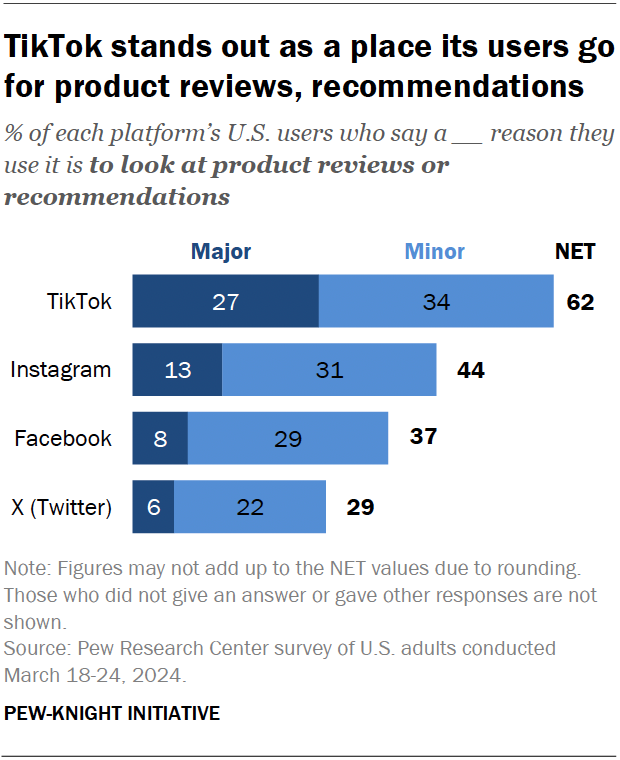
A majority of U.S. adults who use TikTok (62%) say a reason they use the site is to look at product reviews or recommendations. This includes roughly a quarter who say it’s a major reason.
By comparison, fewer users of Instagram (44%), Facebook (37%) or X (29%) say they use each platform for product recommendations.
Young women stand out in use of TikTok for product reviews
Brands engage with TikTok users in many ways, whether through online ads or by sponsoring influencers to talk about their latest product. And as discussions about a nationwide ban on TikTok continue, critics of that proposal argue it could wipe out a multibillion-dollar creator market .
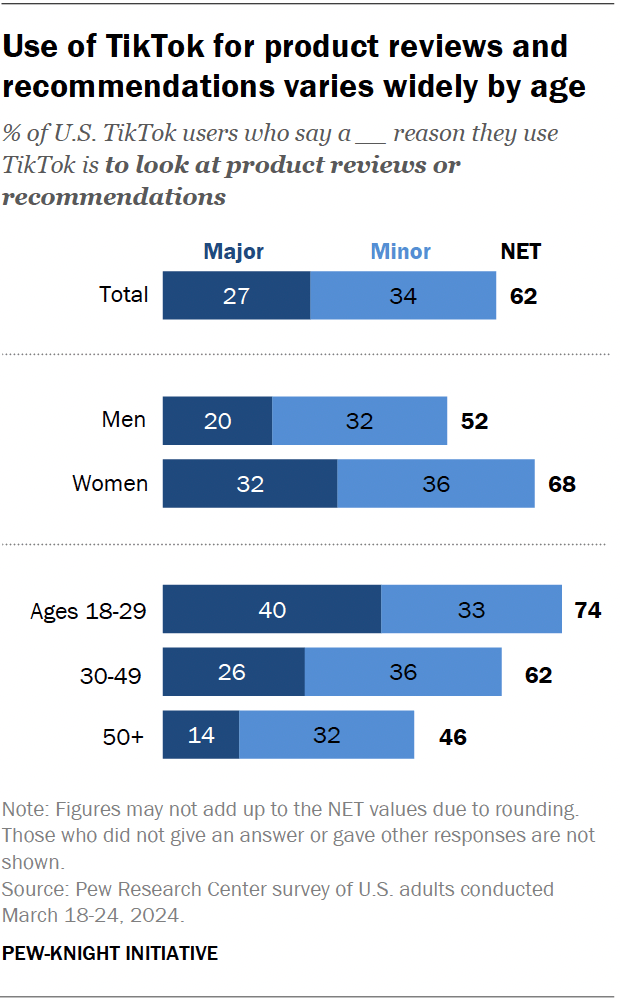
Younger users – especially young women – are particularly likely to use the site for product reviews.
Roughly three-quarters of U.S. TikTok users ages 18 to 29 (74%) say this is a reason they use it. This share drops to 62% among users ages 30 to 49 and 46% among those 50 and older.
Women who use TikTok are more likely than men to say they use it for product recommendations (68% vs. 52%). And the youngest women are especially likely to use it for this reason:
- 74% of female TikTok users ages 18 to 49 cite product reviews as a reason they use the site. This includes roughly four-in-ten (37%) who say it’s a major reason.
- Women ages 18 to 29 on TikTok are especially likely to say they use the site for this reason; 83% say so.
- 49% of women ages 50 and older on TikTok say they use the platform for product reviews.
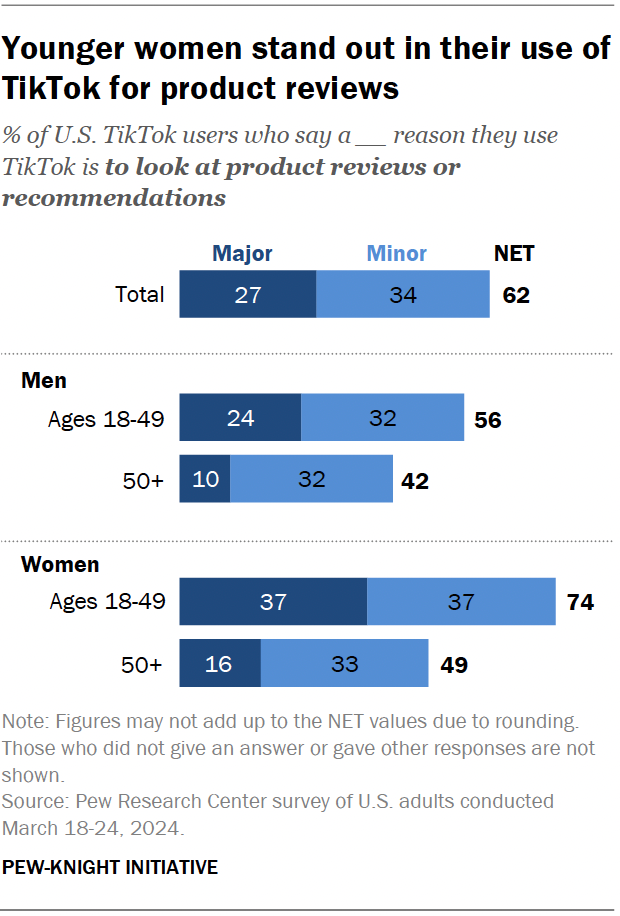
There is a similar pattern across age groups among men who use the platform. Men ages 18 to 49 on TikTok are more likely than men ages 50 and older to use the platform for product reviews (56% vs. 42%).
There are no differences by gender in the shares of those 50 and older who say it’s a reason.
This Pew Research Center analysis is from the Pew-Knight Initiative, a research program funded jointly by The Pew Charitable Trusts and the John S. and James L. Knight Foundation.
Note: Here are the questions used for this analysis , along with responses, and the survey methodology .
- How Americans Navigate Politics on TikTok, X, Facebook and Instagram
- Support for US TikTok ban declines, and half of adults doubt it will happen
- For shopping, Americans turn to mobile phones while influencers become a factor
- Online Services
- Social Media

Michelle Faverio is a research analyst focusing on internet and technology research at Pew Research Center .
Majority of Americans aren’t confident in the safety and reliability of cryptocurrency
Online shopping has grown rapidly in u.s., but most sales are still in stores, on alternative social media sites, many prominent accounts seek financial support from audiences, for shopping, phones are common and influencers have become a factor – especially for young adults, payment apps like venmo and cash app bring convenience – and security concerns – to some users, most popular.
901 E St. NW, Suite 300 Washington, DC 20004 USA (+1) 202-419-4300 | Main (+1) 202-857-8562 | Fax (+1) 202-419-4372 | Media Inquiries
Research Topics
- Email Newsletters
ABOUT PEW RESEARCH CENTER Pew Research Center is a nonpartisan, nonadvocacy fact tank that informs the public about the issues, attitudes and trends shaping the world. It does not take policy positions. The Center conducts public opinion polling, demographic research, computational social science research and other data-driven research. Pew Research Center is a subsidiary of The Pew Charitable Trusts , its primary funder.
© 2024 Pew Research Center

IMAGES
COMMENTS
Unlike focus groups or interviews, market research surveys allow you to get detailed feedback at scale — from behaviors to overall experiences — and in a standardized format. Also, as the data is easy to process, you can quickly turn it into actionable insights.
Unlike focus groups or interviews, market research surveys allow you to get detailed feedback at scale — from behaviors to overall experiences — and in a standardized format. Also, as the data is easy to process, you can quickly turn it into actionable insights.
Market research surveys are intuitive and easy-to-use tools to gather information from your target markets. Whether you’re a Fortune 500 company or a small startup, you can use market research surveys to better understand your target audience.
Market research surveys help you understand your target market, gathering data necessary to make informed decisions on content creation, product development, and more. What are the components of a market research survey?
Sep 28, 2023 · A market research survey is a questionnaire designed to collect key information about a company's target market and audience that will help guide business decisions about products and services, branding angles, and advertising campaigns.
Aug 9, 2024 · Market research surveys can help you identify market trends and steer ahead of your peers. By understanding what’s popular and what’s not, you can adjust your products and services to cater to the changing needs of your target audience.
May 31, 2024 · Companies use market research surveys to get a better understanding of what their customers want and need. Through marketing survey questions, they can assess the current demand in the market, and measure customer satisfaction with existing products and services.
Market research surveys are questionnaires that collect responses from a target audience of consumers. A brand uses market research to identify pain points, preferences, and interests of their customers. A market research survey seeks to understand patterns in a given market.
Jun 28, 2022 · Market research surveys are an ideal way to measure and obtain feedback about customer satisfaction; they’re often referred of CSAT (Customer Satisfaction) surveys, indicating what consumers like and dislike. They also allow organizations to keep track of their Net Promotor Score (NPS).
Market research surveys are powerful tools that help companies better understand current and potential customers. This information can be used to make business decisions based on facts and data —not flimsy gut feelings. But how, exactly, do you go about conducting market research surveys? We answer this question and more below.
Market research surveys are surveys that businesses and organizations use to gather information about their target market, industry trends, and consumer behavior. These surveys can be conducted through various methods, such as phone surveys, online surveys, or in-person interviews.
Whether you’re hoping to measure brand awareness, test a product/concept, or understand your target market better, we have a variety of market research survey templates you can customize to your industry.
Jun 10, 2022 · In this article, we will explore the different types of surveys and give examples of each type. What is a market research survey, and why is it important? A market research survey is a questionnaire tool used by companies to understand the needs and wants of their customers.
Oct 30, 2023 · Market research surveys are used to map out markets and the customers within them, determine target markets, reposition brands within the markets that they’re already in, or simply just reaffirm that the products are in the best positions and that the brand is perceived in the right way.
Nov 7, 2022 · A market research survey is a method for conducting qualitative research to gather opinions from your target audience. It offers valuable insights to understand your customers better and help in decision-making.
Jul 22, 2024 · There are a variety of market research surveys that you can leverage to collect useful information and make data-driven decisions when it comes to improving your products and offering seamless experiences. We’ll be discussing the six of the best.
Jul 31, 2022 · These surveys allow businesses to understand market needs and preferences. Your company can offer better products or services by understanding your target market. Often, market research surveys will also include questions about competitors. Competitor data help paint the complete picture of your target market.
Aug 8, 2022 · Market research surveys are a type of survey used to gather information about a particular market. This type of survey is often used by businesses to understand customer needs and preferences, track market trends and identify potential areas for growth.
Learn how to use marketing surveys to gather insights from customers and inform your marketing strategies. A marketing survey is a type of market research used to gather data and insights from a target audience about their preferences, behaviors, and opinions.
Aug 10, 2020 · One of the many ways to gather information about customers is through a market research survey. A market research survey, thus, is an affordable and reliable way for organizations to collect useful information from prospective consumers and target markets.
Market survey is the analysis of the market for a particular product/service which includes the investigation into customer inclinations. The purpose of market surveys is to directly communicate with members of the target audience to understand their characteristics, expectations, and requirements.
15 hours ago · From academic studies to market research, the use cases for survey platforms are extensive and adaptable. Researchers can gather insights through customer feedback, employee satisfaction evaluations, and participant demographic studies, providing a holistic view of the subject at hand. ... Market Research: Companies often deploy surveys to ...
1 day ago · Market Research Transform qualitative data into meaningful insights that inform better decision-making and drive innovation. ... From survey platforms to data analytics software, each tool provides unique features that facilitate better data interpretation. The right combination of these tools empowers businesses to uncover valuable insights ...
1 day ago · A market research dashboard is a vital tool that consolidates data from various sources to reveal insights on market trends, consumer behavior, and competition. It acts as a central hub for marketers and researchers to monitor key metrics, assess campaign effectiveness, and make strategic decisions. ... and surveys. This automation saves time ...
Nov 21, 2024 · Here are the questions used for this analysis and the survey methodology. This is a Pew Research Center analysis from the Pew-Knight Initiative, a research program funded jointly by The Pew Charitable Trusts and the John S. and James L. Knight Foundation. ... critics of that proposal argue it could wipe out a multibillion-dollar creator market ...